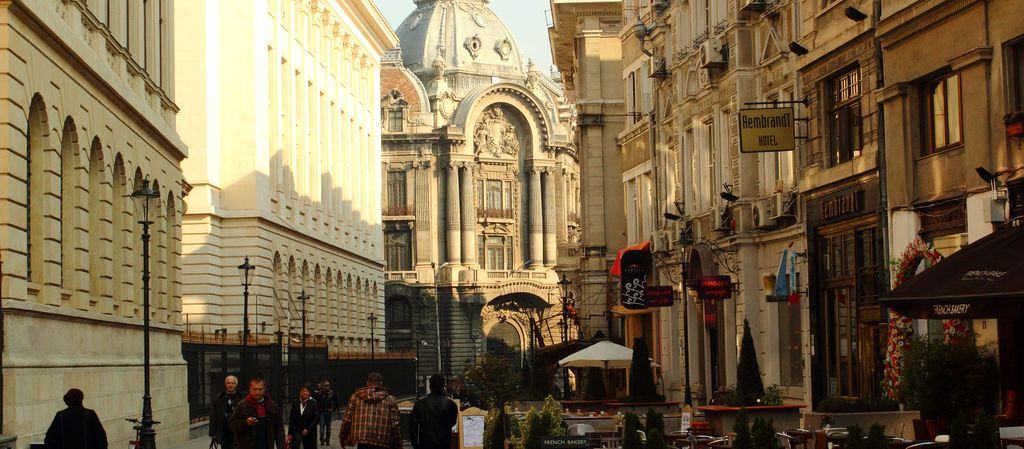

A practical, up-to date travel guide
2024 travel guide for first time visitors in romania.
If you're planning to visit Romania in 2024 for the first time (or returning!) and are looking for a complete, up to date travel guide with essential advice and practical Romania travel tips to plan your holiday - this article is for you.
As locals we'll tell you the most important things to know about visiting Romania, up to date info about our country and the best way to plan an amazing holiday here! But first - is Romania worth visiting?
In short - YES! For the long answer - in this post we've linked to many of our articles about Romania's tourist attractions, best things to do, natural beauty, local culture and traditions.
So if you need help with planning your trip don't hesitate to contact us - that's what we're here for! We have a network of 50 best guides all over the country and created authentic Romanian experiences and trips you won't find anywhere else :)
This travel guide was last updated in January 2024. So, let's get started:
Table of contents
Quick facts about Romania
- 1. Entry requirements & visa
2. Romanian currency, exchange houses and card payments
3. is romania cheap to visit tourist budget and holiday costs, 4. romanian geography and natural attractions, 5. getting here. public transportation in romania, 6. weather. best time to visit romania, 7. medical emergencies, 8. is romania safe to visit, 9. where to stay in romania. hotels and guesthouses, 10. romanian people and society, 11. romania travel tips no one will tell you about, 12. romania means much more than dracula castle..., 13. open your mind and heart to romanian people.
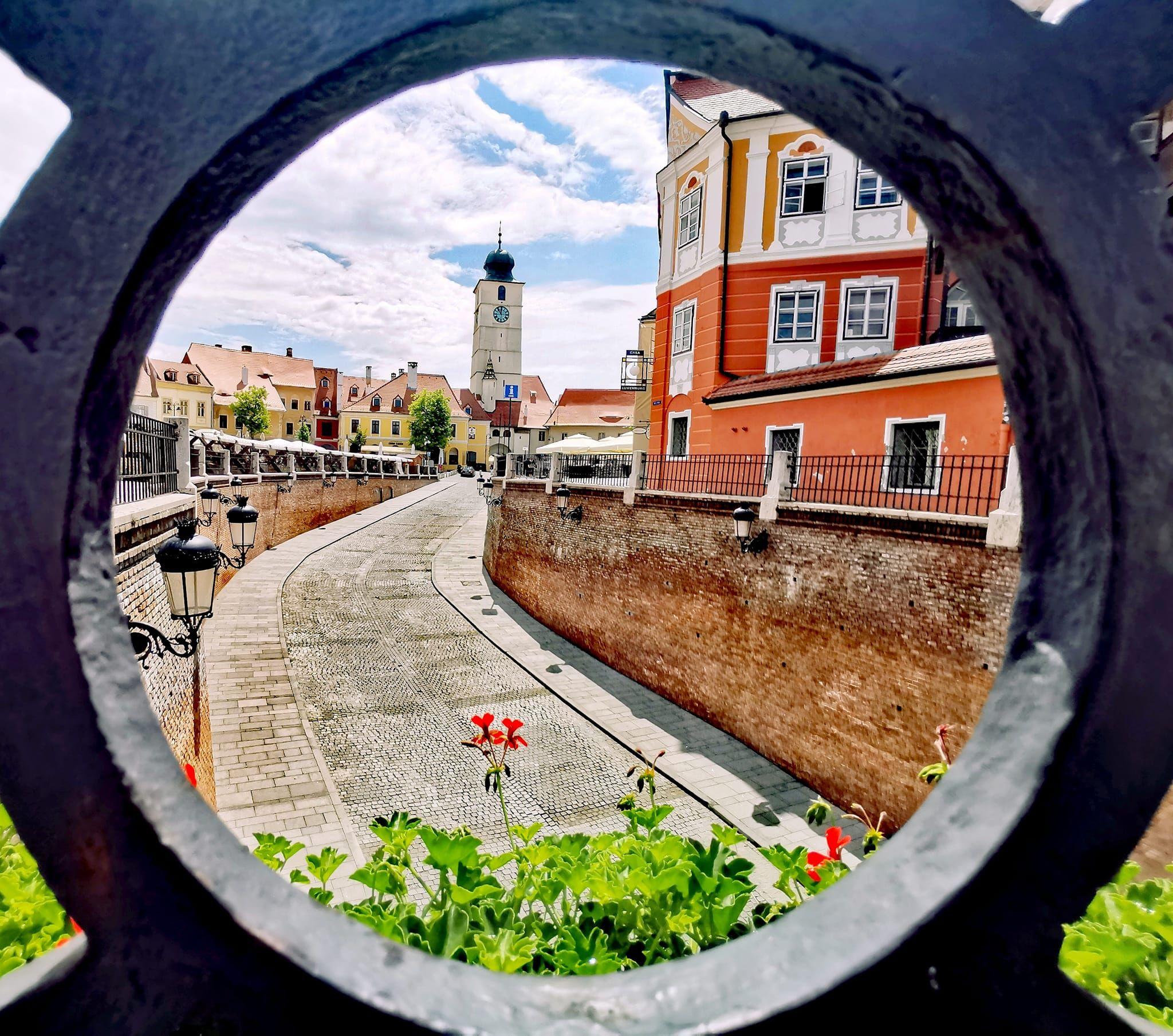
The Lower Town of Sibiu
Located in Eastern Europe, Romania is the 9th largest European country by surface with a very rich and diverse geography as you'll soon find out. It ranks 6th by population (approx. 19 mil) composed of 85% Romanians and other ethnic minorities such as Hungarians, Germans, Italian, Turks or rroma.
Romania is a NATO member since 2004 and part of the European Union since 2007. The local time in Romania is Eastern European Time (EET) +02:00 GMT
Our country is made up of 3 historical regions: Wallachia (South), Transylvania (North-West) and Moldova (North-East). The capital of Romania is Bucharest with approx. 2,2 mil. The next major cities are Cluj-Napoca and Iasi, the unofficial capitals of Transylvania and Moldova.
There are many reasons why it's worth visiting Romania. Main attractions and tourist destinations include:
- lots of famous castles starting with the famous Bran Castle, Corvin Castle or the ex-royal residence Peles Castle built by King Carol I, and 140 more!
- interesting UNESCO World Heritage sites: the 400-year old Wooden Churches of Maramures, the 500-year old Painted Monasteries of Bucovina, the 700-year old Sighisoara Citadel or the 2,000 year old ruins of Dacian Fortresses
- incredible nature with great hiking opportunities in the wild Carpathian Mountains which earned our country the title of Europe's last wilderness reserve or relaxation at the sandy beaches of the Black Sea coast
- eclectic sights mixing communist landmarks such as the huge Palace of Parliament ) with historic sites and medieval cities such as Brasov, Sibiu and Targu Mures in the center of the country
- unique sights such as the impressive underground Turda Salt Mine , the haunted Hoia Baciu forest or the thrilling Transfagarasan Highway
- the miracle that is the Danube Delta - 3rd best preserved biosphere in the world and home to over 300 species of birds
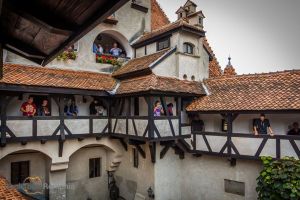
Top attractions in Romania Tours
View this post on Instagram A post shared by Romanian Friend (@romanian_friend)
- the famous South-East Transylvania with its main attractions: Saxon villages and fortified churches, castles, medieval towns
- the traditional Maramures region (upper North-West) with its Wooden Churches and folk costumes
- the spiritual Bucovina region (upper North-East) with its 500-year-old Painted Churches and egg-painting traditions
If you want an authentic experience of Romanian countryside you'll need at least 2 full days in any of these regions and to travel by car.
Romanian history is like Game of Thrones but without the fantasy part: at the intersection of Ottoman, Austro-Hungarian and Russian (later Soviet) empires, our history is full of twists and turns in the middle ages. We were always caught between the wars, domination and power plays of foreign power (hence the many castles in Romania and historical sites!).
Our history is a testimony of our nation's resilience, cultural identity and goal to unite the three historical regions into one independent state which happened only in 1918.
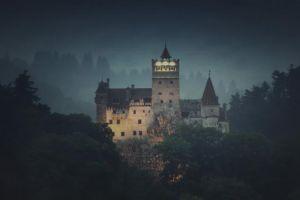
Castles, Fortresses & Historic Tours
As for Romanian culture and people, you'll see Romanians are very friendly and hospitable who love enjoying life, food and socialising. Our Latin blood and cultural affinity for Western Europe lifestyle mixes with a Balkan vibe and Eastern traditional values inspired by our Christian Orthodox religion. The best Romanian movies do a great job of showing this.
Although there are some prejudices and misconceptions about our country and people, those who've visited our country were pleasantly surprised and impressed by what it can offer - and we hope you'll be too! And if you're wondering who are some famous people from Romania - you might be surprised!
Now, on to the practical stuff with things to know and the latest information about visiting Romania:
1. Entry requirements & visa
Entering Romania is quite easy as visa requirements for tourism or short stays under 90 days are relaxed. On the Ministry of Foreign Affairs website you'll find lists of countries for which a visa is or not required.
Besides having a valid passport (or ID if you're from the European Union), for other travel documents needed also check the conditions of entry .
Besides European Union nationals, citizens from the United States, United Kingdom, Canada, Israel, Australia Singapore, don't need a visa when they enter Romania if planning to stay under 90 days. Make sure to double check entry requirements on your own too.
Holders of a Schengen visa with multiple entries (and slots still available and valid!) are not required to apply for a Romanian visa for entry.
You can apply for a visa online on the Ministry's (only) official website .
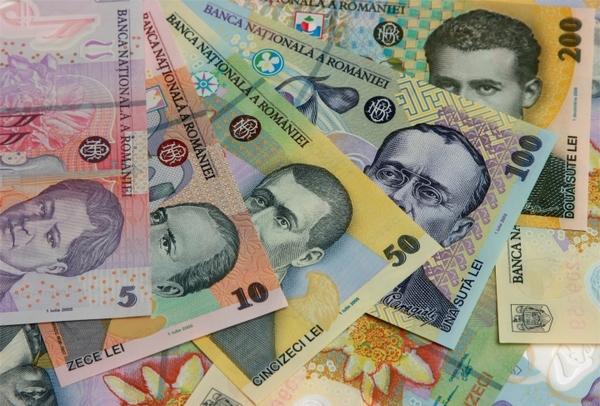
The Romanian currency is RON or informally called Lei. It comes in plastic, almost indestructible notes of 5, 10, 50, 100, 200 and 500. There are also some smaller-don’t-matter coins.
Although some prices in Romania may be displayed in Euro using Euros for cash payments is NOT accepted and if someone offers you an ‘in-house’ exchange rate - you should check official rates before accepting.
- 1 Euro is about 5 Lei and 1 USD is about 4,6 Lei - check official exchange rates published by the Romanian National Bank here )
Paying by card is very safe and widespread in Romania in all shops, restaurants, hotels or tourist attractions. But not in taxis, farmers market or artisan fares where you need to have cash. Debit cards issued by VISA, MasterCard and Maestro are widely accepted everywhere, but American Express cards may not always work. If you're using credit cards from a non-EU bank, make sure it's authorised for international payments.
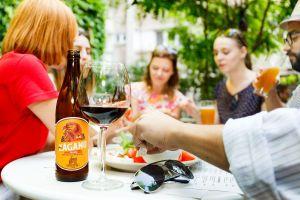
Bucharest Street Food Tour: Farmers' Markets & Hidden Streets
Start from: University Square
When travelling in the country or in the mountains cash is king so always have Lei with you and plan your budget ahead. Some guesthouses or restaurants in the countryside don't accept card payments, especially credit cards, so ask in advance.
There are plenty of ATMs in Romania (bancomat) to withdraw money from. The most common banks with safe & secure ATMs are BCR, BRD or Banca Transilvania. For fees, check with your local bank. In the countryside or mountainous areas it's harder to find ATMs but every village or small town should have one near the city hall.
What currency to bring when travelling to Romania: Euros, US dollars, UK pounds or Swiss francs are the easiest to convert anywhere. When you arrive don’t use exchange offices located in airports for more than 20 € / $ / £ for taxi fare as they usually have very bad rates aimed at unsuspecting tourists. You'll find lots of exchange bureaus (casa de schimb) in Romania, easily recognisable by their yellow or white street boards indicating rates offered.
- Pro tip: rates at exchange bureaus are usually better than at banks and 90% of them don't charge any fees
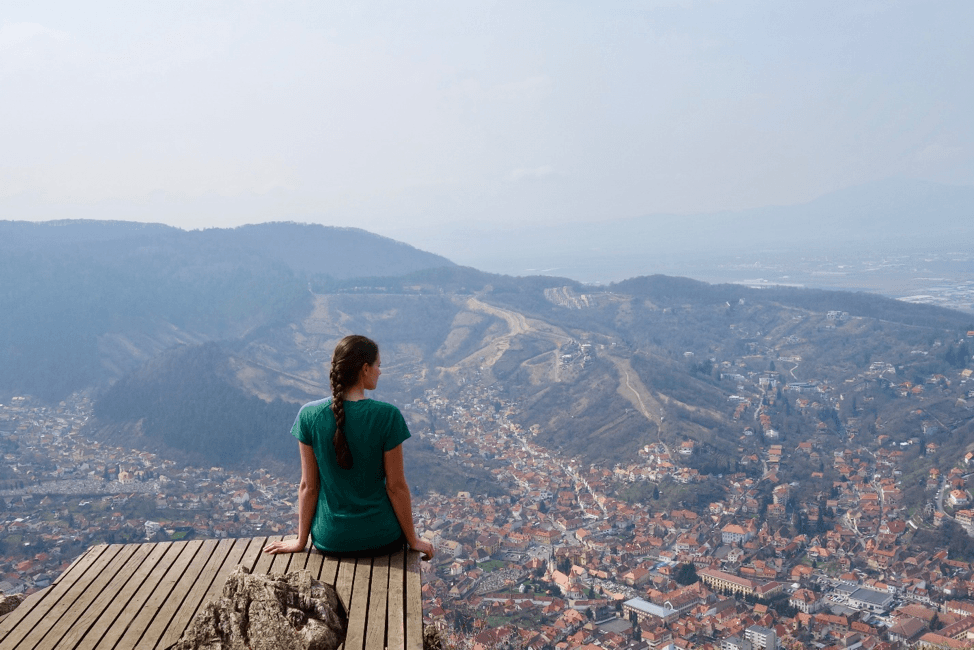
View over Brasov, one of the best preserved medieval towns
Up until 2020, Romania used to be known as a cheap destination but this changed in the last 3 years... why?
The hospitality and tourist sector were strongly affected after two hard years of Covid-19 and a low 2022 caused by the invasion of Ukraine war-scare.
Many guides had to get regular jobs while small operators and guesthouses lowered their value-for-money ratio and/or closed shop. Meanwhile, the 'surviving' businesses and guides raised their prices to keep up with demand and rising costs.
- We have a network of 50+ guides and partners all over the country, so we witnessed the disaster firsthand while trying to stay alive. Since 2017 our mission has been to support local communities by including their services in our tours. So if you book a tour with us you'll directly help small businesses and people in Romania!
The wider European economic context (energy crisis, inflation) coupled with higher local taxes meant everything got more expensive in Romania by 20-30%.
The good news (ironically!) is prices increased all over Europe - and the world too, since the global economy is not doing great. So on a relative scale Romania is still cheaper to visit compared with most European countries if you plan your holiday well or go off-the-beaten path. Key info:
- generally, the value-for-money you get in Romania for tourist activities (e.g. guided tours, wine tastings, fine dining, SPA etc) is very good
- prices in major cities where the main attractions for tourists are ( Bucharest , Cluj-Napoca , Brasov and Sibiu ) or on the Black Sea Coast are higher compared to other ones, but on the flipside they have lots of choices for every budget, so shop around!
- in small towns and villages, prices for meals and accommodation are on average 20-30% lower
A reasonable budget per day if you're planning to travel to Romania is between 30-60 Euro for accommodation, meals and small expenses. In restaurants a main course is around 25-50 Lei (5-10 Euro), soups around 10-20 Lei (2-4 Euro), soft drinks start from 1,5 Euro while alcohol from 2 Euro. Entrance fees to tourist attractions range between 4-15 Euro
For a better idea of how expensive Romania is, for a 3-day city break in Bucharest or Cluj-Napoca budget around 200 - 350 Euro in total for 2 people (excl. flights and guided tours) with generous meals and drinks included, tickets and local transport. A 7-day guided tour starts from 2,000 Euro per person for 2 people, depending on hotels, activities and itinerary.
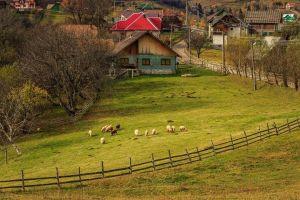
3-Day BEST of Transylvania Tour: Brasov, Sighisoara, Bran & Viscri
Start from: Bucharest
Tipping in Romania is very common and usually expected. Service fees or coperto is not included when going out in restaurants (unless expressly mentioned!) and a 7-10% tip on top of the bill is common. If you’re really happy with the service you can go up to 15%.
Tips for small, personal services (body care & cosmetics, hotel concierge, drivers, etc.) are also welcomed. Tipping tour guides is also common on average 10-15% of the tour price. And if the guide doesn't say anything (because they're usually uncomfortable asking!) - just do what feels right to you.
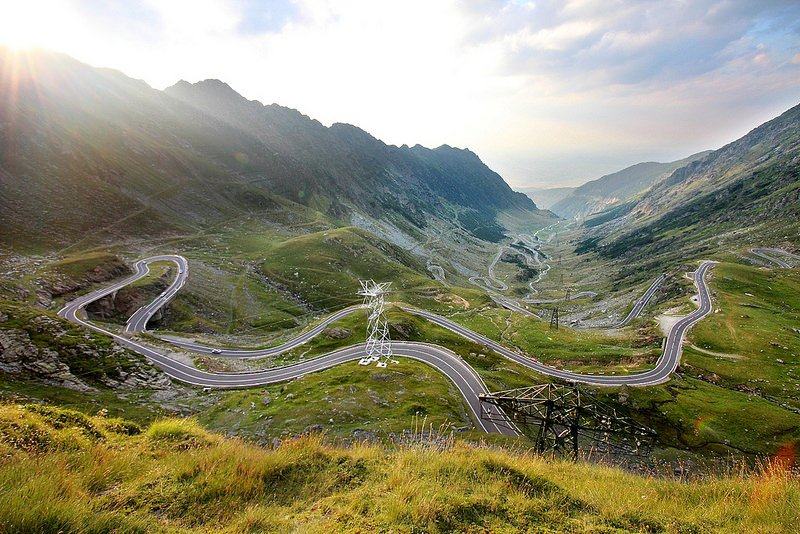
This is Transfagarasan Road one of Romania's top attractions
Romania has been blessed with a rich and diverse geography with lots of natural attractions which makes it one of the most beautiful countries:
- the Black Sea coast with fine sandy beaches
- the Danube River creates the Danube Delta with vast waterways and lakes
- picturesque hills and old-growth forests in Transylvania
- the wild, impressive Carpathian Mountains (also known as Transylvanian Alps)
Check our selection of hiking tours with licensed guides
Going as high as 2,544m (at Moldoveanu, the highest peak) the Romanian Carpathians and their foothills take up almost 45% of our land surface.
With over 100 peaks over 2.300m altitude, lots of trails for all difficulty levels offering incredible natural landscapes and a wildlife population that earned us the title of Europe's last wilderness reserve - this is a great place for your next hiking holiday. Our article on best hiking trails in Romania will tell you more.
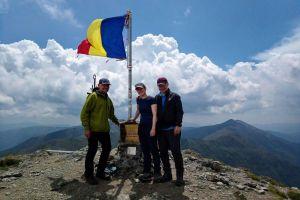
7-Day Peaks of Romania [Shared Group Trip]
Start from: Brasov
In terms of natural attractions, besides the many national parks (Piatra Craiului, Bucegi, Apuseni being the most famous), I would also mention the Muddy Volcanoes , the Romanian Sphinx or the 7 stairs canyon.
The simplest and most convenient way to travel to Romania is to fly here. Besides the main airport (Bucharest Otopeni), there are 9 airports in big cities served by low cost airlines (Wizz Air and Ryan Air mostly) with flights to over 100 destinations in Europe. This is because there are close to 4 million Romanians living abroad so there's a lot of commuting. If you plan well and in advance, you can find tickets as cheap as 60 Euro round-trip.
- Local tip: check our guide on Bucharest airport so you have a 'soft landing' here :)
Besides a Southeastern Europe and Romania road trip, you can also get here using direct trains from Vienna, Budapest, Belgrade, Sofia or Thessaloniki. We prepared an article on travelling to Romania with additional information on this topic.
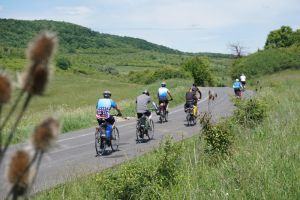
2-Day Transylvania Bike Trails Tour: Viscri & Saxon Villages
Public transport in Romania is a little more challenging. Unfortunately road and railway infrastructure is underdeveloped. There are few highways and mostly one-lane roads which are heavy with traffic (including trucks) so driving 100 km by car can take 2h. And though there are lots of train stations in the whole country, because tracks are old trains go slow (average of 80 km/h). At least they're cheap!
For short distances (>200 km) a car, train or bus is a good choice. For medium or long distances (over 300 km) you should consider breaking your itinerary or catching an internal flight (eg. from Bucharest to Cluj or Timisoara). Visitors to Romania are well advised to have travel insurance before getting here. Our guide on public transportation in Romania will have more info on this.
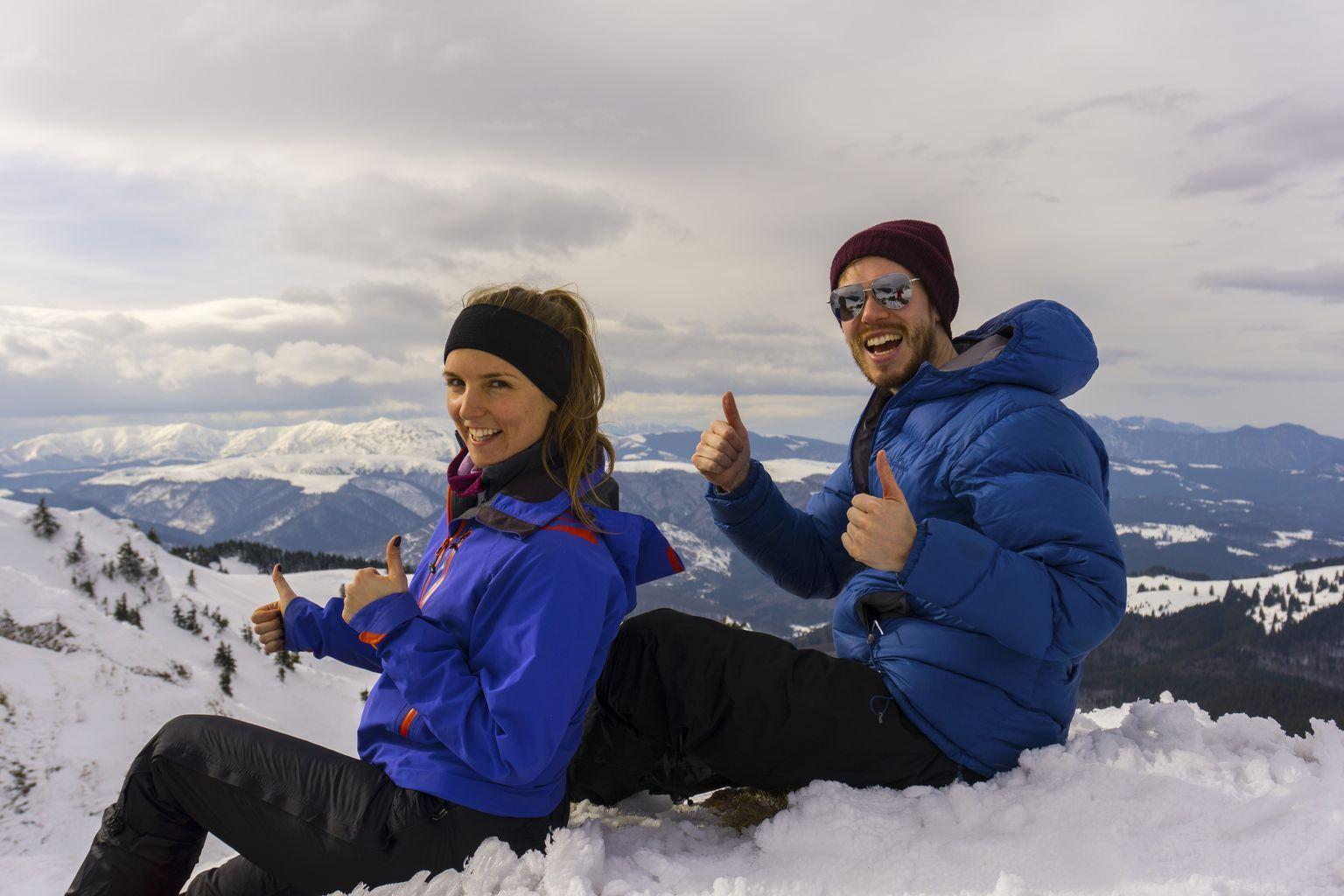
Romania has a temperate continental climate which used to be codename for standard weather. But in the last 10 years the effects of climate change are starting to show. We wrote a bigger article on the best time to visit Romania describing the weather and with visiting tips for each season.
In short, for sightseeing trips come anytime April - October when the weather is fair, warm and days are longer. Peak season for holidays is 1 Aug - 15 September so if you're planning to travel to Romania then, make sure to book everything in advance!
The best time to go hiking and for outdoor activities in general is from late Spring to mid October but this depends on where you're going. For example, in mountains at altitudes of over 2,000m (eg. Fagaras, Retezat or Bucegi) there can still be snow until late June and weather is unpredictable. High season for hiking is Aug-Sept when there's less rain and fair weather.
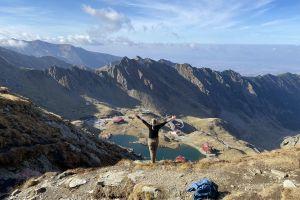
Transfagarasan Road & Hiking Day Trip in Fagaras Mts
For wildlife tours - we follow nature's rhythm. Animals - especially brown bears - are active from late Spring to late Autumn, depending on how warm and cold it is. The best time to visit with the highest chances of seeing wild animals is during Summer, but these trips usually have complex logistics, go into remote areas and are in high demand - so book them in advance!
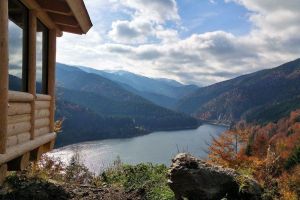
3-Day Hiking & Wildlife Trip at an Eco-Luxury Private Cabin in Fagaras Mts
Start from: Rucar, Arges county
- Local tip: our personal favorite time to visit Romania is Autumn: starting from early September a superb array of gold, orange and brown will cover the vast Carpathian woodlands
The best time to visit the Danube Delta is April - October when nature at its best: lush vegetation in full bloom, birds nesting or playing around and lots of fish.
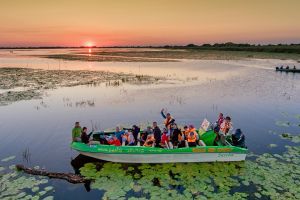
4-Day Danube Delta: Birds, Letea Village & Lakes [Group Trip]
Start from: Tulcea
Compared to other countries, the peak holiday season by the Black Sea Coast is shorter, typically from 15 July - 30 August. Winter in Romania is quite cold, but not humid. In mountainous areas there's lots of snowfall, but less so in the plains. The Romanian ski resorts come alive during the winter months of Jan-Feb but you can also take a cable car ride outside the season.
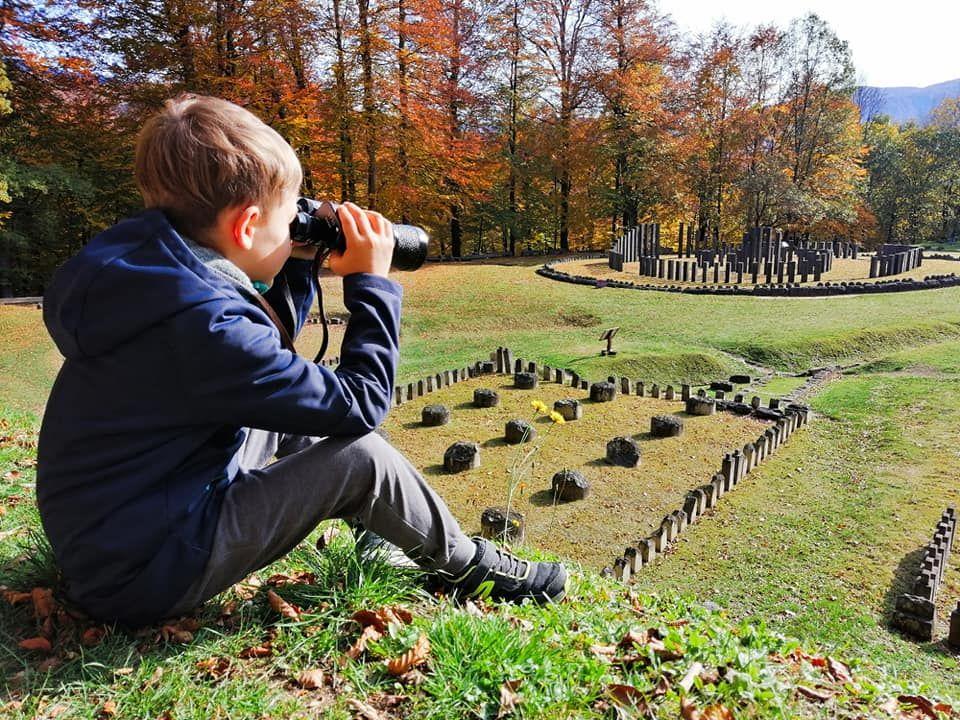
the UNESCO World Heritage site Ruins of Dacian Citadels
In Romania the emergency number is 112 and an operator will ask if you want to talk to the police, fire or medical services.
There are no particular health concerns you should be aware about. No special insects or food issues around here either. As vegetation is very diverse and rich, those with pollen allergies should be prepared.
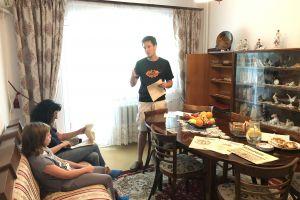
Museum of Communism: A Time-Capsule of Ordinary Lives
As regards medical services most hospitals are public and state-owned so they will take care of any walk-ins or emergencies - and settle insurance matters after. But you still need travel insurance, even if from a foreign issuer, whether you travel to Romania or anywhere else in the world.
Unfortunately healthcare in Romania is severely underdeveloped and understaffed so better lower your expectations of what a hospital should look like and how you should be treated. But medical staff is usually kind and will do their best to help you.
There are plenty of pharmacies in all urban areas and you can easily get the usual over-the-counter pills for colds, aches, indigestions or bruises.
Finally, we highly recommend you have a travel insurance. For citizens of the European Union countries, the European Health Insurance Card (EHIC) which offers health coverage EU-wide is a good option.
Is Romania a safe travel destination? Yes! There are NO terror attacks, violent protests or civil disturbances here. We have very strict firearm regulations - so no crazy people with guns either.
So is Romania safe for travellers? Yup, and even though you may have heard or read scary stories about traveling in the Balkans, just do what you normally do when in 'tourist mode:' don’t look for trouble, beware of pickpockets or suspicious people, ignore drunkards and people pushing their services to tourists (like taxi drivers in North Train Station), be careful at night and don't disrespect people, traditions or clearly stated rules.
This applies to female and solo travelers as well.
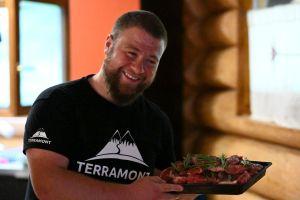
Cluj-Napoca Food Tour: Food Markets, Regional Dishes and Coffee Culture
Start from: Cluj-Napoca
We wrote an extensive article with Romania safety travel advice that will answer everything.
You may have heard stories about the rroma ethnic minority (improperly called gypsy) and how they're usually involved in small thefts, cons and begging. While their reputation might be bad, not all are like that. Most of the time you will see them as beggars, even using their children for money - but don't get fooled and give them anything as you're only perpetuating the cycle and not really helping them.
On our tours in Transylvania we take people to typical Rroma villages to find out about their culture and lifestyle in an authentic way firsthand.
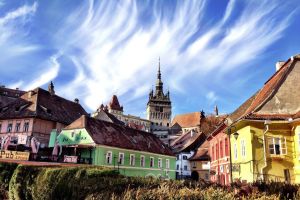
Tour of Transylvania's Countryside: Sighisoara Citadel & Fortified Villages
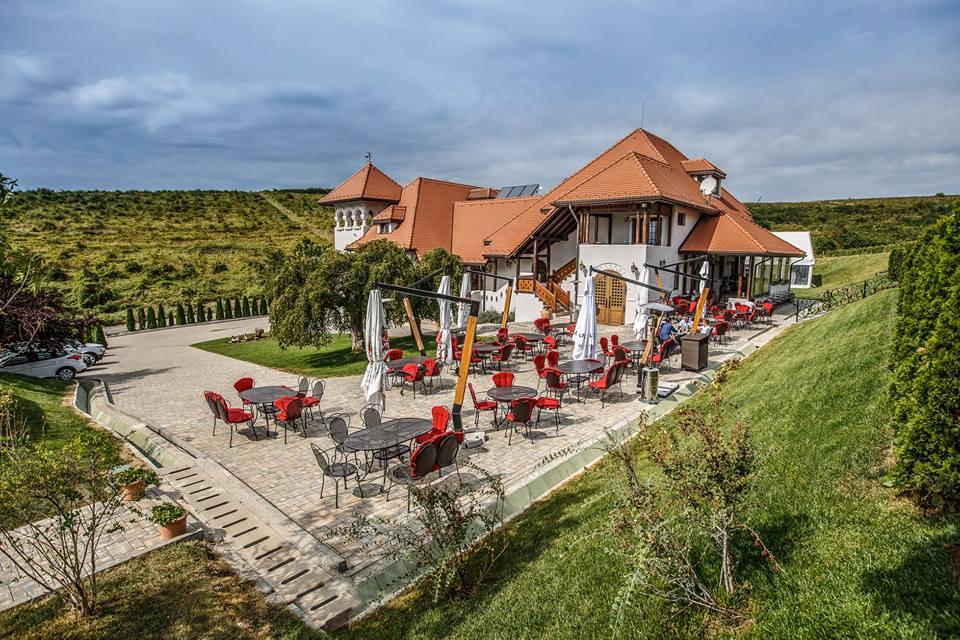
Romania offers lots of accommodation choices for all budgets, requirements or styles. All of them are listed on either Booking.com or AirBnB .
In the most visited cities you'll find a large selection of hostels, hotel rooms and boutique guesthouses. Lots of apart-hotels too. It's best to book them before you travel to Romania as walk-ins are rarely a good idea.
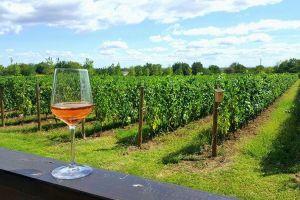
The Wine Tradition of Romania: Premium Wine Tasting in Dealu Mare
The other tourist cities are not that big so even if you're not staying in the "old town" or "union square" area (usually the city centre and most crowded areas), it will probably be a 5-15 min walk away. Besides walking, I personally like to keep my healthy routines while traveling and found some easy travel workouts to do.
When visiting the traditional tourist regions of Romania (Transylvania, Maramures, Bukovina, Danube Delta) accommodation usually means a family-owned guesthouse offering bed and breakfast in a small village. These are called pensiune or casa - no hotels or restaurants here. Most of them offer a private rooms with en-suite WC and half board we suggest you take it since there are likely few alternatives to eat out. For hiking trips villages at the base of the mountains usually have lots of guesthouses. But sometimes the hiking trails begin a little further away so you'll need a car or guide to get there. When going deeper in the mountains you'll have at most 1-2 choices to stay in, usually mountain cabins or chalets. Romania's hiking infrastructure is not well developed and hut-to-hut hiking is not possible for this reason.
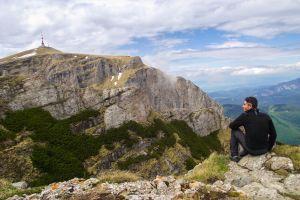
1 or 2 Day Hiking Trip in Bucegi Mountains: Sphinx, Babele, Omu Peak
Start from: Bucharest OR Brasov
Due to their very limited accommodation options and very high demand, we highly recommend you book your hiking trips in advance (min 2-3 weeks).
There are many good reasons to explore the Romanian countryside (the best place for culture trips), and here's another one: to stay in the many charming, authentic or luxury guesthouses. In recent years locals bought and restored old boyar (aristocrat) manors, traditional village houses (like King Charles did in Viscri), built modern eco-luxury villas, or converted large old farmhouses into agro-tourism cottages straight out of a fairy tale. See some inspiration here and make your trip to Romania memorable!
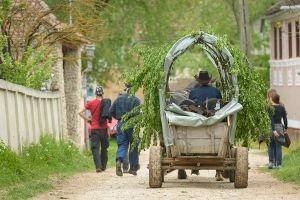
2-days of Agro-Tourism in Transylvania at a Local Farm
Start from: Cobor or Brasov
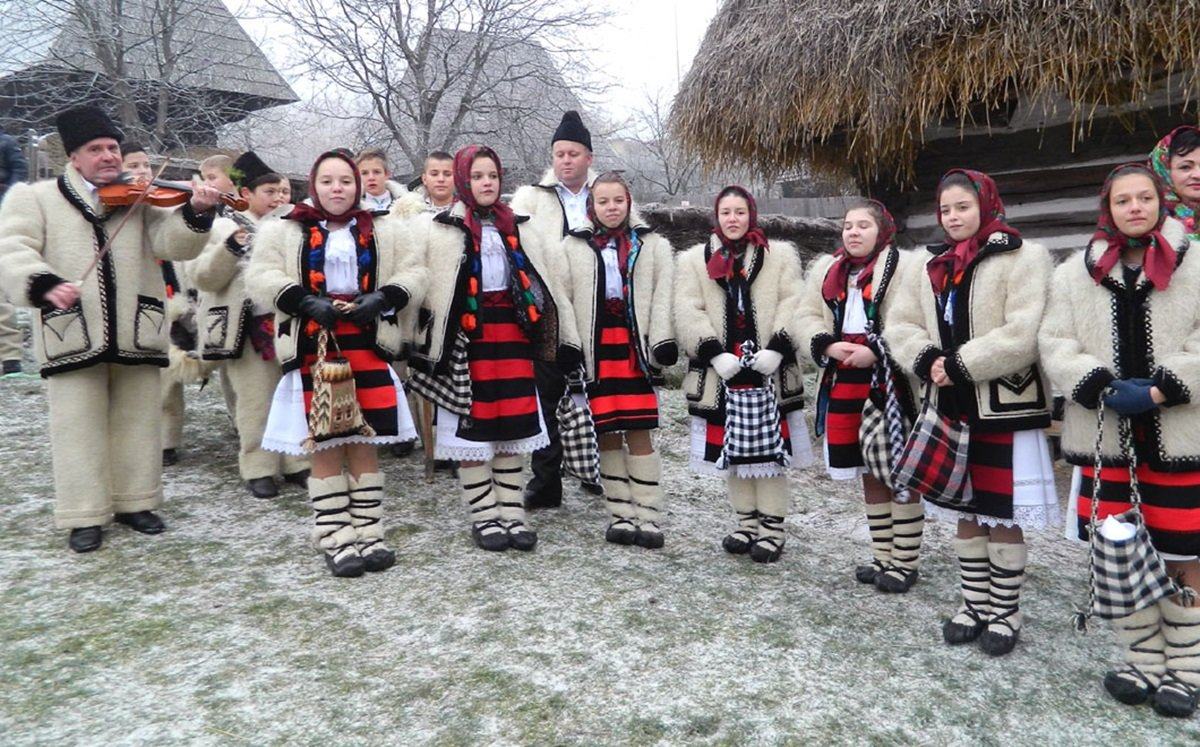
Traditional folk singers in Maramures
Romanian people and society is generally conservative and adheres to traditional values, especially older generations who grew up in the 45 years of Romanian communist regime .
Spending quality family time and having good relationships is important in our society. There are lots of destinations and facilities for this, which is why you should consider a holiday with the kids in Romania .
85% of the population is Christian Orthodox so major religious holidays like Easter or Romanian Christmas are celebrated through public holidays (when all tourist attractions are closed by the way).
Religion plays an important role in our society, especially in rural areas where people dress up and go to church every Sunday. There are lots of historic churches valuable for small communities where priests enjoy great influence. But beyond their religious function, Romanian churches are worth visiting because they are a unique place to discover authentic Romanian culture and folk traditions. Romanians, though being the majority of population in these parts, were historically persecuted (especially in Transylvania) for our faith, language and culture by foreign rulers. So churches were the only safe havens and community spaces Romanians had.
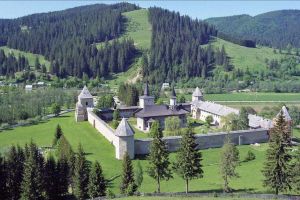
5-Day Complete Tour of Traditional Maramures & Bucovina
But Millennials and younger generations are very liberal, open-minded, friendly, tech-savvy and influenced by Western lifestyle and values. Most, if not all, young people speak English, are very eager to help foreign visitors have a good time in Romania and will quickly teach you Romanian words to get around.
- Pro tip: Romanians like to complain about politics, the economy and time in traffic, and love talking about sports, Romanian food and where to go when traveling to Romania – so pick any of these topics to start a conversation :)
Go on a brown bear watching tour in Transylvania
As a frequent traveler myself, I spend A LOT of time doing online research to see what are the most popular places to visit and interesting things to do in a new place. I compare tours, prices, check public transportation, read forums, travel blogs, Instagram - the usual!
But this becomes confusing and stressful when planning to visit Romania because of outdated, incomplete or vague info. There's no official travel portal or assistance from Romanian tourist authorities. Tour operators compete on prices on Viator and similar websites - not on value or authentic experiences.
That's why I started this website in 2017 and partnered with the best and friendliest people. We want you to have a great experience and a memorable holiday when you travel to Romania and here's our advice on how to do that:
- first, read about the major tourist cities , best places to visit and things to do in Romania and make a list with "must see" and "nice to see"
- second, look at the map of Romania to see where they're located and understand the logistics and limitations of getting around Romania and on Google Maps
- third, decide the basics like how many days you have for your holiday, what's your budget and what are the best places to start or end your trip
- fourth, beware that most tourists who travel to Romania underestimate how big the country is and want to do / visit too much in too little time! For example, if you want to visit a traditional region like Maramures or Bucovina where tourist sights are spread in the surrounding areas, you'll need 2-3 days on top of the time needed to get there by car; the same if you want to visit the Danube Delta which can be done only by boat!
- finally, think about what kind of holiday do you want in Romania? to visit as much as you can and go from one place to another? to go hiking and see wildlife? to experience traditional village life through slow travel (the best way)? Romania has much to offer but because it's quite big and traveling is slow - you can't have it all!
Once you're clear on the above, here's how we can help you:
- a a do-it-yourself holiday: book places to stay on your own, use public transportation to get around and book day trips from different cities (more time + energy + hassle for you, but cheaper and we can give you a disccount)
- we prepare a fully guided private trip for you with as much as you want, within your budget, using our best guides, expertise and local connections (a couple of emails/calls with us, no stress for you, and an amazing value-for-money holiday)
- if you need help deciding or making a plan - we know everything about tourism in Romania and are happy to help - just contact us
Important: because Romania is such an underrated and undiscovered tourist destination, tourist numbers are very low so 90% of tours in Romania are private except for city tours and a few day trips to the main attractions such as Bran Castle, Peles Castle, Sighisoara Citadel or Transfagarasan Road. All our hiking tours are private too because we don't combine people with different hiking experience and fitness level.
In 2024 we run 2 shared, small-group tours with fixed departures in the Summer so check them out:
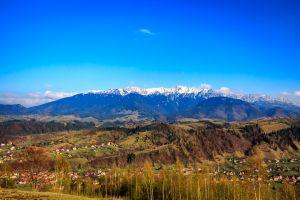
8-Day Exclusive Romanian Experience [Shared Group]
Romania is very popular thanks to Count Dracula touristy stories surrounding the famous Bran Castle known by its touristy name Dracula's Castle.
But there's so much more to do here other than visiting Bran Castle thanks to a fictional Hollywood character loosely connected to our history. Even though most tourists visit Romania looking for Dracula legends , once they're here, find out about the other main attractions and meet locals - surprise and wonder sets in!
The capital city Bucharest is a bustling city of contrasts. Though rough on the edges it is by far the most diverse and attractive for tourists. The main tourist cities of Brasov and Sibiu are famous for their Old Town with medieval architecture. But Cluj Napoca, Timisoara , Oradea or Iasi have their own stories to tell. But Romanian culture and spirit is best experienced when traveling in rural areas - perhaps on horse drawn carts . The ageing locals who preserved the traditional, authentic Romanian village life have done so by keeping a low profile, away from civilisation and busy "modern" life.
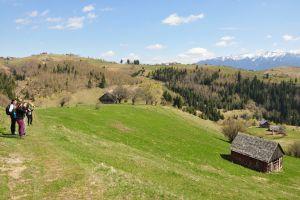
Day Trip to Traditional Mountain Villages: Magura & Pestera
The charm of Transylvania that made the UK's King Charles fall in love with Romania and buy village houses here can't be experienced on a touristy day trip from the capital to Brasov and Dracula Castle.
- `Local tip:`we created the first volunteer trip in Romania that combines tourist activities (hiking and wildlife watching) with hands-on environmental work at a typical rural farm, a tree nursery and for wildlife conservation. This will be a great experience for conscious travelers
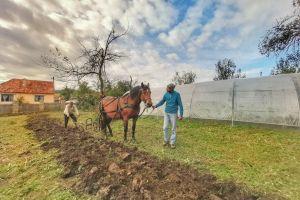
6-Day Volunteer Trip: Farm Life, Tree Nursery & Wildlife Conservation
You need to go deeper into rural areas with a tour guide who has the connections to show you around, meet locals, enjoy Romanian cuisine with home-grown food and experience their way of life firsthand. You need to slow down - which is rare in the fast-paced world of today - and a ride on horse-drawn carts will help with that :)
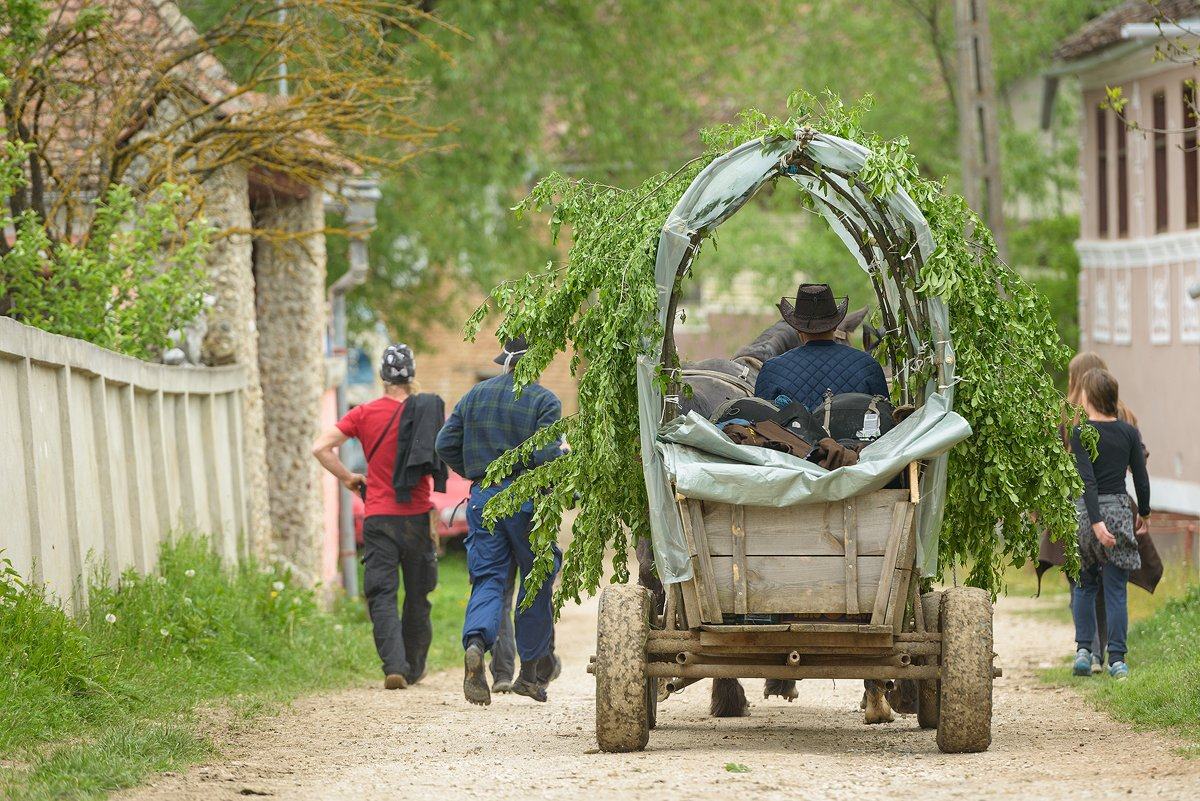
Transylvania Tours and Trips
Sadly, time is passing for our elders. Many Romanian villages have been abandoned and lost their ways since younger generations moved to larger cities. And if you add Romania's underdeveloped tourism and public transport infrastructure in the mix, then you'll see why our honest and friendly recommendation for the best way to experience Romania is to hire a local guide. Here are 3 reasons why:
- first, for a decent price you'll have less stress with planning and driving (not easy!), and you'll actually understand what you're visiting instead of just taking a picture! besides learning about our history and culture, our guides have connections to locals, lesser known places and sights you wouldn't be able to find on your own, especially in rural areas
- second, since 2017 we at Romanian Friend personally built a network of 50+ guides and partners all over the country; our guides are licensed and specialised in certain travel types (culture, hiking, wildlife, etc.) or regions, and deliver exceptional services so you get great value-for-money when visiting Romania; we've welcomed over 10,000 travelers on our tours and are proud of our reviews
- finally, we created tours that support responsible, inclusive and eco-friendly travel so if you travel to Romania and book with us, your visit will directly benefit local people and communities; this is our mission
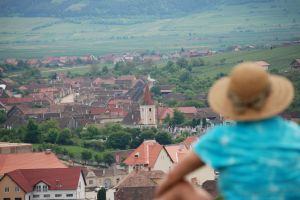
Day Trip: Village Life in Sibiu Countryside
Start from: Sibiu
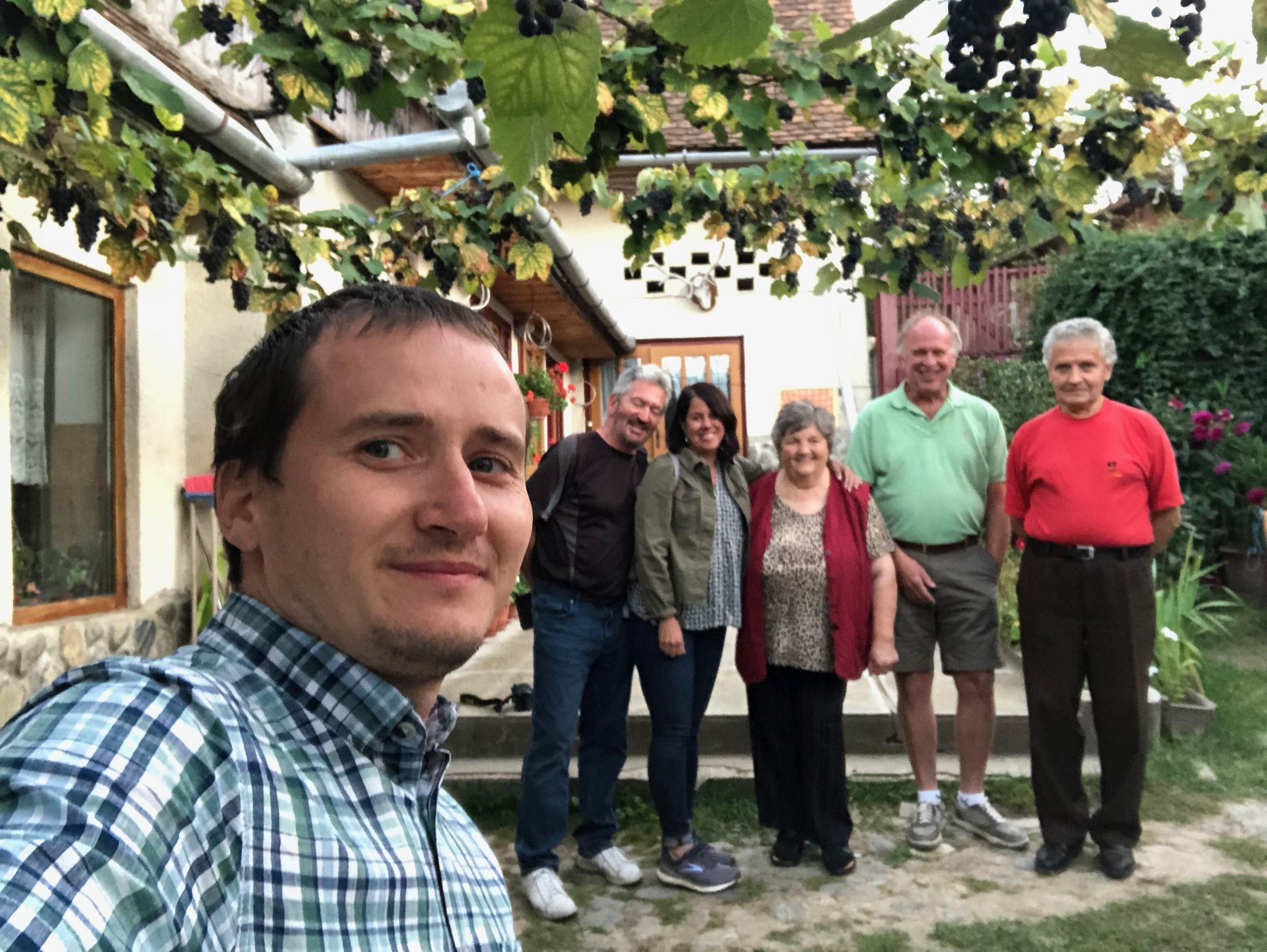
Our guides will organise home-hosted meals for you
Final tip: if you visit Romania, spend some time to get to know locals. Romanians are very hospitable, thoughtful and warm people. They enjoy having guests and will treat you like family, feed you till you drop (literally!), bring out their best wine or tuica and generally go out of their way to make sure you have a great time. In our guide to Romanian cuisine we explain how so much of our culture and social life is connected to food, hospitality and enjoying meals together.
But so much hospitality and friendliness towards strangers might seem too much at first, or even make you feel uncomfortable. But this is just how Romanians are and an integral part of our culture: family, friends and community play a big role in Romanian life - even if Bram Stoker never mentioned this in his Dracula novel! If you have the chance, go to any Romanian festival and you'll see what I mean :)
Abandon any pre-conceptions about Romania and open your heart and mind while you're here, explore the country and meet locals. Let them show you what a beautiful country we have. Despite the uncertainties of travel, Romania will still surprise you, I'm sure of it. Why?
Because I've heard this so many times from our clients: Wow, I never thought Romania has so much to offer!
So that's it - I hope this will make it easy for you to travel to Romania and have a memorable holiday! I started Romanian Friend as a one-stop-shop to promote my country and its people, so you'll find everything you need on this website.
And if there's something missing, you have a question or need help with planning - just contact us - happy to help!
Your Romanian Friend (and founder)
Check our tours
- By category

Local insights from Romania
4 times a year we prepare a newsletter with local stories, places and our special insights about Romanian culture and local life that will inspire you to visit our country and have an authentic local experience. Would you like to get it?
#romanianfriend
Cultural routes in Romania I am #HistoricallyCurious
We use cookies and Inspectlet. By using this website, you accept the use of cookies which helps us provide you more interesting and adapted content.
Journey through time and tradition
Those yearning for a vacation filled with unique experiences amidst breathtaking scenery and steeped in authentic traditions will find it all in Romania , the Carpathian Garden. Here, locals enrich these natural treasures with their unique culture, a vibrant mosaic woven from the threads of Dacian and Roman influences, Byzantine artistry and echoes of countless other cultures that have graced these lands.
Romania boasts a diverse UNESCO heritage encompassing tangible and intangible cultural treasures alongside wondrous natural wonders. A journey through these cultural gems might begin in the north, where Maramureș and Bucovina unveil their treasures: the intricate wooden churches and the awe-inspiring churches adorned with exterior frescoes, standing testaments to medieval architectural mastery. Continuing southward, delve into the heart of Transylvania, where Saxon fortified churches, the medieval citadel of Sighișoara, and ancient Dacian fortresses whisper tales of the past. Further south, in Oltenia, lies the Monastery of Hurezi, a symbol of the emblematic Brancovenesc architectural style.
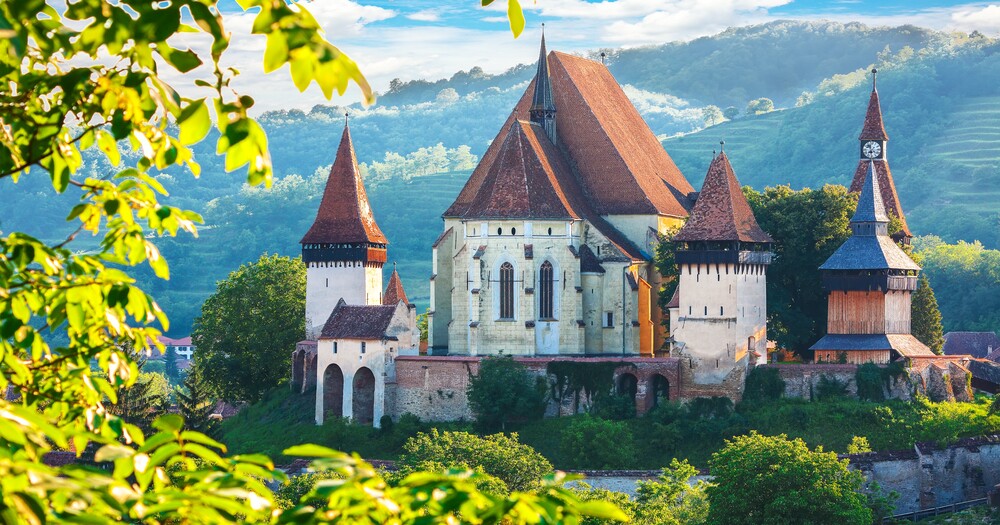
Explore the multitude of cultural routes that snake across Romania : 34 national routes, 70 regional routes, and 42 local routes, each offering a unique perspective on the country’s rich heritage. Furthermore, Romania proudly contributes to 12 Cultural Routes of the Council of Europe and five transnational cultural routes.
A noteworthy route is the Via Mariae, a Central European pilgrimage route that connects various sites dedicated to the Virgin Mary. In 2023, the segment within Suceava County received the second prize in the European Cultural Tourism Network (ECTN) – Destination of Sustainable Cultural Tourism competition, in acknowledgment of its contribution to the category of Spiritual, Religious, and Pilgrimage Tourism. In 2021, in the same competition, the Cultural Tourist Route of the Wooden Churches in Romania and Moldova won second place in recognition of its contribution to Transnational Thematic Tourism Products, including European Cultural Routes. This route encompasses around 400 wooden churches, seven in Moldova, each holding significant cultural and historical value and dating back to medieval times.
Romania beckons with captivating beauty and a cultural tapestry waiting to be unraveled. Are you ready to embark on your unforgettable journey?
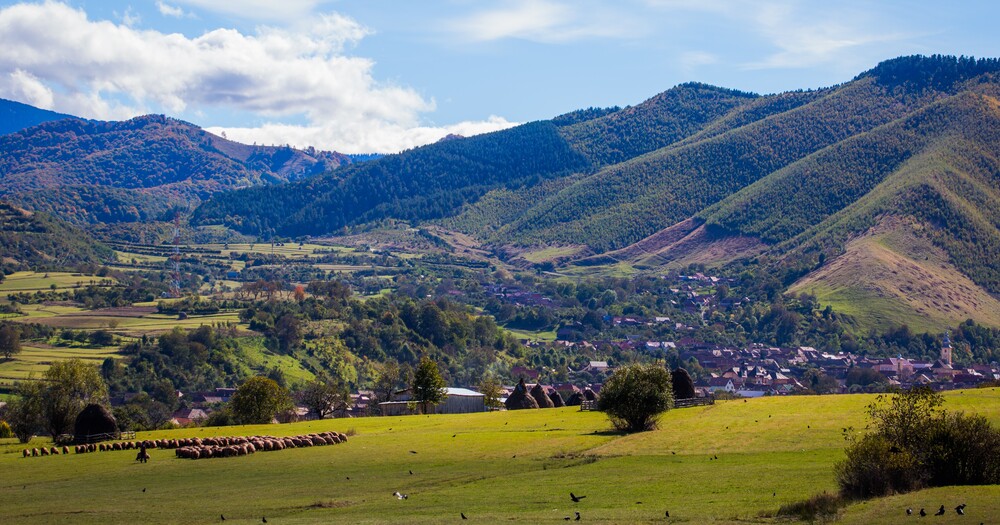
Things to consider before traveling
How to choose your accommodation in europe: a guide.
In Europe, there is accommodation for every wish, price range, and desired experience. Whether it’s a tent suspended between two trees, a five-star hotel with a view of a turquoise sea, or a wallet-friendly hostel, it’s all here. The question is, what specific options do you have and how do you go about choosing? That’s […]
The ultimate guide to European currencies
How to convert cash, use cards, and reduce fees One of the great benefits of traveling around Europe is the ease of use when it comes to currencies. On much of the continent, you don’t need to worry about keeping different bills and coins or making mental-math conversations between one currency to another to […]
How to stay safe while traveling in Europe
No matter what, safety while traveling is most important. Luckily, Europe has a stellar safety record, and more than a dozen of its countries regularly appear at the top end of safest places to live and travel lists. To make your adventure safe and secure, consider these tips and best practices! Travel insurance […]
What you need to enter Europe
Visas, documents, and passports So, you’re planning to visit Europe. Great! We would be happy to welcome you and share what makes this place amazing. Here are answers to the most common questions about preparing for your Eurotrip. Addressing them now will make your travels smooth, easy, and convenient! What is Schengen? The Schengen […]
Your complete guide to planning your daily life in Europe
Tips on local languages, mobile tech, and time zones We all know the feeling: your phone battery is dying or you’re passing through an area of weak signal. At home, it’s usually a simple annoyance, but when you’re traveling, not having access to a communications device is something you’ll want to avoid. So, how […]
Some tips to consider while traveling
Traveling around europe.
Your guide to trains, trams, busses and bikes Europe has one of the most advanced transportation systems in the world. From massive metropolises to small towns, you can easily link up from place to place by public transport. Riding the rails across this marvelous continent might be the best way to explore: it’s highly efficient, […]
Tips to communicate in Europe
Why speaking a few words of the local tongue will make your travel experience even better As you may have guessed, English is widely spoken in Europe, especially in northern countries. In many other countries, people have a good, if not fluent, grasp of the language. But that doesn’t mean that learning—and indeed using! […]
Your guide to passenger rights while traveling in Europe
If you’re a traveler, you’ve probably experienced a delay, cancellation, or other unforeseen issue. Of course, no one wants this, but it’s important to be prepared and perhaps most of all, to know your rights and privileges if a problem arises. So, what are your rights in Europe? Keep reading! Air Passenger Rights So, […]
Unlocking the Magic of Midsummer
Take it slow in Denmark, Norway & Finland!
Cultural routes through Poland
Nicolaus Copernicus Memorial Road Tourist Trail!
San Marinoʼs medieval atmosphere
Tartu: a creative city of street art.
Tartu is the home of artists, writers, and painters who are eager to share their craft with you.
Want to know more about Europe?
Sign up to our newsletter here:
This site is protected by reCAPTCHA and the Google Privacy Policy and Terms of Service apply.
- Travel, Tourism & Hospitality ›
- Leisure Travel
Travel and tourism in Romania - statistics & facts
Travel behavior, coronavirus (covid-19) impact on tourism, key insights.
Detailed statistics
Tourist establishments in Romania 2022, by type of accommodation
Number of arrivals in tourist accommodations in Romania 2006-2022
Average net monthly salary in the hospitality industry in Romania 2016-2022
Editor’s Picks Current statistics on this topic
Current statistics on this topic.
Travel, Tourism & Hospitality
Share of the GDP of the tourism sector in Romania 2013-2028
Number of hotel rooms in Romania 2007-2022
Expenditure on international tourism in Romania 2014-2029
Related topics
Recommended.
- Travel and tourism in Europe
- Travel and tourism in Italy
- Travel and tourism in France
- Travel and tourism in Poland
- Travel and tourism in Hungary
Recommended statistics
- Premium Statistic Share of the GDP of the tourism sector in Romania 2013-2028
- Premium Statistic Tourism establishments in Romania 2022, by type and destination
- Basic Statistic Number of arrivals in tourist accommodations in Romania 2006-2022
- Premium Statistic Tourists accommodated in Romania 2017-2022, by type of establishments
- Premium Statistic Tourists accommodated in tourist establishments in Romania 2022, by destination
- Premium Statistic Most visited counties in Romania by tourists 2022
- Premium Statistic Number of holiday and business trips in Romania 2022, by accommodation type
- Premium Statistic Number of holiday and business trips in Romania 2022, by month
- Premium Statistic Average net monthly salary in the hospitality industry in Romania 2016-2022
Share of the GDP of the tourism sector in Romania from 2013 to 2028
Tourism establishments in Romania 2022, by type and destination
Number of tourism establishments in Romania in 2022, by type and destination
Number of arrivals in tourist accommodations in Romania from 2006 to 2022 (in millions)
Tourists accommodated in Romania 2017-2022, by type of establishments
Number of tourists accommodated in Romania from 2017 to 2022, by type of establishment (in 1,000s)
Tourists accommodated in tourist establishments in Romania 2022, by destination
Number of tourists accommodated in tourist establishments in Romania in 2022, by destination (in 1,000s)
Most visited counties in Romania by tourists 2022
Most visited counties in Romania by number of tourists in 2022 (in 1,000s)
Number of holiday and business trips in Romania 2022, by accommodation type
Number of holiday and business trips in Romania 2022, by accommodation type (in 1,000s)
Number of holiday and business trips in Romania 2022, by month
Number of holiday and business trips in Romania in 2022, by month (in 1,000s)
Average net monthly salary in the hospitality industry in Romania from 2016 to 2022 (in Romanian lei)
Inbound tourism
- Basic Statistic Number of international arrivals in tourist accommodations in Romania 2006-2022
- Premium Statistic Number of international tourist departures in Romania 2014-2029
- Premium Statistic Foreign tourist arrivals in Romania 2022, by country of residence
- Premium Statistic Inbound tourist arrivals by road in Romania 2010-2021
- Premium Statistic International tourism receipts in Romania 2014-2029
- Premium Statistic International tourism receipts per capita in Romania 2001-2029
- Basic Statistic Share of European Union tourists who visited Romania 2022, by country
- Premium Statistic Arrivals of foreign visitors in Romania 2017-2022, by means of transport used
- Premium Statistic Tourism intensity in Romania 2010-2021
Number of international arrivals in tourist accommodations in Romania 2006-2022
Number of international arrivals in tourist accommodations in Romania from 2006 to 2022 (in millions)
Number of international tourist departures in Romania 2014-2029
Number of international tourist departures in Romania from 2014 to 2029 (in millions)
Foreign tourist arrivals in Romania 2022, by country of residence
Number of foreign tourist arrivals in Romania in 2022, by country of residence (in 1,000s)
Inbound tourist arrivals by road in Romania 2010-2021
Number of inbound tourist arrivals by road transport in Romania from 2010 to 2021 (in 1,000s)
International tourism receipts in Romania 2014-2029
International tourism receipts in Romania from 2014 to 2029 (in million U.S. dollars)
International tourism receipts per capita in Romania 2001-2029
International tourism receipts per capita in Romania from 2001 to 2029 (in U.S. dollars)
Share of European Union tourists who visited Romania 2022, by country
Share of European Union tourists who visited Romania in 2022, by country
Arrivals of foreign visitors in Romania 2017-2022, by means of transport used
Arrivals of foreign visitors in Romania from 2017 to 2022, by means of transport used (in 1,000s)
Tourism intensity in Romania 2010-2021
Average number of inbound and domestic visitors per inhabitant in Romania from 2010 to 2021
Outbound tourism
- Premium Statistic Number of outbound tourists from Romania 2010-2021
- Premium Statistic Trips abroad in Romania 2022, by country of destination
- Premium Statistic Share of Romanians traveling abroad 2021, by type of transport
- Premium Statistic Departures of Romanian visitors abroad 2017-2021, by means of transport used
- Premium Statistic Number of holidays and business trips outside of Romania 2021, by destination
Number of outbound tourists from Romania 2010-2021
Number of outbound tourists from Romania from 2010 to 2021 (in 1,000s)
Trips abroad in Romania 2022, by country of destination
Trips abroad in Romania in 2022, by country of destination
Share of Romanians traveling abroad 2021, by type of transport
Share of Romanians traveling abroad in 2021, by type of transport
Departures of Romanian visitors abroad 2017-2021, by means of transport used
Departures of Romanian visitors abroad from 2017 to 2021, by means of transport used (in 1,000s)
Number of holidays and business trips outside of Romania 2021, by destination
Number of holidays and business trips outside of Romania in 2021, by continent of destination (in 1,000s)
Domestic tourism
- Basic Statistic Number of domestic arrivals in tourist accommodations in Romania 2006-2022
- Premium Statistic Number of domestic trips taken for personal purposes in Romania 2010-2021
- Premium Statistic Internal trips in Romania 2022, by tourist areas and length of stay
- Premium Statistic Domestic tourists travelling via organizing travel agencies in Romania 2020-2021
- Premium Statistic Domestic tourists travelling via intermediate travel agencies in Romania 2020-2021
- Premium Statistic Romania: number of domestic trips in 2021
- Premium Statistic Number of domestic & business trips in Romania 2022, by accommodation and destination
- Premium Statistic Number of domestic & business trips in Romania 2022, by transport and destination
- Premium Statistic Romania: domestic tourism expenditure from 2009 to 2021
Number of domestic arrivals in tourist accommodations in Romania 2006-2022
Number of domestic arrivals in tourist accommodations in Romania from 2006 to 2022 (in millions)
Number of domestic trips taken for personal purposes in Romania 2010-2021
Annual number of domestic trips taken for personal purposes in Romania from 2010 to 2021 (in 1,000s)
Internal trips in Romania 2022, by tourist areas and length of stay
Internal trips in Romania in 2022, by tourist areas and length of stay
Domestic tourists travelling via organizing travel agencies in Romania 2020-2021
Number of tourists participating in domestic tourism organized by travel agencies in Romania from 2020 to 2021, by tourist areas
Domestic tourists travelling via intermediate travel agencies in Romania 2020-2021
Number of tourists participating in domestic tourism organized by intermediate travel agencies in Romania from 2020 to 2021, by tourist areas
Romania: number of domestic trips in 2021
Number of domestic trips in Romania in 2021, by purpose of travel (in 1,000s)
Number of domestic & business trips in Romania 2022, by accommodation and destination
Number of domestic and business trips in Romania in 2022, by accommodation and tourist area (in 1,000s)
Number of domestic & business trips in Romania 2022, by transport and destination
Number of domestic and business trips in Romania in 2022, by used transport and tourist area (in 1,000s)
Romania: domestic tourism expenditure from 2009 to 2021
Domestic tourism expenditure in Romania from 2009 to 2021 (in million U.S. dollars)
Accommodation
- Premium Statistic Tourist accommodation establishments in Romania 2022, by hotel rating
- Premium Statistic Tourist accommodation establishments in Romania 2022, by destination
- Premium Statistic Tourist establishments in Romania 2022, by type of accommodation
- Premium Statistic Number of hotel rooms in Romania 2007-2022
- Premium Statistic Rooms in tourism establishments in Romania 2022, by number of beds
- Premium Statistic Number of hotel bed-places in Romania 2010-2021
- Premium Statistic Hotel bedroom occupancy rates in Romania 2012-2022
- Premium Statistic Accommodation capacity in Romania 2022, by establishment and destination
Tourist accommodation establishments in Romania 2022, by hotel rating
Number of tourist accommodation establishments in Romania in 2022, by hotel star rating
Tourist accommodation establishments in Romania 2022, by destination
Number of tourist accommodation establishments in Romania in 2022, by destination
Number of tourist establishments in Romania in 2022, by type of accommodation
Number of bedrooms in hotels and similar accommodations in Romania from 2007 to 2022 (in 1,000s)
Rooms in tourism establishments in Romania 2022, by number of beds
Rooms in tourism establishments in Romania in 2022, by number of beds
Number of hotel bed-places in Romania 2010-2021
Total number of bed-places in hotels and similar establishments in Romania from 2010 to 2021 (in 1,000s)
Hotel bedroom occupancy rates in Romania 2012-2022
Net occupancy rates of bedrooms in hotels in Romania from 2012 to 2022
Accommodation capacity in Romania 2022, by establishment and destination
Accommodation capacity in Romania in 2022, by establishment and destination
- Basic Statistic Participation in tourism in Romania 2022, by age group
- Basic Statistic Main reasons for having a holiday in Romania 2021
- Premium Statistic Trips by purpose in Romania 2022, by gender
- Premium Statistic Average length of stay in hotels in Romania 2010-2021
- Premium Statistic Average expenditure per trip in Romania 2012-2021
- Premium Statistic Expenditure per capita on international tourism in Romania 2001-2029
- Premium Statistic Travel expenses in Romania 2022, by expense type
- Premium Statistic Travel expenses in Romania 2022, by destination
- Premium Statistic Holiday trip expenses in Romania 2022, by duration of stay
- Premium Statistic Business trip expenses in Romania 2022, by duration of stay
Participation in tourism in Romania 2022, by age group
Share of population travelling for personal purposes in Romania in 2022, by age group
Main reasons for having a holiday in Romania 2021
Most important reasons for having a holiday in Romania in 2021
Trips by purpose in Romania 2022, by gender
Trips by purpose in Romania in 2022, by gender (in 1,000s)
Average length of stay in hotels in Romania 2010-2021
Average number of nights spent in hotels and similar tourist establishments in Romania from 2010 to 2021
Average expenditure per trip in Romania 2012-2021
Average expenditure per trip in Romania from 2012 to 2021
Expenditure per capita on international tourism in Romania 2001-2029
Expenditure per capita on international tourism in Romania from 2001 to 2029 (in U.S. dollars)
Travel expenses in Romania 2022, by expense type
Travel expenses in Romania in 2022, by expense type (in million Romanian lei)
Travel expenses in Romania 2022, by destination
Travel expenses in Romania in 2022, by destination (in million Romanian lei)
Holiday trip expenses in Romania 2022, by duration of stay
Value of holiday trip expenses in Romania in 2022, by duration of stay (in 1,000 Romanian lei)
Business trip expenses in Romania 2022, by duration of stay
Value of business trip expenses in Romania in 2022, by duration of stay (in 1,000 Romanian lei)
COVID-19 impact
- Premium Statistic Dynamics of tourist arrivals in accommodation units in Romania 2020
- Basic Statistic Countries where COVID-19 infected Romanians travelled before the outbreak 2020
- Basic Statistic Contracts in the hospitality industry postponed due to COVID-19 in Romania 2020
- Premium Statistic Passenger traffic at Otopeni airport in Bucharest, Romania 2019-2020
Dynamics of tourist arrivals in accommodation units in Romania 2020
Dynamics of tourist arrivals in accommodation units in Romania from January to October 2020 compared to 2019
Countries where COVID-19 infected Romanians travelled before the outbreak 2020
Travel destinations of Romanian nationals who tested positive for coronavirus (COVID-19) from February to March 2020, by country
Contracts in the hospitality industry postponed due to COVID-19 in Romania 2020
Number of employment contracts in the hospitality industry postponed because of the coronavirus (COVID-19) pandemic in Romania in 2020
Passenger traffic at Otopeni airport in Bucharest, Romania 2019-2020
Passenger traffic at Otopeni airport in Bucharest, Romania from 2019 to 2020, by month
Further reports Get the best reports to understand your industry
Get the best reports to understand your industry.
Mon - Fri, 9am - 6pm (EST)
Mon - Fri, 9am - 5pm (SGT)
Mon - Fri, 10:00am - 6:00pm (JST)
Mon - Fri, 9:30am - 5pm (GMT)

Touropia Travel Experts
Discover the World
15 Top Tourist Attractions in Romania

If you think Romania is just about vampires lurking in dark castles, just waiting to pounce on unsuspecting tourists, think again. Transylvanian vampires loom large, of course, but Romania is so much more than Bram Stoker’s Count Dracula and his Brukenthal Palace. Romania does have its share of medieval castles, but it also has pretty alpine scenery hat offers skiing in winter and hiking in summer. It’s got quaint villages and painted churches that are awesome. Just as awesome are the millions of birds that can be found in the Danube Delta where the river empties into the Black Sea. An overview of the top tourist attractions in Romania:
15. Wooden Churches of Maramures
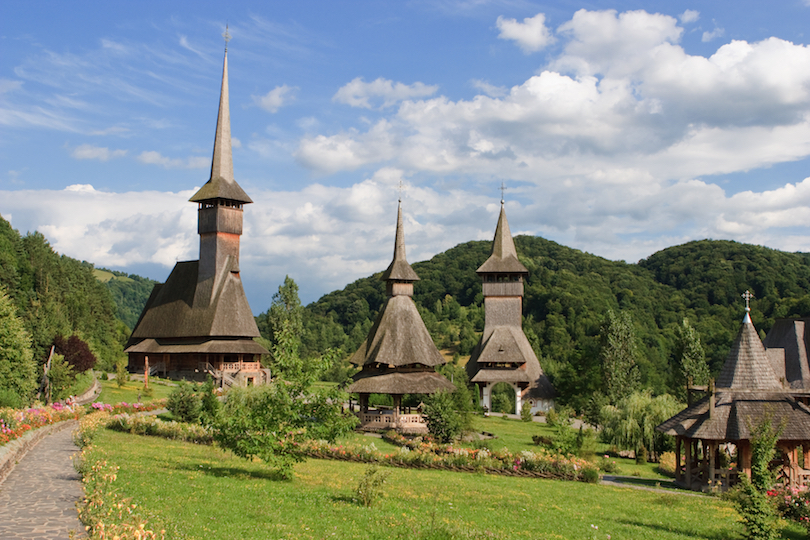
When foreign rulers of Maramures refused to let the people build long-lasting stone churches, they turned to wood instead. They built about 300 wood churches over a 200-year period; only about 100 of these churches remain in use today. These Gothic structures are mostly Orthodox but there are a few Greek Catholic churches. The churches, usually with tall, slim bell towers, reflect an advanced degree of carpentry. They are both simple and elegant at the same time. Hand painted murals decorate the inside of many churches.
14. Vaser Valley Forestry Railway
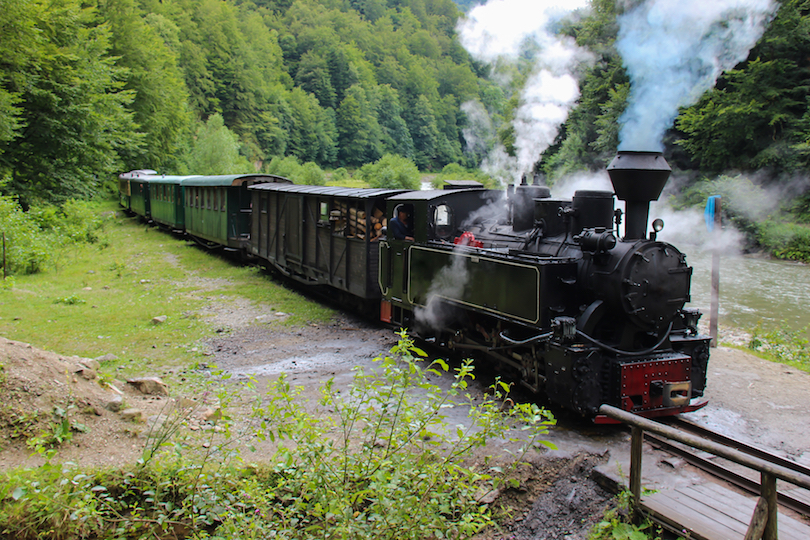
Take a trip back in time as you ride through the forests of the Carpathian Mountains on a steam-powered train. Running along the Vaser River, the Vaser Valley Forestry Railway has been in operation since 1932 when it was used to haul logs from the forest to the mill. Today, it also hauls tourists who like the romance of old, narrow gauge trains traveling through pretty, tree-filled landscapes. The ride stops at Paltin where you have two hours to enjoy the scenery and a picnic lunch.
13. Danube Delta
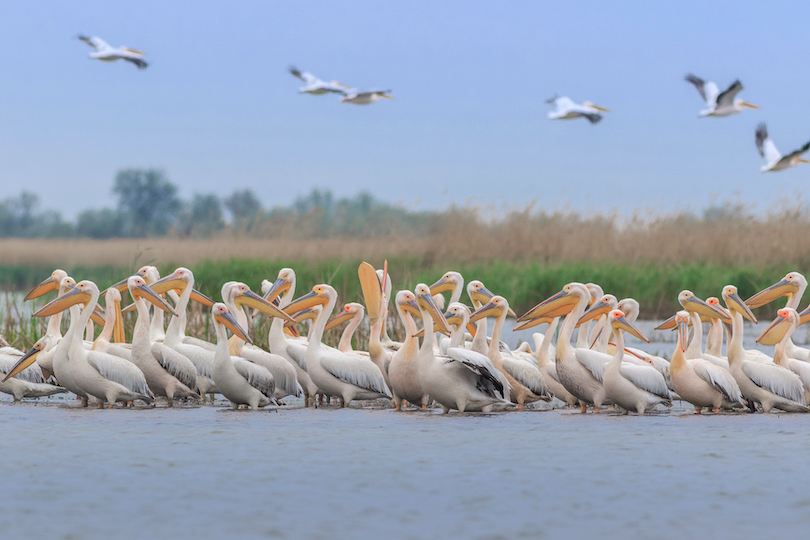
If you’re a nature lover, indulge yourself at the Danube Delta, the largest preserved river delta in Europe; the largest part is in Romania. Be sure to bring binoculars with you, as this is a paradise for watching wildlife, especially birds. Birds flock here from as far away as Egypt and China to breed or winter over. The willow-lined canals offer a great environment for the 300 bird species found here. You’ll also find wildlife such as wildcats, wolves and the occasional boar.
12. Poiana Brasov
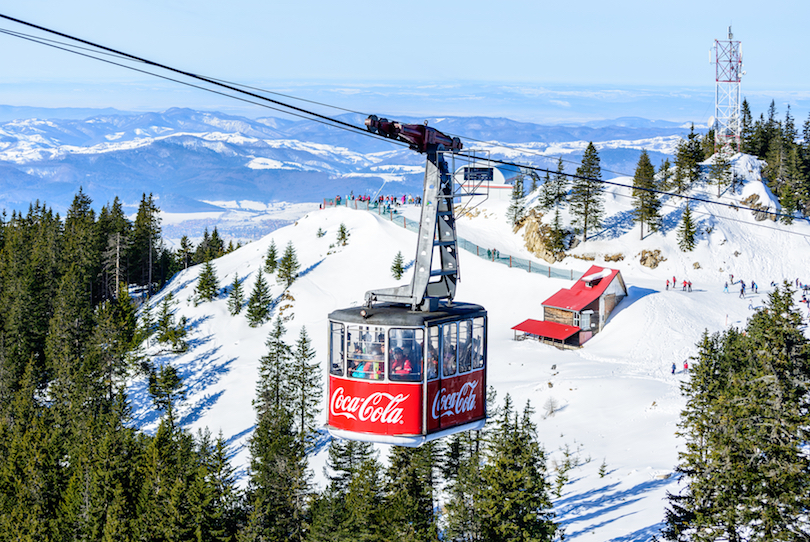
When you get tired of seeking out vampires, consider Poiana Brasov for a change of pace. It’s the most popular ski resort in Romania that also draws skiers from all over Europe. Located in the Carpathian Mountains, the ski resort has seven slopes that offer a combined 25 km (15 miles) of skiing. The resort also hosts competitive alpine skiing and figure skating events. After a day on the slopes, warm yourself up with a traditional mulled wine or try some tuică, a plum based pepper-spiced drink.
11. Corvin Castle
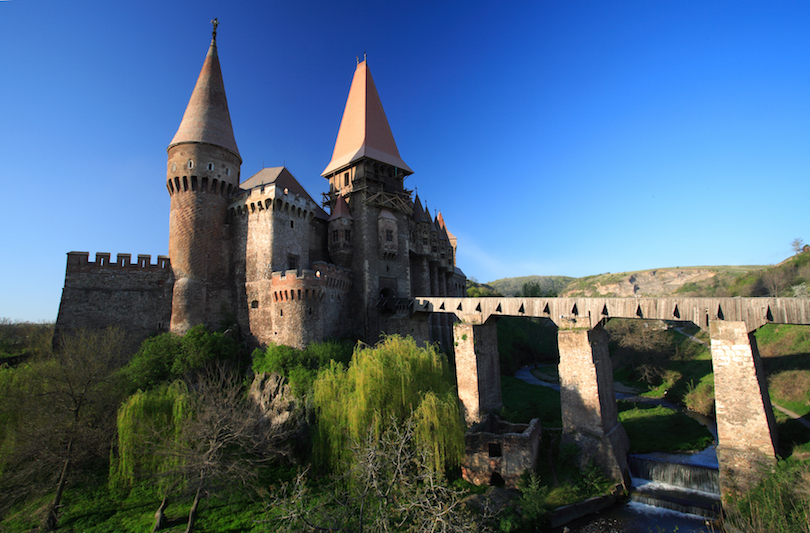
Corvin Castle is an imposing medieval, Gothic structure, considered the most impressive medieval castle in Romania. It also is known as Hunyad Castle after the high-ranking official who built it. Corvin Castle is a fairytale castle that is accessed by a wooden bridge that bears a statue of St. John of Nepomuk, the patron saint of bridges. A raven wearing a gold ring is a symbol of the 15th century castle. See, too, the bear pit and the dungeon where people were tortured.
10. Sucevita Monastery
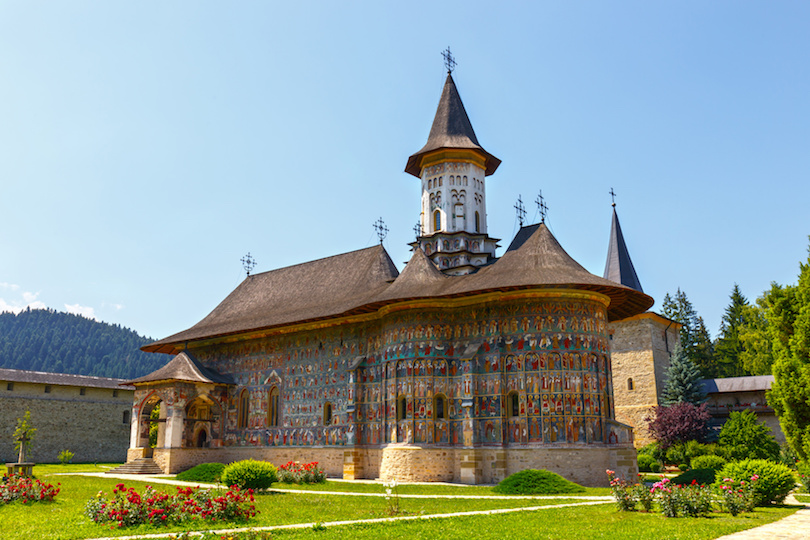
The Sucevita Monastery is architecturally unique, no doubt about that. Somehow the blend of the Gothic and Byzantine styles, plus Moldavia’s painted churches comes together in a spectacular building. The front is cylindrical, topped with a conical roof while the back is rectangular and topped with a small tower. Inside, you’ll find painted murals from the early 1600s and tomb covers embroidered with silver thread. The monastery, located in northeast Romania, is considered one of the most important painted churches in Moldavia.
9. Salina Turda
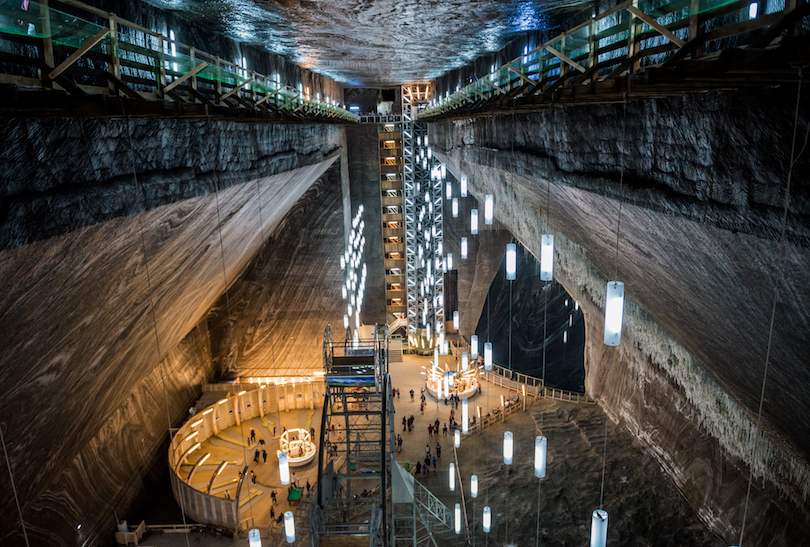
If you feel like you’re working in a salt mine at home, then you should feel comfortable at Salina Turda. The salt mine, which dates as far back as the 17th century, was used for everything from a cheese storage center to a bomb shelter in WWII after excavations stopped in 1932. Today, it has been transformed into an incredible sci-fi theme park. Located in Ciuj County, Salina Turda has been called one of the coolest underground places in the world. When you visit, you’ll head down about 120 meters (400 feet) before reaching the submerged wonderland. Once inside, you’ll find an amphitheater, a bowling alley, an underground lake with prow boats, and even a Ferris wheel.
8. Transylvanian Alps
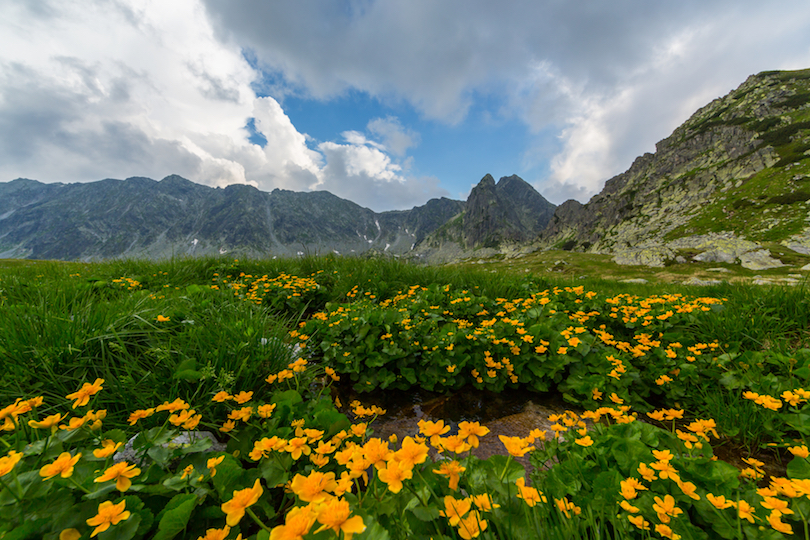
The Transylvanian Alps, also known as the Southern Carpathians, aren’t as high as the Rockies or the Himalayas, usually under 2,000 meters in elevation. The exception is Mount Moldoveanu, at 2,544 meters (8,346 feet), the highest point in Romania. The rugged mountains, dotted with sheep-filled meadows with wildflowers, offer some pretty good hiking in the summer and skiing in the winter. Couch potatoes can visit a mist-shrouded Gothic castle instead as they hunt for legendary vampires on their own turf.
7. Biertan Fortified Church
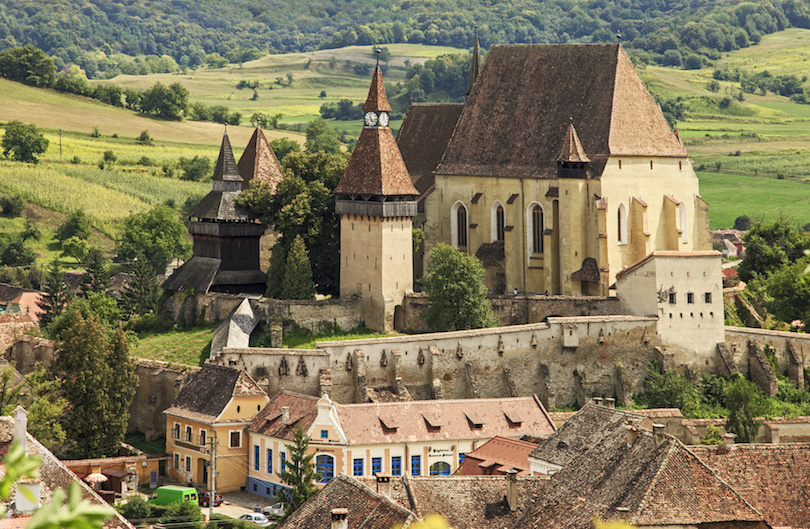
Biertan Fortified Church stands head and shoulders above the other buildings in Biertan, It was originally a Catholic church built when the region belonged to Hungary. It became a Lutheran church after the Reformation. Rather than build a fortress to defend against Ottoman invaders, townspeople fortified the church. Built in Late Gothic style, it is one of the largest fortified churches in Romania. The church is noted for its towers, including one used to store food during sieges and another to imprison husbands who wanted a divorce.
6. Piata Mare
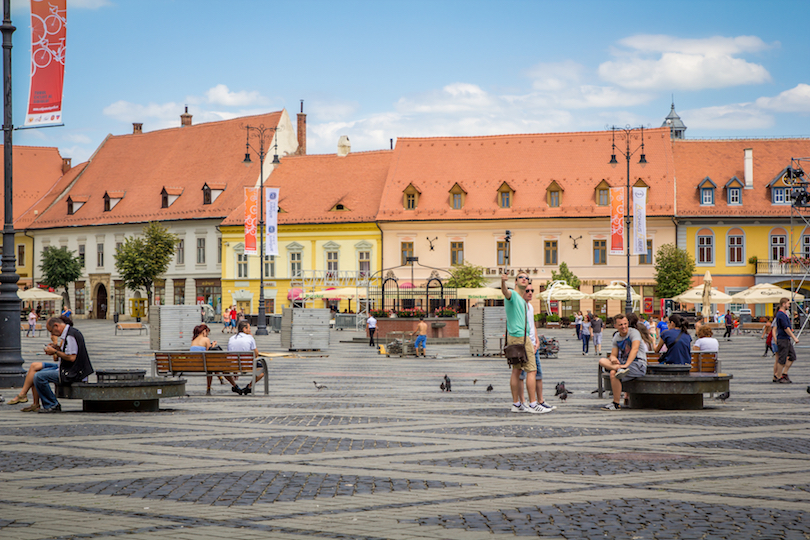
Surrounded by medieval buildings, the Plata Mare, or Big Square as it’s known in English, is a must-see sight in the Transylvanian city of Sibiu. The square had its beginning as a cereal market in the early 15th century. A few decades later, the Tailors’ Guild building went up. It was followed by houses, a Jesuit church and Brukenthal Palace. Big Square was a place for public gatherings, including festivals and beheadings. It was place to see troublemakers as they were displayed in the “lunatic’s cage.”
5. Merry Cemetery
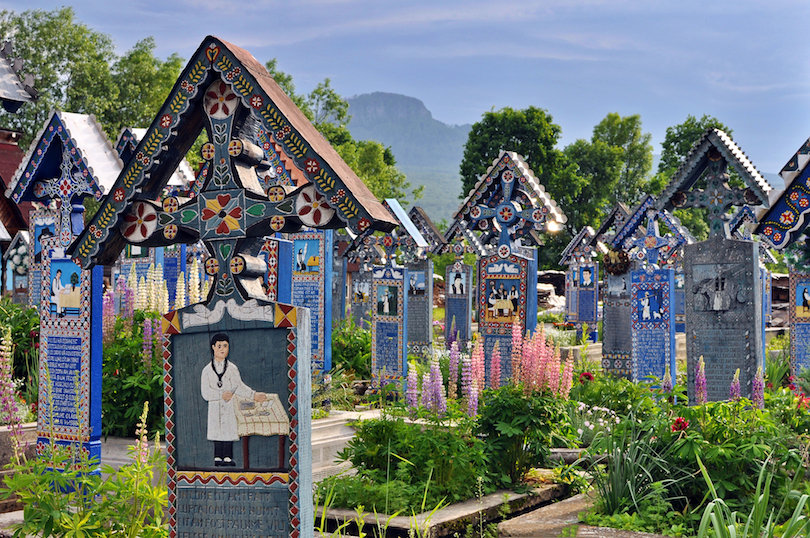
Merry Cemetery in the town of Sapanta isn’t your ordinary run-of-the-mill cemetery. It’s more like a folk art gallery, with colorful tombstones, crosses and statuary celebrating the lives of the deceased. This colorful tradition began with a 14-year-old boy who began carving crosses in 1908. He added poems and painted a portrait of the deceased on the cross; sometimes he even painted how they died. And thus a tradition was born. The background on everything is deep blue, with other colors symbolizing life, death and fertility.
4. Peles Castle
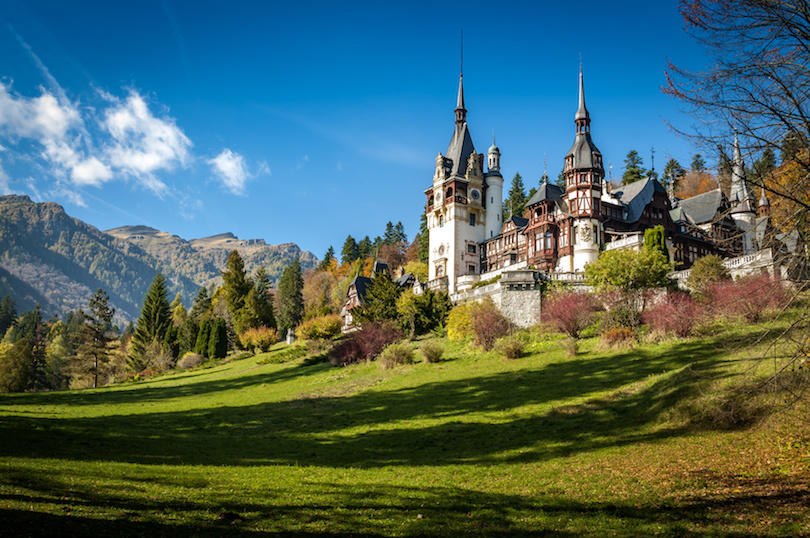
Peles Castle doesn’t have a history of sieges and warfare but it does have something other European castles don’t: spectacular beauty, sitting as it does on a Carpathian hillside. This Neo-Renaissance castle was built by King Carol I who vacationed here in the 1860s. Fairytale-like in appearance, it’s considered one of the most stunning castles in Europe. A 4,000-piece weapons collection reflects the king’s military interests, while a movie room decorated with frescoes reflects the queen’s artistic interests. The first movie shown in Romania aired here.

3. Palace of Parliament
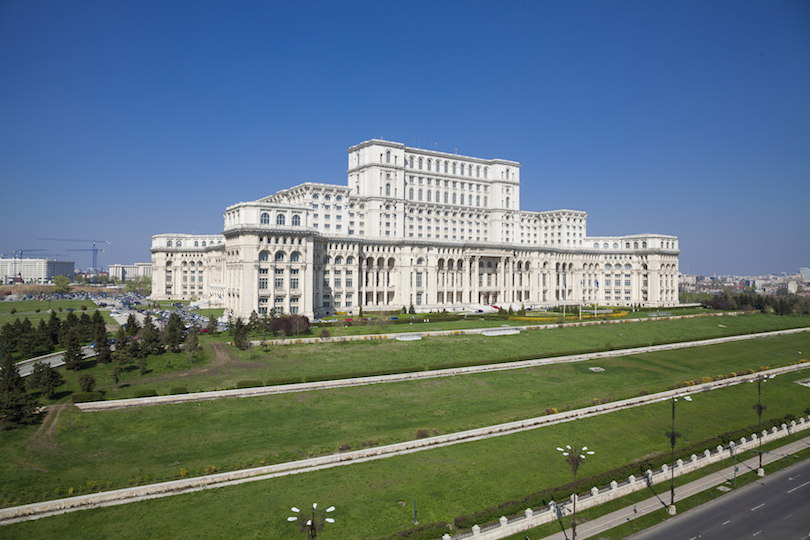
In a country where medieval buildings abound, there’s nothing medieval about the Palace of Parliament in the capital Bucharest . It is a thoroughly modern complex that is considered the largest administrative building in the world. It took 20,000 workers, working around the clock, 13 years to build it. It is an architectural wonder involving 700 architects and design specialists. The palace is a popular tourist attraction with foreigners, but not so much with the locals since it was built by Romania’s hated leader, Nicolae Ceaușescu.
2. Sighisoara Historic Center
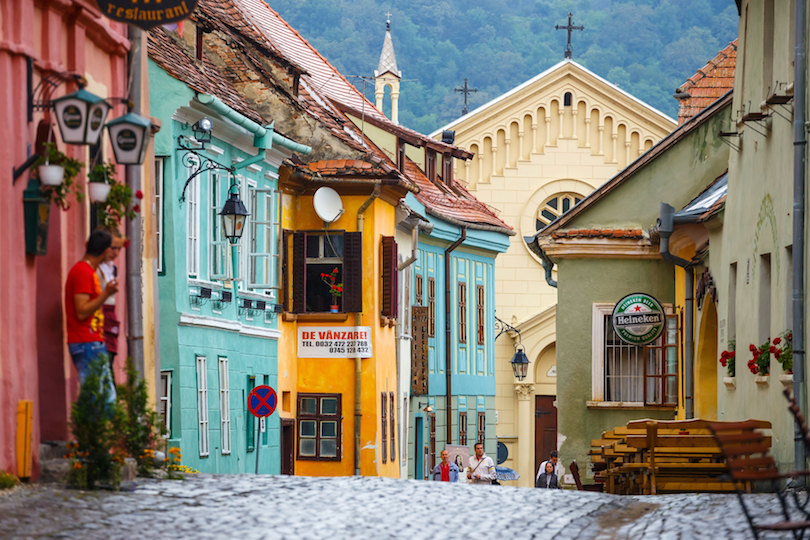
If you have preconceived notions of what medieval life was like, Sighisoara Historic Center will certainly fulfill them. Old Town Sighisoara is definitely medieval at its finest. Found by 12th century Transylvanian Saxons, Sighisoara is a great example of a fortified medieval town. It has the traditional narrow streets flanked by colorful stone buildings. It is the birthplace of Vlad the Impaler, the inspiration for Bram Stoker’s Dracula. Sighisoara celebrates its medievalness every July with a festival that includes rock bands.
1. Bran Castle
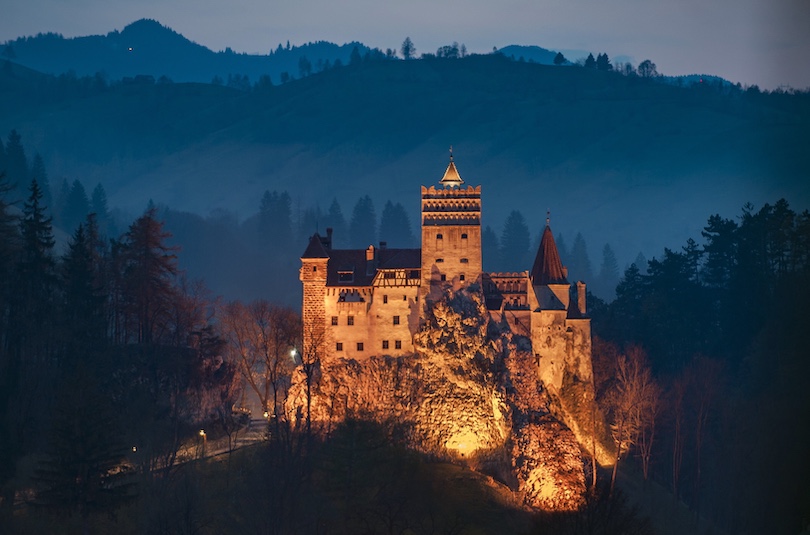
Bran Castle is often associated with Dracula as his home, though there’s no indication that author Bram Stoker even knew of this medieval castle. The castle, a Romanian landmark, has a fairy tale quality, peeking out from forested a hillside near Brasov in Transylvania. With roots dating to the 13th century, this medieval castle today is a museum showcasing art and furniture collected by Queen Maria. It also is home to an open-air museum featuring Romanian peasant buildings from around the country.
Map of Tourist Attractions in Romania
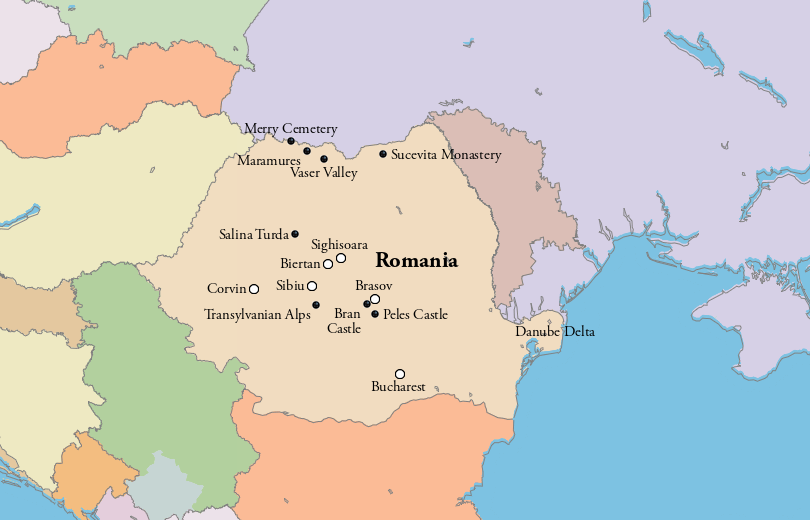
Share this post:
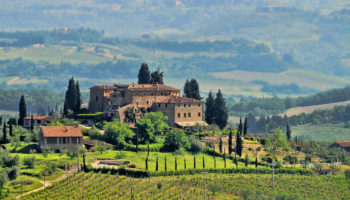
6 Most Beautiful Regions of Europe
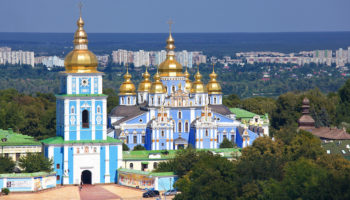
25 Best Places to Visit in Eastern Europe
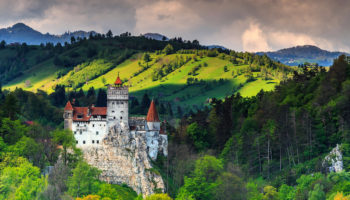
9 Most Beautiful Regions in Romania
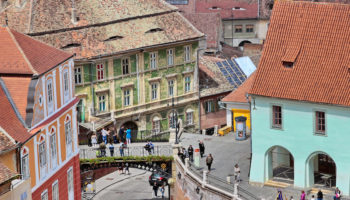
12 Best Cities to Visit in Romania

10 Best Places to Visit in Romania
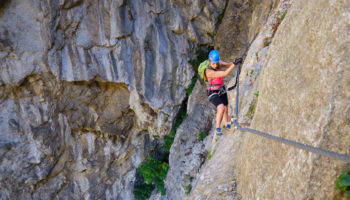
17 Best Things to Do in Romania
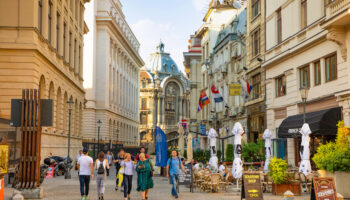
17 Top Tourist Attractions in Bucharest, Romania
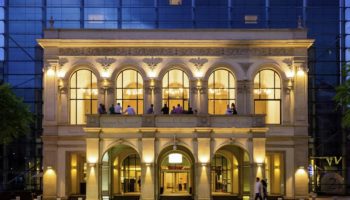
Where to Stay in Bucharest: 8 Amazing Hotels
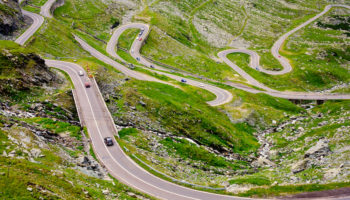
7 Best Day Trips from Bucharest
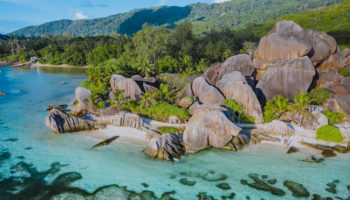
15 Best Things to Do in the Seychelles
Reader interactions.
June 14, 2019 at 6:49 am
Unlike historic monuments, the Danube valley to the south west of Romania is just stunning. With rugged valleys cris crossed by the beautiful Danube river , it’s a revival for the soul.
October 7, 2018 at 10:47 pm
You should defenitely visit tirgu mures in the centre of Romania,it has the palace of culture,the medieval fortress and many beautiful places.
February 5, 2018 at 3:07 pm
We invite you to visit The Other Capital of Romania ! Alba Iulia represents the charming mirror in which all the ethnic groups of Transylvania can discover their vigor or their traditions. The heart of Alba Iulia is Alba Carolina Citadel. Alba Carolina, the most representative bastion fortress in Romania and Southeast Europe, built upon the initiative of Emperor Charles the VIth of Habsburg.
Leave a Reply Cancel reply
Your email address will not be published. Required fields are marked *
This site uses Akismet to reduce spam. Learn how your comment data is processed .
The ethnic mosaic is enhancing local culture
In Romania, different ethnic minorities exist and coexist with the locals, having traditions, traditional recipes, and crafts, making tourism more sustainable and diverse and also helping the local community.
Romania is a country of diversity. Various cultural influences have marked the evolution of this Eastern country, a country located at the intersection of Eastern and Western influences. Thus, in today's Romania, we find surprisingly different regions, starting with the economic level of development and up to the lifestyle of the inhabitants. Along with the majority Romanian population, 19 historical national minorities live on the territory of the Romanian state, which amounts to 10% of the population in Romania. It is known that minority ethnicities complement Romanian traditions and culture, providing an overview of the spread of different minorities in Romania and how the traditions of minorities and majorities have influenced and enhanced each other over time.
In many of the villages in Romania, the locals, together with the ethnic minorities, joined forces to create a real cultural heritage in their village, while also participating in the development of sustainable tourism in the area.
In Transylvania , in villages such as Viscri, Saschiz, or Crit, groups of Germans in Romania have made a special contribution to the development of society, culture, and the arts. The Saxons from Transylvania had a system of elementary schools since the 14th century, and their gymnasiums are the first in Romania. In the 18th century, the primary education of the Saxons became compulsory, the Saxons being the first in Europe in this respect. After a sustained development of crafts and trade in the 14th and 15th centuries, due to the Turkish invasions, the Saxons were forced to build a defense system, building over 150 fortified churches and church fortresses, which are still unique architectural monuments today.
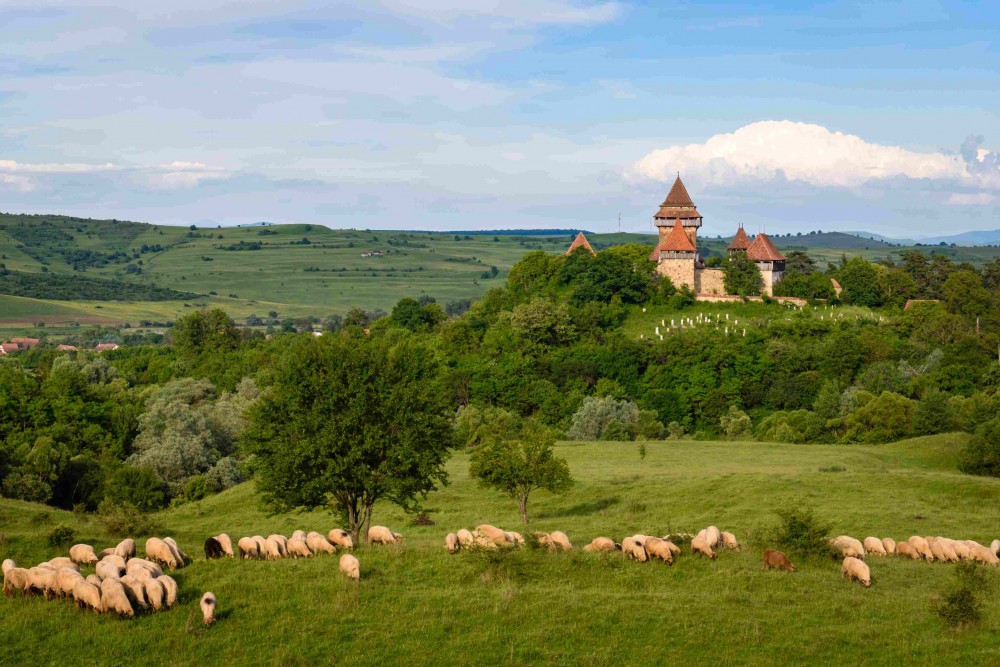
Today, the Transylvanian Saxons is a minority that has always been present in the development of the local community.
In order to keep their traditions alive, the locals join annually at the "Haferland Week" - a festival that aims to attract Saxons returning home, locals, and tourists who want to discover a fairytale area, as it is one the largest events dedicated to promoting Saxon culture from Transylvania.
One of the participants to this festival is ' The Women's Neighborhood of Saschiz' a non-governmental organization without heritage purpose, which carries out activities and projects for the benefit of different social categories in the community and for the promotion of local cultural and natural heritage and aims to promote and enhance the local cultural and gastronomic heritage.
"Rhubarb Holiday" is an event organized by these lovely women, dedicated to promoting local values of local cultural and gastronomic heritage, with the participation of housewives and producers from Saschiz. Throughout the event, visitors can taste and buy local rhubarb dishes (and more): rhubarb cake, rhubarb pizza, jams, syrups, ice cream.
Speaking of good food, coming from the south on the Transalpina - the famous "King's Road" that crosses the mountains - you will reach the villages of Mărginimea Sibiului , famous for their crafts and industries related to sheep breeding, for authentic folklore, folk costumes full of charm, for popular holidays and occupations preserved from generation to generation. The border of Sibiu is one of the few destinations in Europe where agro-tourism blends happily with mountain and leisure tourism.
One of the main associations in the region whose main purpose is to develop communities through education and creativity, reconnecting them with their own territory is Asociatia My Transylvania , whose gastronomic events such as the famous Transylvanian Brunch have helped in supporting the development and sustainability of rural areas by promoting local products, recipes, and culture.
Malancrav, an isolated village almost detached from the grandparents' stories, preserves one of the largest Saxon communities in southeastern Transylvania. Of the almost 1100 inhabitants, most are Romanians, and the rest are Saxons, Roma, and Hungarians, which is why it is considered a living multiethnic heritage. Well-known for preserving the authenticity of its built heritage, for its idyllic landscapes, traditions, and customs, for the biodiversity of the area, the village is one of the best places to visit while in Romania!
Here you can visit many of the local craftsmen who have kept most of the crafts in the region alive, have a traditional lunch, and also overnight in the beautiful the Apafi Manor, built in the 15th century by the Hungarian Royal Family. The Manor was recently restored, and the restoration process was a meticulous one, carried out to high standards, with the involvement, among others, of local artisans for embroidery and furniture for interior and exterior.
To obtain a sustainable development of the community in the village, the Mihai Eminescu Trust Foundation initiated the cultural route project "Mălâncrav - living multiethnic heritage", by creating a cultural route to enhance the intangible heritage and local multiethnic material.
Now, visitors have the opportunity not only to spend the night in the traditional guest houses in Mălâncrav but also to know the nearby attractions and have a complete experience by participating interactively in learning the local culture.
In Rimetea , a beautiful village set at the foot of the Trascau Mountains, the local and cultural heritage is determined by the traditions of the Hungarian community, which is the most substantial part of the population, but also by the remaining locals.
The village is distinguished by the unique architecture of the houses from the 19th century, which we can see even now. After a century and a half ago, a fire destroyed almost all the houses, the village was reborn, and the new houses were built according to the same architectural model - tall houses, with white walls and green-painted window frames, with high gates, with garden and orchard in the back, some of them being transformed into boarding houses. In order to preserve its architectural values, Rimetea received the " Europa Nostra " award from the European Union in 1999, through the European rural restoration program of the same name.

Did you know?
It is said that in Rimetea, the sun rises twice: the first time at the horizon, and the second time after the Szekler Stone, which is the mountain that can be admired from any part of this beautiful village.
Dobrogea is the region located in Southeastern Romania, and it is well known for its openness to the Black Sea through the Danube Delta, which made access easier for communities that today still live in small numbers in some villages. The region represents an authentic model of interethnic coexistence, together with the local Romanian population, settling here, living, throughout the historical periods, which have influenced the local culture very much.
In Dobrogea, along with the locals, live in harmony with 18 ethnic minorities, who enrich and color through their traditions and customs.
However, the cultural heritage of Central Dobrogea territory is rich in archeological sites, the oldest objectives dating back to ancient times. The crafts practiced in this territory caused a large influx of tourists before 1989, which is why the Central Dobrogea GAL , a local private-public partnership paid huge attention to the conservation of cultural resources, including museum collections, archives, sites, and landscapes.
Traditions and customs that are found on the territory of the region are important. Women from the Turkish and Tatar communities in the Dobrogea region meet frequently and discuss the cultural identity that defines them, so that it is not lost in the century of speed in which we live and in which young people often want to keep up with fashion, forgetting their roots.
In Bucovina , although many minorities have lived and still live in the region, the village remained relatively authentic, and the culture developed due to the Romanians attached to the land.
Dolheşti is an authentic settlement that transformed its eternal heritage into a unique experience, making tourists from all over the world feel like being part of the local community by welcoming guests into their homes. Although there is no hotel in Dolheşti, accommodation for villagers is intended to be the recipe for the success of the locals, which have been actively involved in developing rural tourism in the region. One of the persons to contribute to the development of the area and to carry on the traditions is Mirela Nechita, who founded the Șomuzului Valley Promotion Association . The project "Tourist in Dolhești" is a model in rural tourism and heritage tourism, transforming tourism into something magical to those eager to know the Șomuz Valley, local culture, and taste traditional food.
Tourists who stop in Dolheștii Mici can visit the Hatmanul Șendrea Church dating from the 15th century, peasant households, the mill that is over 100 years old, visit the local craftsmen and participate in cooking, sewing or pottery workshops.
In order to keep alive, the traditions but also the cultural heritage, the local communities in Bukovina organize the festivals, such as the National Dance Festival annually -"Hora de la Prislop" or The National Easter Eggs Festival, considered some of the best national festivals in Romania .
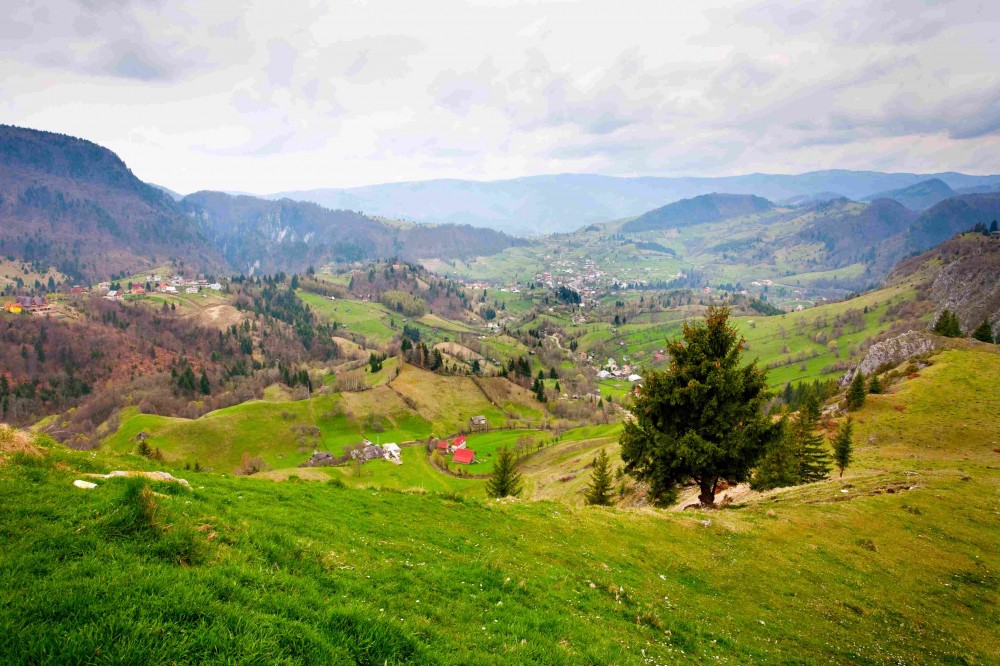
Did you know?
Local guides say that in Dolhestii Mici, the whole forest is full of trenches from the Second World War!
Another example in which the Romanian culture was little influenced by other ethnic minorities in the Maramures area. The villages of Maramureș have become famous all over the world for their beauty and authenticity. The fairytale landscapes, the architecture of the place, the simplicity and kindness of the people, the decade's old traditions, and the local culinary dishes have transformed Maramureș into an area that attracts more and more tourists.
Prince Charles is the one who brought the fame of the village of Breb throughout Europe after he bought some old houses in the area, which he rehabilitated. In love with the beauties of the place, with the settlements built about a hundred years ago, with the local traditions, Prince Charles had only words of praise for Maramureș and the area also presented in the documentary Wild Carpathia .
Here, the villagers have the same preoccupations as in the past, the men doing woodworking, carpentry or carpentry, and the women with the spinning of wool and weaving.
In Maramures, the locals have been actively involved in preserving the culture and the beauty of the wooden churches in Ţara Lăpușului is transposed into the virtual world at the initiative of the County Center for Preservation and Promotion of Traditional Culture Maramureş, through a wonderful cultural project " BISERICI DE LEMN DIN ŢARA LĂPUŞULUI ", meant to promote the most important cultural monuments in the region.

However, due to the cultural and ethnic diversity specific to Maramureș in the past, in some communities of Maramureș, there are wooden churches with various features such as the wooden churches from Verhovina Maramureșului of the Ruthenians, and the churches of wood from Huțulșcina Maramureșului of the Hutuls from the springs of the Tisza.
The traditions in this beautiful area are maintained with the help of folk craftsmen, who kept alive the memories and customs of the elders, but also with the help of a cultural institution whose purpose is, among others, the preservation of traditions and perennial values of popular culture, defending it against pollution and degradation.
In addition to the extremely valuable information that it provides, Centrul Județean pentru Conservarea și Promovarea Culturii Tradiționale Maramureș , started in August 2007 the "Fotoetnografica" project, as a necessity to "scan" from a photographic point of view all the ethnic-folkloric areas of the county of Maramures.
Also, because of the rapid disappearance of the generation that practices customs, traditions, folk costumes, traditional crafts, as well as area-specific architecture, the project is significant for Romania and our future descendants who will be able to learn and who knows, maybe revive some of the traditions and crafts. Check out the beautiful photographs here !
Are you curious about the Wooden Churches of Maramures, but you cannot travel at the moment? Although the website does not have an English version, just click o the pictures and then on the 'Acceseaza Tur Virtual' section and enjoy!
Click here and explore!
Whether you are interested in experiencing a raw culture or a cultural mozaique, Romania is happy to welcome you!
- Discover Romania
- My Romanian experience
- Travel tips
- UNESCO Sites
- Romanian Culture&Traditions
- History of Romania
- Unique places
- Romanian Myths & Legends
- Travel blogger in Romania
- From tourist to local
- Destinations
The 7 Most Beautiful National Parks in Romania
How is halloween celebrated in romania, what are unique experiences not to miss in romania.
Tour of Transylvania in five days from Budapest
Seven days self-drive trip from Bucharest to Transylvania
Four days safari experience in the danube delta from bucharest.
Six days self-drive trip from Iasi to Bucovina and Neamt county
Join our newsletter.
Would you like to find out the latest trips and stories from the land of Romania?

Search form
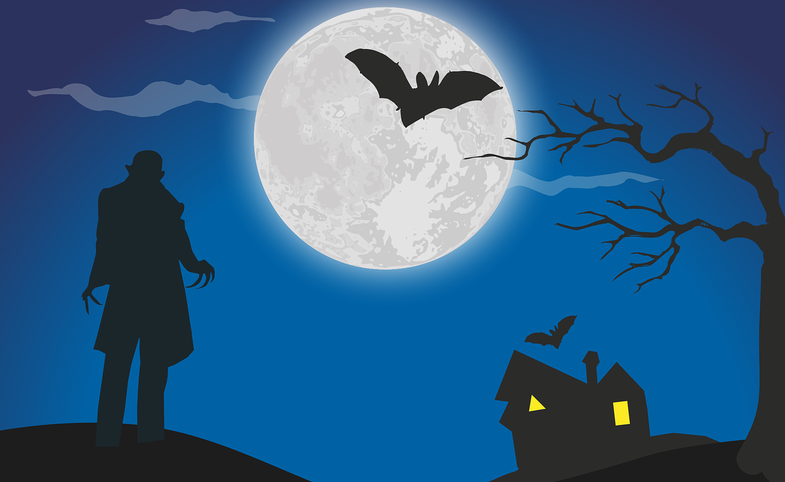
Dracula Tourism: The Impact on Romania's Image
Should a country promote a nation-branding strategy that is at odds with its own cultural identity?
This is the question facing Romania, a country that has been the destination of so-called "Dracula tourism." The title character of Bram Stoker's novel has brought many tourists to Transylvania in hopes of exploring this mystery, yet the Romanian government has not always been receptive to this characterization.
Here is a sampling of the many journal articles exploring the positives and negatives of this phenomenon:
Adina Nicoleta Candrea, Ana Ispas, Elena Nicoleta Untaru, Florin Nechita, "Marketing the Count's Way: How Dracula's Myth Can Revive Romanian Tourism," Bulletin of the Transilvania University of Braşov Series V: Economic Sciences , Vol. 9, Issue 58, No. 1, 2016, 83-90.
Abstract: Tourism destinations associated with the place myth phenomena often experience increased visitation and marketing opportunities. Considering the popularity of the Dracula myth worldwide, Romania has a great opportunity to improve its image as a unique destination on the international tourism market. Thus, the present study aims to analyze the exploitation of the Dracula myth in the Romanian tourism context, as well as the managerial and marketing implications of such an approach. It begins with an overview of the imaginary and historical links between Romania and the Dracula myth. Further on, it reviews the national initiatives to develop Dracula tourism, from both private and governmental perspectives. The paper concludes by highlighting the opportunities of developing Dracula tourism in Romania and embracing the Dracula myth as a unique competitive advantage of the country as a tourism destination.
Oana Mihaela Stoleriu, Bogdan Ibanescu, "Dracula Tourism in Romania: From National to Local Tourism Strategies," Proceedings from SGEM 2014: International Multidisciplinary Scientific Conferences on Social Sciences and Arts, Volume IV, Section: Economics and Tourism, 2014.
Abstract: Starting from the constant controversy regarding the capitalization of Dracula’s myth, the paper analyses the place of Dracula tourism in the Romanian national policy and local destination management. The study focuses on two key Dracula destinations and highlights the main actors and strategies that have shaped their evolution as well as the main components of local heritage capitalized.
Duncan Light, "Dracula Tourism in Romania: Cultural Identity and the State," Annals of Tourism Research , Vol. 34, Issue 3, July 2007, 746-765.
Abstract: The state plays an important role in tourism development, in planning and policymaking, and also as the arbiter of cultural meanings. States choose to encourage forms of tourism that are consistent with their cultural and political identities. But they may have to contend with forms of demand that are beyond their control. “Dracula tourism” in Romania is one example. Founded on a place myth of Transylvania as the home of the supernatural, this activity is discordant with Romania’s self-image and the way it wishes to present itself to the wider world. This paper examines the way the Romanian state has managed and negotiated such tourism, in both socialist and post-socialist contexts.
Smaranda Cosma, Cornelia Pop, Adina Negrusa, "Should Dracula Myth Be a Brand to Promote Romania as a Tourism Destination?" Interdisciplinary Management Research , Vol. 3, 2007, 39-56.
Abstract: Dracula is an international brand, not a Romanian one. But Bram Stocker chose to locate his vampire in the mysterious location of Transylvania. Thus, Romania is the only country in the world which can exploit the myth of Dracula as being at its ‘home’. This could be considered a competitive advantage for Romania as a tourist destination. The vampire named Dracula generates mixed, mainly negative, feelings among Romanians. And maybe—for the 21st century—can become a character falling in desuetude. Though, the question remains: should the Dracula myth be used as a brand promoting Romania as a tourist destination? The present paper tries to find an answer to this controversial question.
- destination branding
- nation branding
- national identity
- cultural identity
- cultural heritage
- dracula tourism
- eastern europe
Events Tourism: Egyptian Place Branding
Do cultural events transcend the scope of cultural diplomacy? Can they be used in destination branding? To learn how these questions pertain to Egypt, check out the article, "Events Tourism: A Potential to Build a Tourist...
Measuring Country Image: A New Model
The role of country images and knowledge of their constitution and effects is of major interest not only for scholars and professionals in the domain of public diplomacy, but also for various adjacent fields such as...
Donald Trump Is Decimating America’s Tourist Economy
Brown soot-filled skies darken this San Francisco day as homes and fields burn a few miles north in Napa and beyond. It is the worst regional fire here in generations. Texas, Florida, Puerto Rico and now Northern...
Food for Thought: Gastrodiplomacy in Tourism
Food has long been a source of soft power for countries, and it can play an important role in the tourism industry as well. A new article in the Current Issues in Tourism journal explores the growing importance of...
STAY IN THE KNOW
Want to follow the issues you care about in public diplomacy?
Sign up for the CPD Weekly Newsletter:
Visit CPD's Online Library
Explore CPD's vast online database featuring the latest books, articles, speeches and information on international organizations dedicated to public diplomacy.
Popular Blogs
- Why Is Pakistan Important for U.S. Public Diplomacy? February 9
- "Nation of Storytellers": Ireland’s Public Diplomacy Success Centers on Storytelling March 22
- Public Diplomacy in the Era of Post-Reality February 13
- Non-Western Public Diplomacy in the Western Balkans February 14
- Mongolian Public Diplomacy: Where It Stands And What Can Be Done? February 23
Phone: (213) 821-2078
Email: [email protected]
Academia.edu no longer supports Internet Explorer.
To browse Academia.edu and the wider internet faster and more securely, please take a few seconds to upgrade your browser .
Enter the email address you signed up with and we'll email you a reset link.
- We're Hiring!
- Help Center

Aspects related to the Post-Pandemic Rural Cultural Tourism in Romania

Bulletin of the Transilvania University of Brasov Series V Economic Sciences
In Romania, rural cultural tourism has had and is expected to continue to have an extremely beneficial impact on the development of certain disadvantaged areas of the country, because it represents an economic driver, a means of capitalizing on resources, and of prompting local and territorial authorities. Thus, it provides medium and long-term contributions to the preservation and promotion of the most authentic and valuable aspects of the Romanian spirit. In what concerns the activities carried out in the rural area with respect to culture, the risk area has been extended during the sanitary crisis; however, the restrictions and the lockdown have been “useful” in increasing awareness of available resources, in planning actions in a more diligent manner and in broadening the vision of what should be done. In the context of the pandemic, all these aspects have become strengths. Post-pandemic tourism should be characterized by rediscovering itself, and the stake for rural cultural to...
Related Papers
Cecilia Enache
Studia Universitatis Babes Bolyai-Negotia
Monica M Coros , Alexandra Dulau
Redmarka. Revista de Marketing Aplicado
Ana Gabriela Babucea
Tourism is one of the important pillars of many national economies. Practicing the tourism has a multiplier effect on several industries, being interdependent with the food industry, communications, transport industry etc.Worldwide, all rural areas face the same problems: economic decline, environmental degradation, poverty of population or gradual loss of national identity. Its population is aged, young people preferring to migrate to cities. In this context, the villages are struggling to maintain its viability.Tourism is one of the sectors that can contribute to resuscitate villages. Practicing rural tourism was developed in response to human needs, subjected to daily increasing stress, to recreate the economic needs of these areas and the concern to preserve the environment and tradition.This paper aims to analyze the trends and changes rural tourism in Romania, namely how tourism activity has evolved, but the direction he is going, too. For this, we will use the existing data a...
annalsreview.geo.unibuc.ro
Natasa Vaidianu
Journal of Environmental and Tourism Analyses
Mihaela Preda
International Journal of Economic Practices and …
otilia manta
In the EU tourism sector in 2012-2013 represent over 5% of GDP, providing over 7 million jobs. As a universally accepted definition, rural tourism is a type of travel practiced in rural areas. Buildings have low capacity, usually presenting architectural interest, being decorated in a reminiscent style of traditional homes. It pays special attention to traditional local gastronomy and most often are conducted in a family system. "Rural tourism is a concept that includes tourist activity organized and led by the local population, based on a close connection with the environment, natural and human" (Barbu, I. " Approach to the concept of rural tourism " , Agricultural Management/Lucrări Științifice Seria I, Management Agricol, 2013). Tourism in rural areas was always practiced, but was shaped, appreciated and requested the evolvement of civilization amid the higher phenomena of industrialization and urbanization. The rural tourism in its pure form, should be: located in rural areas; functional in a rural point of view; at a lower scale, both in terms of construction and settlements; traditionally, of different types (representing the complex model of the environment, economy, history and location).
Sustainability
Andreea Crăciun
Rural tourism, defined as a form of local initiative tourism, has at its forefront the involvement of the local community, who contribute significantly to the affirmation and promotion of this type of tourism. In order to be able to speak of the practice of this type of tourism in a given geographical area, it is first necessary to highlight the existence of a tourist heritage, both natural and anthropic, which identifies itself with the authentic character of the area, satisfying the need of the tourist to discover activities and tourist attractions with local specificity. The purpose of this research is to investigate the role of socio-economic and cultural aspects in the sustainable development of tourism in the Gurghiului Valley. The present study also aims to highlight the role of local entrepreneurs in the process of economic development in the area by means of new practices and sustainable approaches; this is based on efficient capitalization of the natural and anthropic tour...
Catalina ANCUTA
This paper explores the issues connected between rural sustainable development in formerly state-socialist countries and the local cultural heritage of rural areas. It pays specific attention to the potential of cultural tourism which can enhance local rural development. This paper is a case study of the Hărman commune, and this area is investigated in depth. It is one of the most important rural and cultural areas located in Brașov County of Romania, a country with an impressive cultural heritage concentrated in its rural areas. The study uses a mixed-method analysis combining quantitative and qualitative research (focus groups, interviews, oral histories, and personal conversions), participatory ethnographic observation, and logical framework analysis (LFA). The main findings of the study illustrate that the Hărman commune has an important cultural heritage which could be more capitalized on in the future through the lens of cultural tourism to ensure local sustainability and to o...
Nature Communications
Rut Carballido-lópez
RELATED PAPERS
Polish Maritime Research
Rafał Ossowski
International Conference on Aerospace Sciences and Aviation Technology
Tarek Khaled
Thierry Oberdorff
Carmen Morán
Pacific Science
William R Smith
Mining and Metallurgy Engineering Bor
Miomir Mikic
Aji Pujimanzah
Michael Azer
Ogundana Oyebisi
Meta Berghauser
Conjecturas
Júlia Morisson feltrini
The Electronic Journal of Combinatorics
Robert Cori
Engineer: Journal of the Institution of Engineers, Sri Lanka
Sohan Wijesekera
Mostafa Gamal
Microorganisms
Anshuman Yadav
Michela Gnaldi
Biodiversitas Journal of Biological Diversity
Yashi Srivastava
International journal of environmental research and public health
Carolina Lozano Avila
Jurnal Komunikasi Ikatan Sarjana Komunikasi Indonesia
Nani Muksin
Gastroenterology Research and Practice
hakan kunduracılar
Annals of Animal Science
Ignatius Verla Nsahlai
Comprehensive Psychiatry
Antonina S Farmer
International journal of geoinformatics
Ilhom Abdurahmanov
See More Documents Like This
- We're Hiring!
- Help Center
- Find new research papers in:
- Health Sciences
- Earth Sciences
- Cognitive Science
- Mathematics
- Computer Science
- Academia ©2024
Cultural and Charity Tourism
Great Experience in Oltenia
Romania The Land of Beauty
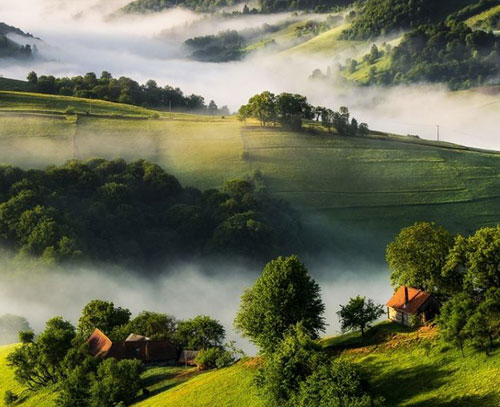
Romania is a land of natural beauty, where all types of landscapes are to be found

The culture of Romania is a unique culture, which is the product of its geography and its distinct historical evolution

Our plan in Romania
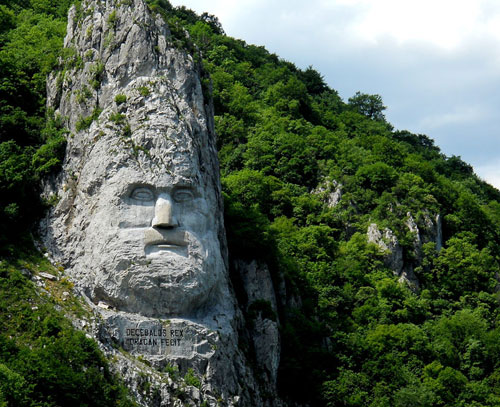
Leisure activities available here include cultural tourism, spa therapies, horse riding and agritourism.
Romanian Cultural Tourism
Information regarding Romania tourist attractions and travel to Romania. Information regarding Romania tourist attractions and travel to Romania. Information regarding Romania tourist attractions and travel to Romania. Information regarding Romania tourist attractions and travel to Romania
Who We Are?

Few words about us and our projects Few words about us and our projects Few words about us and our projects Few words about us and our projects Few words about us and our projects Few words about us and our projects Few words about us and our projects Few words about us and our projects
Danube Cycling Tour
In this tour you have the opportunity to visit Oltenia region along the Danube river. Each day you will cycle through wonderful landscapes and in the evenings you will be treated to romanian cuisine and cultural experiences. The city of Craiova will also uncover it’s beauties.
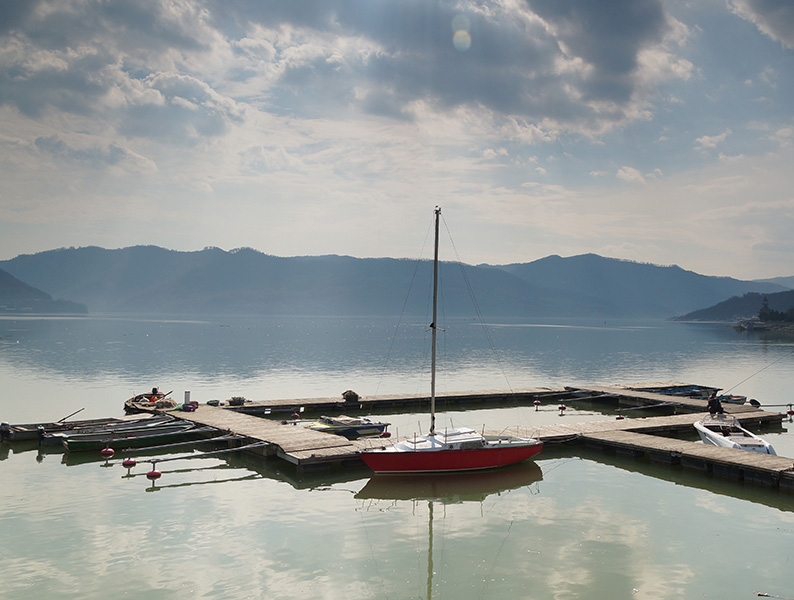
“Great tour made so easy!â€
Driving through the Romania countryside will afford numerous opportunities of interacting with locals in both road markets and small villages

Zack (India)
“One of my favorite memories!â€
Thereby the tour was very authentic.
Romanian Govt. opens new call for cultural tourism projects
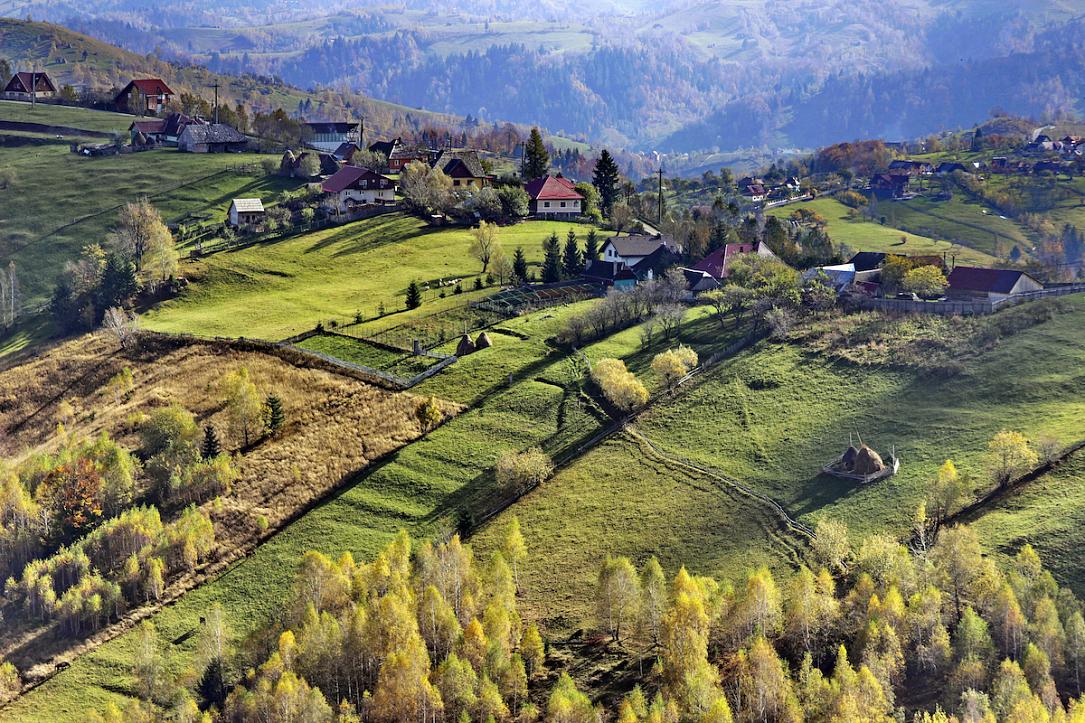
Andrei Chirileasa
Like this article? Share it with your friends!
The Ministry of Investments and European Projects launched on May 3 a new call for projects within the program envisaging the "promotion of the 12 tourist/cultural routes, Component 11 - Tourism and culture" under the National Recovery and Resilience Plan (PNRR) of Romania.
Apparently, the projects submitted in the first call were not covering the most representative routes.
The component of the PNRR has a budget of EUR 105.3 mln. A first call was open between February 25 and March 20, following which the ministry found it necessary to open a new call to occupy the remaining seats available within the tourist/cultural routes, respectively, because "the 12 tourist/cultural routes should be representative for the entire country."
"Romania's cultural heritage is a value of ours, of all of us, which must be capitalized on in order to create jobs, especially in rural areas," interim minister Marcel Boloş said, according to News.ro .
"I hope that through this new call, we will have more proposals for objectives for the restoration of Roman forts and churches, and for the promotion of monasteries, fortresses, castles and traditional villages, and other objectives on the 12 important routes for promoting cultural tourism in Romania," he added.
(Photo source: Andrei Stancu/Dreamstime.com )
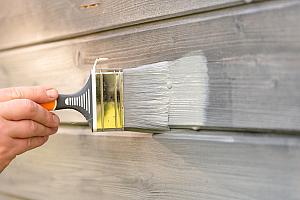
Recommended stories

Romania Insider Free Newsletters
Editor's picks, latest press releases, from our partners.
An official website of the United States government
The .gov means it’s official. Federal government websites often end in .gov or .mil. Before sharing sensitive information, make sure you’re on a federal government site.
The site is secure. The https:// ensures that you are connecting to the official website and that any information you provide is encrypted and transmitted securely.
- Publications
- Account settings
Preview improvements coming to the PMC website in October 2024. Learn More or Try it out now .
- Advanced Search
- Journal List
- Healthcare (Basel)

COVID-19 Pandemic and Local Cultural Tourism in the Buzău Carpathians and Subcarpathians (Romania)
Bianca mitrică.
1 Human Geography and Regional Development Department, Institute of Geography, Romanian Academy, 023993 Bucharest, Romania
Ines Grigorescu
2 GIS and Environmental Geography Department, Institute of Geography, Romanian Academy, 023993 Bucharest, Romania
Irena Mocanu
Paul-răzvan Şerban, nicoleta damian, monica dumitraşcu.
3 Physical Geography Department, Institute of Geography, Romanian Academy, 023993 Bucharest, Romania
Cristina Dumitrică
Associated data.
Not applicable.
The COVID-19 pandemic was and continues to be a major challenge for tourist activities worldwide. Cultural tourism was mostly hit because of the social distancing measures, travel restrictions and ban on people gatherings for cultural events. The current study is trying to provide an overall image of the challenges local cultural tourism has faced during the COVID-19 pandemic in a predominantly rural area of Romania—the Buzău Carpathians and Subcarpathians. The area has a high tourist potential stemming from the complexity and diversity of the natural landscapes and the local historical setting. The survey relies on two field campaigns carried out in 2020 when 161 questionnaires were applied to tourists, businesses and residents. The results highlight the significant impact of the COVID-19 pandemic on small businesses during and after the travel restrictions (e.g., revenue losses, temporary business shut-downs and layoffs/technical unemployment), but also on tourists’ travelling preferences and sentiment and on residents’ attitudes and behaviour.
1. Introduction
Tourism is one of the world’s major economic sectors, making up the third-largest export category (after fuels and chemicals) which accounted for 7% of global trade in 2019. Before the outbreak of the pandemic, the tourism sector accounted for 10% of the global GDP and employed approximately 320 million persons around the world [ 1 ]. In some countries, tourism can rise up to over 20% of the GDP, supporting 1 in 10 jobs and providing livelihoods for many millions more in both developing and developed economies [ 2 ]. It plays an enormously important role in the EU economy and society, generating foreign exchange, maintaining jobs and businesses, and driving local development and cultural exchanges [ 3 ]. Tourism remains a branch of consequence, whose development will be constantly in close correlation with the levels and rhythms of development of the other branches of the national economy [ 4 ]. The tourism industry is linked with every sector of the economy, but its development as a domain may, in some cases, be independent to other economic sectors [ 5 ]. Tourism and economic growth are also well connected, but there are so many factors which affect tourism positively and negatively [ 6 ]. Among these factors most cited are: accessibility and infrastructure [ 7 , 8 , 9 ], cost of staying, education [ 10 , 11 ], travel facilitation including easing of visa regulations [ 10 ], security [ 9 , 10 , 12 ], culture and language, natural and atrophic landscape [ 9 , 11 ], health pandemics and global financial crisis [ 12 , 13 ], income level [ 14 ], policy formulation and implementation [ 7 , 15 ], and attitudes of host communities [ 12 ]. Sustainable tourism development requires the informed participation of all relevant stakeholders, as well as strong political leadership to ensure wide participation and consensus building. Achieving sustainable tourism is a continuous process and it requires constant monitoring of impacts, introducing the necessary preventive and/or corrective measures whenever necessary [ 16 ].
The COVID-19 pandemic posed an immediate threat to the tourism industry and instantly influenced travel-related decision making.
Most of the world’s markets were faced with pandemic-related hardships, the scale of this crisis and its devastating effects on operations, employees and customers being unmatched by previous crises [ 17 , 18 ]. After the pandemic spread across the globe, its intensification and the related consequences have become dependent on a wider variety of factors, generating a system of complex interrelationships [ 19 ]. Thus, the COVID-19 pandemic had a much more significant impact on the global travel industry than the previous health crises because of a much greater geographical expansion, leading to the widespread implementation of travel bans and lockdowns affecting domestic travel [ 13 , 20 ], in general, and international travel, in particular. The pandemic has been acknowledged as an extreme outlier in terms of its implications for tourism [ 21 ], as it was and continues to be a challenge for the overall worldwide tourist activity, an unprecedented crisis for the tourism economy as a result of the immediate and immense shock it triggered [ 22 , 23 , 24 , 25 ], generating devastating effects for the tourism sector [ 26 ]. By the same token, the COVID-19 outbreak altered the tourism model worldwide [ 27 ] and has given rise to a new model of tourism governance [ 28 ], the shock being felt differently by entrepreneurs/businesses, tourists and residents.
Like the case of previous crises (e.g., SARS, Ebola, the global economic downturn) it is almost certain that recovery will follow. There are two questions—how long will the effects last, and when will the eventual recovery begin? These questions rise the need for research on the effects of such events, and the attitudes of those effected [ 29 ], namely entrepreneurs/business, tourists and residents. The impact of the perceived risks on travel behaviour and tourism decision making during and after the COVID-19 pandemic has already been identified in different studies by Fusté-Forné et al. (2021) [ 23 ], Gaffar et al. (2022) [ 25 ] and Matiza, 2020 [ 30 ].
Given that the current paper intends to approach cultural tourism in relation to the COVID-19 pandemic through the businesses’, tourists’, and residents’ behaviour, we highlight that businesses were among the most impacted components of the tourist activity within the larger context of the disruption of value chains and the decrease in international trade [ 31 , 32 , 33 ]. The economic collapse caused by the COVID-19 pandemic has been dramatic [ 34 ], the United Nations World Tourism Organization (UNWTO) estimating that 100–120 million direct tourism jobs were at stake, which included both low-skilled and high-skilled workers. Compared to the previously observed crises, the economic collapse caused by the COVID-19 pandemic has been more dramatic [ 34 ]. The results of the World Youth Student and Educational Travel Confederation survey on businesses revealed a downturn in demand in almost all travel sectors and world regions [ 29 ].
Strategies to decrease the COVID-19 trend, such as community lockdowns, social distancing, stay-at-home orders, travel and mobility restrictions, have led to the temporary shut-down of many hospitality businesses and to a significantly reduced business demand [ 35 ]. Taking the impact on closely linked sectors into account, the drop in international arrivals has caused an estimated loss of about 2.4 USD trillion in GDP in 2020 [ 36 ]. The 2020 declining trend in demand of almost all of the companies in the tourism industry [ 29 ] was followed by the same trend in 2021, which contributed to a deterioration of their business prospects [ 37 ]. Sectoral job losses have been prevalent, particularly in the most vulnerable host communities with their highly dependent tourism workers [ 38 ], the negative impacts felt being related to economic activity, unemployment, revenue loss and business shutdown [ 39 ]. Measures taken to combat the COVID-19 pandemic have harmed economic growth and have significantly restricted population movement, both inside and outside the country [ 40 ].
Pandemics, in general, have led to a significant decline in tourist arrivals. During the COVID-19 pandemic, in particular, supply, demand, spending and consumer confidence have all disintegrated [ 41 ]. Internationally, the number of overnight stays decreased over the 2019–2020 period by 74%, from 1.5 billion to 381 million, 2020 being the worst year on record for tourism [ 42 ]. There is a significant association between the past records in international tourism and the cumulated numbers of confirmed cases and deaths caused by COVID-19 [ 43 ]. In 2021, tourism experienced a 4% increase (i.e.,15 million more international tourist arrivals compared to 2020), but the international arrivals were still 72% below the pre-pandemic level of 2019 [ 42 ]. The health risk has become an important factor impacting tourists’ behaviour during the COVID-19 pandemic [ 17 , 44 , 45 ]. COVID-19 can be regarded as a health hazard for tourism, and the consumer’s perception of risk would be higher during a pandemic [ 46 ], having the strongest effect on a person’s intention to travel [ 47 ]. Risk perception influenced the perception of recreation site quality, the pandemic having a negative impact on visits [ 48 ]. Modern tendencies prove that there is a higher demand for the subsequent experiences: safe tourist destinations, in the most general sense of the concept of safety, including psychological, physical, food safety, and certifications deemed “clean and safe”; nature destinations; privacy, associated with less massified destinations; comfortable accommodation; less fractional and more extended vacations; and proximity [ 27 ].
Within the destination community, residents have a variety of reactions to the COVID-19 pandemic as it relates to tourism. It is difficult to predict resident attitudes toward tourism because of the complexity of community systems and their “disparate variables” [ 49 ]. There are multiple factors which influence a host community, such as the level of concern displayed by the community, its involvement in tourism, the community’s level of attachment, the development level of the local economy, the economic and social benefits, and the socio-cultural costs [ 50 ]. The perception of positive or negative impacts within the resident communities depends on the demographic factors (e.g., age, gender, income, education, location) [ 17 ]. Regardless of the economic benefits that tourists may bring, residents have expressed their concerns about the health risks that would accompany the arrival of tourists [ 51 ].
Cultural tourism, in particular, was mostly hit because of the social distancing measures, travel restrictions and the ban on people gatherings for cultural events. Heritage tourism, together with the cultural and social fabric of communities were the most affected by COVID-19 in terms of the postponement or closure of many intangible cultural heritage practices, i.e., traditional festivals, markets for handicrafts, products and other goods. World Heritage Sites were closed in 90% of countries having significant socio-economic consequences for tourism-reliant communities. Moreover, 90% of the museums were closed, 13% of which may never reopen [ 42 ]. As a consequence, the livelihoods of millions of cultural professionals have been seriously jeopardized [ 52 ]. According to Barchielli et al. (2022), young adults had higher scores in preoccupation, change of habits, and willingness to change habits, this group also reporting a fear of disease, its consequences, and the likelihood of isolation linked to COVID-19. Adults are the least worried, expressing less fear, and seem to be less willing to change their habits but they showed a fear of possible vaccine consequences, while elders have least changed their current habits being the most vulnerable to the disease, also being the most successful in limiting social contact [ 53 ]. In Romania, the situation was not very different. Despite the fact that the Romanian territory has a rich and valuable heritage potential with tourist attractions included on the map of European cultural routes [ 54 ], the country offers a great variety of cultural heritage to travellers in a short time, such as Byzantine churches, roman basilicas, gothic cathedrals, Turkish mosques, Greek fortresses, cubist or 1900’s style buildings [ 55 , 56 ], the effects of the COVID-19 pandemic were significant. In Romania, the patient zero infected with the SARS-CoV-2 virus was found on 26 February 2020 and one year later, on 24 February 2021, there were 788,048 cases of people infected with COVID-19 declared (the real numbers likely far surpass this figure due to insufficient testing [ 3 , 17 ]), 731,049 patients had been cured, and 20,287 were deceased. For the tourism industry, the year 2020, the most atypical year in the history of Romanian tourism, was full of trials and challenges [ 57 ]. According to the National Institute of Statistics, the number of overnight stays in Romania decreased by 51.5% over the 2020–2021 period, from 30.0 million to 14.5 million. This reflects the impact that the pandemic has had on Romanian tourism, in general, as well as on cultural tourism, in particular.
Concerning their effects on tourism, as well as on several adjacent economic activities, at least three major stages can be distinguished in Romania:
- (1) Between 15 March and 15 May 2020, a general lockdown was put into place throughout the country. The imposed measures were very strict, and they mainly included the mobility of citizens, the transportation of goods, the limitation of public transport, sanitary measures, economic measures [ 58 ]. All these restrictions affected the national tourism industry, as well as the local tourism within the study area.
- (2) November 2020, the Romanian Government took the measure of closing down all Romanian markets. The closing of fairs had important negative effects for tourist activities within the Buzău Carpathians and Subcarpathians, where, in 2019, 22 markets and fairs associated with cultural and/or religious events were organised [ 59 ]. They were all shut down in 2020.
- (3) Between March and April 2021, when several sets of measures entered into force, such as the quarantine for different settlements (e.g., those surrounding the capital-city and other big cities, some large urban centres or small isolated localities) and periods of time (e.g., two weeks and/or during the weekends). The imposed quarantine measures restricted the free movement of people, thus making the tourists’ access to the tourist attractions impossible.
This research takes into account a series of investigations undertaken within the Horizon 2020 SPOT project (Work package 1: Data and documentation on cultural tourism, http://www.spotprojecth2020.eu/reportsandoutcomes , accessed on November 18 2022), where the perception of three main components of the tourism system in the Buzău Carpathians and Subcarpathians was analysed differently and comparatively: tourism businesses, tourists and residents. The aim of this research was to find out more about the similarities and differences that exist in entrepreneurs’, tourists’ and residents’ behaviour and the impacts of the COVID-19 pandemic on cultural tourism in Romania, and specifically in the Buzău Carpathians and Subcarpathians. Moreover, we were interested in analysing tourists’ experiences, as well as the residents’ and tourism entrepreneurs’ views during the pandemic and what the influence of COVID-19 had been on cultural tourism (e.g., experienced changes, discovered opportunities) in a rural area with a potential for cultural tourism nevertheless underdeveloped from this perspective. In this study, the authors are focused on filling this knowledge gap by performing a perception analysis focused on the businesses’, tourists’ and residents’ perspective on cultural tourism, relying on collecting data from the key informants in the case study area.
The research questions addressed are grouped in order to respond to the three categories of the parties interviewed:
RQ1 Business: How the business has been affected, the measures taken to offset the negative impact, in general, and the relationship with the employees, in particular, the assistance received from the government and in order to sustain the business during the COVID-19 crisis:
RQ2 Tourists: How the COVID-19 crisis changed the way of travelling and how satisfied tourists were during visit(s) prior to and after the COVID-19 crisis.
RQ3 Residents: The relation between residents and cultural tourism by underlining the participation in cultural activities in their own surroundings prior to and during the COVID-19 crisis.
A Hypothesized Model aimed at better addressing the Research Questions was proposed. Studies have determined that the COVID-19 pandemic influenced tourists travel propensity (especially cultural tourism), local business and resident behaviour.
The COVID-19 pandemic positively and significantly affects travel propensity. We have examined the tourist arrivals before and during the COVID-19 pandemic period. Travel restrictions, accommodation and limited restaurants capacity impacted travel propensity. Compared to 2019, tourists arrivals decreased by 60% .
The COVID-19 pandemic negatively and significantly affects local business. The lower number of tourist arrivals reduced the activity of tourism entrepreneurs.
The COVID-19 pandemic altered residents’ behaviour related to cultural activities participation. Within the COVID-19 pandemic context, residents have chosen to visit cultural sites and participate in cultural activities in their own surroundings less than before, as reflected by the field enquiry.
2. Study Area
The Buzău Carpathians and Subcarpathians are located in Buzău County, within the South-East Development Region ( Figure 1 ). The area consists of 34 Local Administrative Units (LAUs), two of which fall under the urban category (towns) and 32 under the rural one (communes). The study area accounts for around 128,000 inhabitants (2018), 86.1% of which are rural, and 13.9% are urban, and has a density of about 47.6 inh./km 2 .

The location of the study area in Romania.
The study area, a predominantly rural region, is facing complex socio-economic and environmental issues. After multiple socio-economic transformations, as a result of the enforcement of communist policy guidelines and of the post-communist (post-1990) economic, social and political transitions, the study area has faced numerous problems similar to the rest of rural and urban areas in Romania. The latter are reflected in the imbalance between the environmental components, the underdevelopment of the rural economy, and last but not least in the low life quality of the rural communities. In terms of demographic size, the communes are grouped into two main categories: under 5000 inhabitants (28 communes) and between 5000 and 10,000 inhabitants (4 communes). The two towns, Nehoiu and Pătârlagele, are small sized, with a population of 10,492 inh. and 7319 inh., respectively ( Figure 2 ).

Demographic size at LAU level, 2021.
The economic activity in the study area is based on the agricultural sector, followed by the tertiary (25.9% of the total employed population) and secondary (20.5%) sectors (National Institute of Statistics, Bucharest, Romania, TEMPO Online). The agricultural sector is mainly made up of vineyards (red wine production), joined by orchards of apples, plums, cherries and apricots. Existing favourable conditions have engendered the possibility of developing the livestock sector, most notably that of the predominance of cattle, pigs, sheep and poultry. Despite the high agricultural potential, the processing capacity of agricultural products is low due to the outdated technologies in use [ 60 ]. The secondary sector was affected by the economic restructuring by reducing the over-sized socialist industrial sector, leading to the counter-productive expansion of the agricultural sector. The main industrial activities are related to the wood processing industry (Nehoiu town) and the exploitation of natural hydrocarbon resources (Berca commune). The tertiary sector is dominated by tourism, trade, transport, education and health activities. While the trade and transport activities are rather basic, the health system is characterized by a lack of resources, as well as by an unequal territorial distribution of available resources which makes it difficult for the national and local healthcare system to supply proper treatment and medication in all areas of the country, particularly in rural and small urban areas [ 61 ].
The Buzău Carpathians and Subcarpathians are a blend of scenic natural landscapes and rich history valorised through cultural heritage sites, traditional customs and identity items: gastronomy, fairs and markets, religious sites, museums, wine routes, etc. The diversified cultural potential is marked by the presence of the Buzău Land Geopark, Natura 2000, and Siriu and Penteleu sites, integrating an important part of the mountainous area of the study area [ 62 ], which set up the unitary conception of development of cultural tourism, among other types of tourism, which capitalized on the two functions of these sites, that is, the protective function on the one hand, and the tourism function, on the other hand.
The tourist flows dynamic shows a constant increase over the 2011–2019 period, followed by a 59.6% decrease over the 2019–2020 period ( Figure 3 ). According to the National Institute of Statistics, in 2019, Buzău County, of which the study area is a part of, is visited mainly by Romanian tourists (98.98%), the rest being foreign tourists, 79.3% of which being tourists from EU countries. Summer is the busiest season for tourism in the study area ( Figure 4 ) when 47 entrepreneurs mentioned that their businesses are the busiest (94%). Additionally, the school holidays and the autumn months seem to also be busy, while the cold season is not regarded as a busy period for local tourism, as is the case for the spring season.

Tourist overnight stays in the reception structures providing accommodation (Data source: National Institute of Statistics, TEMPO Online).

Monthly accommodation occupancy rates (Data source: National Institute of Statistics, TEMPO Online).
In terms of the importance of tourists’ origins, domestic tourists rank first—from under 150 km and from over 150 km away—which means that local tourism businesses attract mostly the domestic tourists, the majority of local tourism businesses stating that domestic tourism brings in the highest shares of income.
Prior to the COVID-19 pandemic, in 2019, the number of overnight stays varied between 64,656 in Merei commune and 145 in Breaza commune ( Figure 5 ).

The dynamics of overnight stays, 2019–2020.
Within the study area, there are 106 businesses which have tourism activity as their economic profile.
The highest number of tourists registered in Merei commune is due to SărataMonteoru resort, a seasonal spa of local interest where the chlorine–sodium water pool fed by local springs is the main tourist attraction of the area. Weekend tourism is the main type of tourism practiced here, many tourists coming from the Buzău area just for the privilege of using the pools. During the first part of the COVID-19 pandemic (the 2019–2020 period), the overnight stays dynamics shows a decrease by 65.8%, the most significant decline being registered in the Breaza commune (100%), while the lowest decline was found in the Pârscov commune (24.6%) ( Figure 5 ).
3. Materials and Methods
The paper was written based on the results of a survey applied to tourists, residents and entrepreneurs/businesses during the field work carried out in the study area in 2020 as part of the framework of the HORIZON 2020 SPOT project. Firstly, the terms tourist, resident and tourism business/entrepreneur were defined in the context of the study area and of the HORIZON 2020 SPOT project: a tourist is an adult who visits the case study area (for one or multiple days) and comes from another region in the country, another country in Europe, or from another continent; a resident is a person who lives in the case study area; and a tourism business/entrepreneur is someone who owns a company connected to touristic area, or is a CEO or (senior) manager at said company.
The targeted interviewed categories as part of the framework of the HORIZON 2020 SPOT project were businesses, tourists and residents. All consortium partners followed the same three surveys related to business, tourists and residents designed by the WP leader. The questions related to the COVID-19 pandemic appeared after the project approval (2019) and were addressed as an extension to the initial scope of the project.
The survey offers a qualitative and quantitative picture of the meaning and importance of the effects that the COVID-19 pandemic has had on cultural tourism in the Buzău Carpathians and Subcarpathians. The survey contained two types of questions: (i) who the businesses (e.g., the location of the business, the type of business, the admission fees, the number of visitors, the total visitors’ capacity, the size of the site, the type of visitors targeted, the type of ownership), the tourists and the residents (e.g., gender, age, residence, education, profession, income, household make up) are who were on the receiving end of the COVID-19 pandemic effects and (ii) the aspects linked to the impact of COVID-19 ( Figure 6 ).

The description of the questions included in the surveys.
3.1. The Sampling Method
Sampling is a key issue in survey research [ 63 ], whose fundamental step is the identification of the sampling frame. In our case, the sampling frame comprised all the residents, tourists and businesses in the tourism field activity within the study area, as defined in the context of the HORIZON 2020 SPOT project. Sampling itself involved the expert judgement concerning the choosing of the sampling and its size. In the current study, the sampling process was divided according to the general approach, namely the three directions of the study: businesses, tourists and residents, and their challenges stemming from the COVID-19 pandemic.
Thus, in the case of the businesses-oriented field research, the selection of businesses influenced how the entire field research was conducted. Firstly, all businesses in the study area were identified, mapped and grouped into four major categories: (i) accommodation units (e.g., hotels, boarding houses), (ii) restaurants, cafes and bars, (iii) visitor attractions, cultural sites or activities (e.g., cultural heritage sites, vineyards, museums) and (iv) other (e.g., festivals, outdoor activities), in the sense that all accommodation units, restaurants, cultural sites, or cultural events were considered tourist attraction nuclei). They may be associated with the ‘producers’ of cultural tourism [ 64 ]. Secondly, the selection of businesses was made based on expert judgment in relation to their locations as it pertains to the main objectives of cultural tourism in the area. It was deemed that each cultural tourism objective should be spatially and functionally connected to at least one category of businesses.
Based on all this, the questionnaires were applied to tourists and residents. The sampling of the businesses was selected based on systematic documentation using internet data sources where the most important accommodation, restaurants, and visit attractions within the study area were presented and ranked (e.g., TripAdvisor, booking.com, https://amfostacolo.ro/ , accessed on 2 August 2020); on various blogs promoting local tourism, culture and traditions. In most cases the selected businesses were contacted by phone, then, based on their availability, they were visited on the spot. We tried to approach as many and as varied types of businesses as possible in order to have a complete picture of all the categories of tourist attractions in the area.
The questionnaires were presented to randomly sample tourists via a systematic sampling method (one out of every three tourists, one out of every two business, and one out of thousand households were sampled) to collect the data during daylight hours.
The survey had a response rate of almost 94% for business (50 questionnaires out of 53), 91% for tourists (64 questionnaires out of 70), 94% for residents (47 questionnaires out of 50), which is higher than the rates that could be obtained for regular mail or e-mail surveys [ 65 ] ( Figure 7 ). These response rates most reflect the use of on-site questionnaires and the data collection assistants who carefully checked the questionnaires to ensure they were properly completed [ 66 ].

The spatial coverage of the study area by the field campaigns.
The tourist-oriented field research. The interviews were taken from tourists found in the proximity of the main tourist attractions and businesses (e.g., hotels, restaurants, museums). The sampling methodology for the tourists’ survey entailed the expert judgement in selecting the interviewed segment. The researchers approached the tourists who were in the proximity of the tourist objectives and of important visitor attractions, sites and accommodation facilities. We tried to reach as many tourists as possible in relation to each business approached or to the main attractions of the region. However, in this randomized process, certain aspects were considered by approaching a variety of tourists in terms of age, gender, professional activity, education, etc. Consequently, it was possible to create an overview of the diversity of tourists’ preferences and perceptions.
As in the case of tourists, when it comes to residents, the questionnaires were addressed to two major categories of residents: (1) residents identified in the localities with tourist attraction sites and tourism-related businesses, where the questionnaires for tourists and for businesses were also applied; moreover, unlike tourists who were mainly sought near tourist attractions or businesses, residents were approached throughout the entire area of the locality; (2) to a lesser extent, residents from remote localities, with reduced accessibility, with few or no tourist attractions or tourist infrastructure; we have chosen to apply questionnaires in these areas in order to understand, by comparison, the perceptions of several categories of residents in relation to cultural tourism in general. We have tried to reach as many residents as possible in relation to their personal relationship with the tourist business or to the main attractions of the region, but also in relation to their personal profile. The result was that it was possible to gain an insight into the residents’ various perceptions and experiences regarding cultural tourism, in general, and the study area, in particular. The overall sampling methodology for the survey was that of randomized selection.
3.2. The Sampling Characteristics by Group
The number of minimum interviews was established within the framework of the EU’s Horizon 2020 programme—‘Social and innovative Platform on Cultural Tourism and its potential towards deepening Europeanisation (SPOT)’ taking into account the difficulties arising from the global COVID-19 pandemic.
According to the type of business, 44% of the interviews were taken of the managers of accommodation units, 45% of the representatives of the visitor attraction sites (natural sites, vineyards, museums, cultural heritage sites, theme parks, monasteries, natural sites, farms, horse studs, festivals, children’s workshops, outdoor activities), 6% of the managers of cafés, bars and restaurants, and 5% of other persons (e.g., stores selling local products). The average number of visitors in a year varies from 100 in the case of Plavăţ Donkey Farm to over 100,000 visitors for stores selling local products (Băcănialu’ NeaTicu), the most significant category being that having between 1000–5000 visitors/year with 14 business (56% from the total number) including one theme park, outdoor activities, children’s workshops, religious sites, two museums and cultural heritage sites, three farms/vineyards, and three festivals. Colți Amber Museum, Aluniș Archaeological Site, Buzău Land Geopark and the Mud Volcanoes fall into the category of 10,000–50,000 visitors. The majority of the accommodation units studied, namely 18 cases (81.8% of a total of 22), recorded an average length of stay of guests between 2 and 4 nights. Generally, this is the case of 1-star hotels, guesthouses, B&Bs and hostels (10 cases from a total of 18), but also the case of a few accommodation units classified as being 2-star and 3-star (3 cases) hotels and 4-star hotels (3 cases). Most of the entrepreneurs declared that their business is a family business (18 cases, that is 36% of a total number of 50 businesses), a category closely followed by the private businesses (17 cases, that is 34% of the 50 interviews).
The largest share of tourists interviewed came from other parts of the country (82.8%), while 15.6% were locals (Buzău County) and only 1.6% were international tourists (Poland). The last two categories were significantly lower as a result of the COVID-19 pandemic international travel restrictions. A total of 51.6% of the overall interviewed tourists were men, while the rest (48.4%) were women. Most of the interviewed tourists were professionals (62%) with annual revenues/family predominantly equal or below the national average of EUR 11,000–EUR 20,000 (60%) and under EUR 10,000 (8%). Most tourists fall into the 40–50-year-old age group category (40.63%), as it was the main category of visitors in the Buzău Carpathians and Subcarpathians. It is worth emphasizing that the young visitors category, under 20 years of age, registered a null value, as the study area does not offer diverse possibilities to entertain the young generation. Over half of respondents (51.6%) fall into the revenue category of EUR 11,000–EUR 20,000 and are mainly professional workers, which means the tourists’ income falls into the category of average gross nominal salary in Romania.
Female residents (66%) have proved to be more willing to give their free time to take the interview, followed by male residents (34%). Most of the interviewed residents were adults, between 25–65 years old (83%), followed by seniors, over 65 years old (14.7%) and the young, under 25 years old (2.3%). Most respondents work in professional activities (40.4% out of total number), followed by people which are engaged in services or work in sales (31.4%).
The semi-structured interviews (1) ( Table 1 ), viewed as a quick way of gathering data [ 67 ], were conducted face-to-face and contained both open-ended and close-ended questions aimed at revealing the aspects of the CT in its relationship with the COVID-19 pandemic.
Details on data gathering using the interview method.
The content and structure of the semi-structured interview were driven by the researchers’ intention to make it as exhaustive as possible. Thus, the interview was divided into three parts focusing on: (1.i.) business activity (e.g., types of effects suffered by businesses in the tourist field, the measures applied in response to the COVID-19 pandemic in terms of economic activity and labour force, the perception of the business future in the pandemic context); (1.ii.) tourists (e.g., the changes registered/perceived in the manners, frequency and duration of their trips, the differences between their local cultural tourist experience before and after the COVID-19 pandemic) and (1.iii) residents (e.g., the changes perceived in their participation to local cultural events and as visitors to local tourist attractions).
The authors identified several cases of businesses (3), tourists (8), and residents (5) who have expressed their concern about being interviewed. Thus, they were part of unstructured interviews (2), namely the conversational interview (2.1.), as a flexible interviewing technique [ 68 ], which were created on the spot and provided comfort [ 67 , 69 ]. In our case, it is important to mention that, during the conversational interviews, all the issues and questions of the semi-structured interview are followed in detail in the researcher’s mind, he/she considering that a flexible interview ought to follow a structure and a purpose already established in our research [ 68 ].
The questions of the semi-structured interview were validated using the expert judgment approach, some of them being selected based on both (1) focus group [ 70 ] and (2) nominal technique [ 71 ]. (1) For the current study, there were two focus groups involved in the validation procedure: a scientific-oriented focus group convened in June 2021 and a decision-making-oriented focus group convened in June 2021. (1.1) The scientific-oriented focus group was made up of experts in cultural tourism (i.e., Institute of Geography, Romanian Academy, National Agency of the Rural and Ecological Tourism (Buzău Branch). (1.2.) The participants in the decision-making-oriented focus group belonged to several organizations, institutions and local authorities with important roles in the decision-making process in the field of tourism in general, and in those of cultural tourism, in particular: Buzau Land GeoPark, Buzău County Council (through the Regional Development Department and the Buzău County Center for Culture and Art), the Ministry of Development, Public Works and Administration (through the General Directorate for Regional Development and Infrastructure) and representatives of local tourist attraction, accommodation units. For reach consensus, all participants were organized in3 small-groups (A, B and C), based on their expertise in cultural tourism (A), regional and local development through hospitality industry (B) and local administration (C). As a structured variation of a small-group discussion, (2) the nominal technique encourages contributions from everyone prioritising the results. Each participant was asked to comment on the impact of COVID-19 pandemic on each of category: business, tourists and residents, in order to improve the semi-structured interview. The result consists of a set of prioritized impacts that should be reflected by the questions of the three different semi-structured interviews.
4.1. Impact on Businesses
A significant number of businesses (42) were affected by the COVID-19 pandemic, while eight businesses, mainly located in Berca (three cases), Pietroasele (two cases), but also in SărataMonteoru, Nehoiu and Pârscov were not affected. The latter had a mixture of activities which integrated accommodation, visitor attractions and/or sites or activities with farms and/or vineyards and children’s workshops. This multifunctionality of the businesses offered the opportunity to adapt and be resilient when faced with the related health and socio-economic consequences. Another common feature of the businesses that acknowledged that they were not affected by the COVID-19 crisis is their type of ownership: from a total of 8 non-affected businesses, 5 were family businesses, 2 were private businesses and 1 was active in the public sector. By “not-affected by the COVID-19 crisis” we may infer that after the two months’ period of complete shut-down (March and April 2020, during the State of Emergency), business picked up again with just as much dynamism as before, if not more so.
The total average number of Fulltime-Equivalents (FTE) per season working in businesses varies between 489 FTE workers during spring to a maximum of 518 FTE workers during summer. Despite the fact that the highest number of FTE workers is recorded during summer, the differences between seasons are not significant. The main cultural themes offered by these four businesses are sports, biking, trips, hiking, rafting and kayaking, meaning activities which require certain natural and weather conditions, thus being impossible to undertake during cold and/or intermediary seasons (i.e., winter and, respectively, spring and autumn). The FTE’s per season working in businesses during a pandemic year, as a share of the total number, represent high values varying between 83.3% and 86.2%. These high values show that, in terms of labour force occupancy, the impact of the COVID-19 crisis was not entirely consequential, despite the negative effects of the complete shut down during the two spring months of 2020.
Our analysis by type of impact of the COVID-19 pandemic on local businesses shows that most entrepreneurs granted the level of disturbance the higher score of “5”, especially referring to the following types of impacts: “reducing the number of external visitors” (31 respondents in the accommodation and visitor attractions category), “the forced shut-down of the unit” (27 cases mainly in the accommodation business) “reducing the number of internal visitors” (19 entrepreneurs) ( Figure 8 ).

Types of impacts of the COVID-19 restrictions on local businesses.
Additionally, 16 entrepreneurs mentioned the “cancellation of events” as a type of negative impact, mainly regarding the visitor attractions and accommodation units. Level “1” is mentioned by fewer entrepreneurs, especially for the types of impacts related to “decreasing the number of reservations” (8 cases) and to “cancelling bookings” (9 cases).
New measures aiming to offset the negative impact of the COVID-19 pandemic have been taken. The respondents have mentioned mainly three measures: 27 respondents (58.7%) mentioned “advertising as before”, 24 respondents specified “maintaining connections with existing customers”, and 20 respondents leaned more on “improving existing digital services (e.g., website, social media)” ( Figure 9 ). The three measures offsetting the negative effects of the pandemic show that the local entrepreneurs are trying to re-use or upload already existing actions, such as advertising, customers’ relationships or the use of existing digital services. Consequently, they are not open to other and/or different/new ways of action in terms of fighting against the negative effects of the COVID-19 pandemic. It is easy to note that the least-mentioned measures were “exploring new markets” (only eight entrepreneurs) and “developing new initiatives/products” (10 respondents). This means that the owners were not creative enough to come up with or develop alternatives to sustain their business reliability.

Measures taken to offset the negative impacts of COVID-19 restrictions.
New measures were taken regarding employees, among which a relatively frequent one was technical unemployment (18 businesses, mainly from the accommodation category), followed by maintaining the workbook at 0 worked hours (14 cases), partially paid leave (10 cases) and no new hirings (11 cases) ( Figure 10 ). These responses show that local entrepreneurs are trying to maintain the same level of labour force occupancy as before the COVID-19 pandemic, thus preferring several “administrative” measures (i.e., maintaining the workbook at 0 worked hours, technical unemployment) to some drastic measures, such as layoffs (only three cases).

Measures for tourism employees during the COVID-19 restrictions.
Support under crisis situations is extremely important, but in terms of the assistance received from the government to offset any impact of the pandemic, the great majority of entrepreneurs mentioned that they did not receive either financial assistance for redundancies or credits lines or even general advice (40 cases, 47 and, 45 entrepreneurs, respectively). The category “other” (meaning general advice from the media and technical unemployment at a rate of −75% of a person’s wages) was mentioned by 37 entrepreneurs ( Figure 11 ).

Government assistance to offset the related impacts of COVID-19.
Notwithstanding the support received, or lack thereof, most businesses (95.7%) stated that, given the conditions imposed by the pandemic, they were able to maintain their activity in the local economy for over one year, and much fewer for less, i.e., 3 months (an accommodation business located in Pârscov) and 6 months (an accommodation business located in SărataMonteoru). These results show that local entrepreneurs are confident in their business, at least for the short term (one year). This aspect is an encouraging one, given the context of the COVID-19 pandemic and the employment issues, the measures for maintaining the occupancy level of the labour force, for offsetting its negative effects, and the general lack of government measures for sustaining local economies.
4.2. Impact on Tourists
A significant number of tourists have already visited the study area (62.5%). They travelled mainly as a family or group (self-organized or with friends), aged between 30 and 60 years old, falling into the category of professionals with a varying income. They have chosen to return to visit again certain tourist attractions they were impressed with, but also to see new ones or to enjoy other services offered by the area and which have continued to develop more and more in recent years (e.g., gastronomy experiences, wine tastings). The fact that there are also sites of religious pilgrimage is an additional reason to return for a certain category of tourists. The pandemic context is another important factor that made tourists return to the study area as a result of the limitation on the possibility to go on trips abroad or the desire to visit more natural and less accessible areas, away from overcrowding. The fact that a significant number of tourists have chosen to return to the study area soon after having already visited it can be explained by two main reasons: the recent trend to improve the tourist offer by organizing events, gastronomic experiences, wine tastings and the current pandemic context, which, in some cases, makes for a favourable context and responds to the tourists’ desire to find seclusion and peace, close to nature and traditional rural communities. These reasons may also be behind former visitors’ decision to return in 2020 to visit the area again. Following the pandemic, tourists tend to prefer natural, relatively remote, rural and less crowded areas, such as the study area. These particular features have also influenced a fairly large percentage of tourists to visit the area for the first time (37.5%), mainly couples or families between 30 and 50 years of age with a household income varying between 11,000 and 40,000 EUR/year.
The COVID-19 pandemic changed the way we travel, as it is coupled with the fact that the largest share of interviewed tourists admitted to being significantly affected as shown by the highest scores attributed: 39.1% (score 5) and 23.4% (score 4). This category included tourists who used to travel often both in the country and especially abroad, young or mature tourists with above average education (tourist, male, 44 years old, high level of education: “I didn’t travel as often as before. And abroad, not at all”). Families with children also used to travel more in the past, but especially in terms of domestic travelling, under certain (child friendly) conditions (tourist, female, 45 years old: “We look for less visited areas and we are very attentive to the safety of our family”). Only 12.5% stated that they were inconsequently affected by the pandemic ( Figure 12 ). They are generally tourists who do not usually travel for their days off (often due to financial reasons) or who practice weekend and/or short-distance vacations, not far from their place of residence.

COVID-19 restrictions and travelling behaviour (1—very little, 5—very much).
Regarding the satisfaction related to the previous visit, we may notice that safety ranks first for 78.0% (level 5) and 17.1% (level 4), respectively. They are mainly men (59%), older in age, and are the family travelling type. This clearly indicates the impact of the current pandemic on the choice of answers, but also the influence of the high level of safety in tourists’ choosing to return to this area, in this difficult year. A relatively high rating has equally been attributed to the quality of products, services and prices vs. quality, 48.8% (level 5) of the sample included being mainly men, aged 40 to 70 years, professionals, travelling with their families or in groups and having a household income varying between 11,000 and 20,000 EUR/year. These are also decisive factors that determined the return of tourists to this area. Although it received a high level of satisfaction (70%—level 5), the visit as a whole is a relatively abstract indicator, which does not capture all the elements of detail that make up the entire visit ( Figure 13 ). As a result, and a very important one at that, from our point of view, the fact that the diversity and the number of cultural attractions have a relatively low score emphasizes once more the lack of or deficiency in the flagging of tourist attractions, as well as of touristic publicity, advertising and marketing.

Tourists’ satisfaction during the pre-COVID-19 pandemic visit.
Some differences in satisfaction before and during the COVID-19 pandemic were registered. Most tourists (48.8%) indicated no difference in terms of their current experience in the area compared to their previous one. This may have a negative meaning which may suggest that not many improvements have been made related to the diversification of touristic offers, infrastructure, the promotion of tourist attractions, etc. This is confirmed by the rather high percentage of interviewed tourists (26.8%) who claim that the experience had previously been better, showing that perhaps either some tourist services or the infrastructure have actually declined over time. This comprises tourists’ families falling into the professional category with a household income of under 20,000 EUR/year. At the same time, this statement most likely takes into account the pandemic context, as tourists felt safer in the past, more able to travel and free from restrictions. Although 14.6% of tourists said they did not perceive any differences between the two experiences, it is important to mention that nearly 10%, mainly women, stated that the experience was better this time around ( Figure 14 ). This statement implies two aspects, either they have identified improvements in the tourist activity in the area, or they feel safer due to the additional sanitary and distancing measures imposed by the pandemic context. Some of them specifically value these additional measures.

The degree of satisfaction before and during the COVID-19 pandemic.
There were different ways in which tourists adapted to new travelling conditions during the COVID-19 pandemic. This question highlighted a number of issues that arose from an increased concern for safety and sanitation, but also related to the restrictions imposed in order to limit the spread of the virus (tourist, female, 42 years old: “I didn’t travel as much as before and, now, I choose accessible destinations according to the regulations regarding the pandemic”). The main and immediate consequences were the limitation of travel in general, but especially regarding travelling abroad (cancellation/postponement of trips), and the shut-down of restaurants and cafés ( Figure 15 ). As a result, tourists opted more for domestic destinations, choosing to spend more time in Romania. Consequently, they began to look for less exploited areas or areas they had not previously visited. This is also the case of the study area, which many of the tourists visited for the first time in 2020, when they began to discover and explore it.

Change in travelling related to the COVID-19 pandemic.
4.3. Impact on Residents
Within the COVID-19 pandemic context, residents have chosen to visit cultural sites and participate in cultural activities in their own surroundings less than before, as reflected by the field enquiry ( Figure 16 ) and some of the residents did not travel at all to visit different tourist attractions (tourist, male, 74 years old: “I haven’t travelled at all during the pandemic”). Thus, in the case of all cultural attractions, events and sites, residents provided their viewpoint on a scale from “1” (I visit much less) to “5” (I visit much more). An important number of residents ranging from 6 (the minimum value, in the case of “townscapes”) to 23 (the maxim value, in the case of “sportive events”) pointed to level “1” (mainly women over 35 years old, working in services and or as sales workers, with a less than 10,000 EUR income/household/year).

Cultural tourism and COVID-19 restrictions in the eyes of residents.
Level “5” was chosen by five residents from the professional category with two or more members in their household (in three cases, namely “historical sites and buildings”, “cultural heritage sites and buildings” and “religious site/events”).
Level “3” (I visit the same as before) was chosen by relatively few residents (12.7%).
A response found very often is “not applicable” which, together with the “1” score (I visit much less) was chosen by the great majority of surveyed residents. There are cases where the number of residents who chose the answer “not applicable” is predominant, reaching 78% for cultural attractions/sites/events, such as “art galleries”, “townscapes” and “film/theatre”. “Music events (concerts/festivals)” and “dance events” were equally considered as “not applicable” and/or assigned level “1” by most residents (almost 42% for each category) is the response to the COVID-19 pandemic restrictions which have also limited their movement. Moreover, visiting “townscapes”, “film/theatre” or “art galleries” are considered an option by residents, given the particularity of the study area or the proximity to areas that might have such tourist offers.
5. Discussion
Crises situations (including pandemics) are not new for our planet. Consequently, global tourism has been affected by various events over the years [ 72 ]. Many of these crises were generated by events that had a local trigger, thus having effects in local hotspots. However, in the case of the COVID-19 pandemic, both the expression and the impact were felt at the global level. The tourism sector was the most affected segment, with differences from one region to another dictated by the level of tourism development (e.g., over-touristic vs. under-touristic, urban vs. rural) and dependant on the local/regional environmental and socio-economic characteristics. In countries part of the Organization for Economic Cooperation and Development (OECD), in particular, domestic tourism, which accounts for around 75% of the tourism economy, is expected to recover more quickly in the countries, regions and cities where this sector supports many jobs and businesses [ 22 ]. Urban destinations, much more dependent on international tourism flows, have been the most negatively impacted by the COVID-19 pandemic [ 67 , 73 ]. Following the pandemic and the imposed restrictions, tourists have changed their behaviour and preferences out of the desire to continue travelling and, at the same time, stay safe. Many tourists are now paying greater attention to low tourist density destinations away from big cities and regions with a lower virus circulation rate [ 3 ].
Consequently, the COVID-19 pandemic has shown the need for tourism to change in order to free itself from the immense pressure of mass tourism and make way for new types which are much more adapted to the individual needs of tourists who have reoriented themselves in the post-2020 era towards health, safety, nature and tranquillity. As a result, tourism is undergoing a process of change, both to recover from the economic shocks, and to respond to the new tourist demands. However, models of tourism that destinations want to adopt in the future will also be subject to debate [ 74 ]. In many places, this is likely to be a lower volume and higher spending, reversing the decades-old trend of overcrowding and price pressure [ 13 ]. Even more than before, governments and tourism industry stakeholders need to consider the costs, risks and impact of global environmental threats on travel and tourism [ 75 ]. In addition to the pandemic’s proven negative effects on global tourism, when it comes to local tourism, some nuances ought to be taken into account.
Although there were social and economic losses at the level of businesses and residents, tourists understood the significance of practicing sustainable tourism and its importance for local communities. Thus, they have developed new preferences by putting safety, health and the environment first. This could prompt tourists to opt for safe destinations in the future, such as domestic rural areas [ 74 , 76 ]. This paper shows that diversification was an advantage for local tourism businesses, thus sustaining the outcomes of international studies which conclude that diversification facilitates the increase of resilience [ 77 ]. The abundance of literature regarding the pandemic’s impact on tourism has shown the severe effects on businesses, tourists, but also on residents, especially in urban and/or over-touristic areas, e.g., [ 13 , 17 , 18 , 24 , 47 , 57 , 76 , 78 ]. In contrast, in the under-touristic areas, the specific features of the local setting have influenced their ability to become less vulnerable in a different manner. Despite that, tourism scholars have reported a decrease in tourism caused by the COVID-19 pandemic, our rural case-study area shows signs of intensified interests of tourists in travelling after the long periods characterized by travel bans and quarantine regulations. This trend is in accordance with international studies, e.g., [ 79 ]. This made the results of the current study provide some unique elements compared to over-touristic regions, where the effects were somewhat similar and predictable. As a result, a general conclusion that emerged from most studies that dive into the COVID-19 pandemic’s impact on tourism was the less frequent use of tourism space while giving preference to places that are outside tourist hotspots [ 78 ]. Moreover, people have tended to stay locally and travel within their own countries, which turned out to be inexpensive and affordable compared to international visits [ 33 , 76 ]. The impacts of the COVID-19 pandemic on tourists’ travel intentions indicate the importance of the subjective judgement of danger or economic loss during a potential holiday, the tourists deciding on reducing or even giving up travel plans [ 47 , 80 , 81 ]. This was no different in the case of Romania, where the study area has become a safe and sustainable alternative to vacations in large domestic resorts or abroad. This paper shows that the cultural and historic heritage owned by the local place have the power to transform the negative pandemic context into a favourable one through the capacity to respond to the tourists’ desire to find uncrowded places, that are close to nature. This idea matches up with studies developed worldwide [ 74 , 82 ]. As a result, and in many ways, the results of the current study are consistent with what has already been shown in literature concerning the impacts of COVID-19 on tourism, while also bringing some particular elements stemming from the combination of the local context and the application of measures and policies at the national level.
According to UNWTO (2022) [ 2 , 42 ], the COVID-19 pandemic brought some changes in customer trends: domestic tourism has shown positive signs on many markets since people tend to travel in their vicinity; travellers go for vacations closer to home; they also believe in the importance of creating a positive impact on local communities; they display an increased search for authenticity; nature, rural tourism and road trips have emerged as popular travel choices due to travel limitations and the quest for open-air experiences. These characteristics were also experienced by the tourism activities in the Buzău Carpathians and Subcarpathians. Various measures to ensure financial support for tourism businesses have been taken by the EU since the beginning of the pandemic. One of the first measures was to provide flexibility under State aid rules to introduce guarantee schemes for vouchers and liquidity support schemes for companies in the Member States through the COVID-19 Response Investment Initiative, but also financing small and medium-sized tourism enterprises (SMEs) through the European Investment Bank [ 3 ]. Generally, three types/dimensions of measures ought to be taken for the Buzău Carpathians and Subcarpathians area, as well, as suggested by the United Nations Conference on Trade and Development (UNCTAD) 2021: (1) bringing tourism back on track by restoring the confidence of travellers, who are more concerned about health, and the risk of cancelling their trips; (2) mitigating the socio-economic impacts on livelihoods; developed countries have used fiscal measures to support tourism businesses and workers; (3) making strategic decisions on the future of tourism at the level of each country, deciding what to support and for how long; furthermore, taking into environmental aspects consideration, i.e., increased costs for long-distance flights or the increased social pressure to avoid them.
6. Conclusions
Unlike urban regions or over-touristic areas, the study area, which is rather an under-tourist region, has experienced both negative and (potentially) positive effects. Thus, the “stay-at-home” and “social distancing” policies have led to permanent or temporary unemployment, the shut-down of places and businesses, as well as cancellations. Then, the slow relaxation of restrictions opened up new opportunities to capitalize on the new context that reshaped tourists’ behaviours and preferences for more isolated, quiet and safe destinations. In line with the above, the results of the present survey highlighted how the COVID-19 pandemic has affected (i) small businesses during and after the travel restrictions in terms of revenue losses, temporary shut downs, layoffs/technical unemployment; (ii) the tourists’ travelling preferences and sentiments through safer destination choices, risk perception, travel motivation and confidence, the attitude to local/foreign travel and (iii) the residents’ attitudes and behaviour.
From past pandemics, some lessons have been learned, such as practicing responsibility and care for residents and local communities during the chaotic initial stage or preparing the service providers and workers in the tourism industry [ 58 ]. However, during the recent COVID-19 pandemic, no tourist destination remained unaffected, be it urban, rural, natural, cultural, mixed, or otherwise with differences depending on the regional or local factors (e.g., environmental, social, economic, cultural, governmental).
Even tourism in predominantly rural areas, such as the Buzău Carpathians and Subcarpathians was affected although it has proven to be more resilient to the crisis (i.e., the COVID-19 pandemic) due to a both naturally and culturally diversified touristic offer. Businesses have suffered the most from the insufficient or lack of government support. In this case, they acted as a barometer for local wellbeing, especially for residents who are more dependent on local tourism activities (as employees of tourism businesses) or by means of the related activities. A very important aspect for the study area was the ability of business representatives to continue their promotion through their own means (i.e., Facebook, Instagram) during the State of Emergency in order to keep in touch with tourists until the tourist flows were restored, to adapt their businesses by providing other services (e.g., accommodation for construction workers, providing temporary isolation facilities for COVID-19 patients, food delivery services, sale services for local products) to compensate for the insufficient or lack of government support. Tourists, on the other hand, have (re)discovered the area or used it as a safe alternative following the restrictions related to long-distance or foreign tourism. After the lifting of the State of Emergency and the relative relaxation of domestic travel conditions, the tourist flow in the study area was higher than in previous years. Tourists were mainly attracted by the naturalness of the region, by the relative isolation from the crowded tourist areas, or by the new sanitary conditions that inspired safety. Thus, many tourists returned to the study area after many years or chose to come in 2020 for the first time as an alternative to travel plans postponed or cancelled due to the pandemic situation.
The COVID-19 pandemic restricted travelling, and tourists have stated that they were “travelling less” and that outbound travel had turned into domestic travel, i.e., “travelling locally” and “travelling in Romania”. These new preferences, dictated by the pandemic context, may be exploited and can even further contribute to the recovery and revitalization of tourism in the Buzău Carpathians and Subcarpathians, as well as to the development of new opportunities that would lead to socio-economic and environmental balance across the area. A category less addressed in the context of tourism-related studies, the residents, was also affected by the pandemic impact, especially those involved in the tourism industry, or whose activity is related to it. The predominantly rural characteristics of the region and the dependence of many economic activities on the pandemic restrictions made the residents significantly reduce their involvement in (cultural) tourism. The temporary or permanent unemployment and the fear of infection made residents travel very little and avoid participating in cultural events, which had already been restricted during the analysed period.
The current study revealed a series of solutions that could help the isolated rural communities in the study area to recover with the help of a more sustainable and resilient tourism sector. All the three main tourism actors analysed (businesses, tourists, residents) ought to understand the new path the tourism sector must tread, which entails a greater adaptability to future shocks, an increased demand for natural destinations, associated with heritage and culture, creative tourism, as well as smart tourism. Thus, despite the region’s limited accessibility to internet services, some businesses survived by maintaining contact with loyal customers (hotels and guesthouses that offered catering services and attractive packages for the new season), or with tourists in general (museums, through virtual tours), or maintaining their interest in the area.
Limitation and Further Research
Since the study was carried out in the summer and autumn of 2020, the first year of the pandemic when the impact of its effects was still fresh, the authors were able to identify a series of shortcomings which might have influenced the results of the study: (i) the lack of confidence of many of the respondents to participate in the survey as a result of the fear of becoming infected with the virus; business managers had limited access to the facilities, while tourists and residents avoided being approached up close; (ii) the remoteness and limited accessibility (unmodernized roads, lack of internet or GSM service) was time-consuming for the authors who, as a result, had a difficult time covering the area in order to conduct the interviews; (iii) the very location of the tourist attractions and tourism-related businesses scattered throughout the study area and the limited access to good roads has led to difficulties in approaching the participants in order to conduct the interviews; (iv) a higher percentage of female than male residents, which reflects the women’s willingness to respond to the survey and the difficulty of including more foreign tourists in order to have a broader image of the challenges of cultural tourism under COVID-19 pandemic; (v) in the case of residents, the sample selection method does not reflect the general socio-economic structure of the resident population, as a sociological selection method was not used; (vi) it is very likely that the immediate impact of the pandemic influenced the answers of some respondents which were more affected by the COVID-19 pandemic (i.e., businesses) and they might become more emotional about some items in the questionnaire.
Despite these limitations, the current study brings new and useful information about an area where empirical investigation on cultural tourism is scarce, even more so on the challenges the main actors involved in this sector are facing under crisis situations, such as the COVID-19 pandemic. However, these limitations can be overcome through future research. Thus, built on the findings of the current study, follow up research may explore the effectiveness of measures and policies used to support businesses and residents, and attract tourists in the study area during and following the COVID-19 pandemic. Additionally, a future study can use other methods of data collection that may implement extended qualitative and quantitative approaches (mixed methods) aiming to understand the way the study area is ready to tackle any future similar crisis situations.
Funding Statement
This research comprises the results of the HORIZON 2020 Project Social and Innovative Platform on Cultural Tourism and its potential towards deepening Europeanisation ( https://cordis.europa.eu/project/id/870644 ), no. 870644, funding by European Commission, scheme Research and Innovation action, call H2020-SC6-TRANSFORMATIONS-2019.
Author Contributions
Conceptualization, B.M. and I.G.; Data creation, I.M., P.-R.Ş. and N.D.; Formal analysis, I.M., N.D., M.D. and C.D.; Investigation, P.-R.Ş., N.D., I.G., M.D. and C.D.; Methodology, B.M., I.G. and I.M.; Software, B.M., M.D. and C.D.; Supervision, B.M.; Visualization, I.M., N.D. and I.G.; Writing—original draft, B.M. and I.G.; Writing—review and editing, B.M. and I.G. All authors have read and agreed to the published version of the manuscript.
Institutional Review Board Statement
Informed consent statement.
Informed consent was obtained from all subjects involved in the study.
Data Availability Statement
Conflicts of interest.
The authors declare no conflict of interest.
Publisher’s Note: MDPI stays neutral with regard to jurisdictional claims in published maps and institutional affiliations.

We’re committed to cooperation in mining, culture, tourism — Tinubu
P resident Bola Tinubu has expressed his commitment to enhancing cooperation in the areas of education, mining, culture, and tourism.
He stated this while welcoming newly-appointed ambassadors to Nigeria who presented Letters of Credence at the Presidential Villa, Abuja.
The envoys are the High Commissioner of Jamaica, Lincoln Downer; High Commissioner of Australia, Leilani Bin-Juda; and the Ambassador of Romania, Florin Talapan.
During separate meetings, President Tinubu assured them of Nigeria’s support for a rewarding stay and reaffirmed his government’s commitment to maintaining an open-door policy toward strengthening existing economic, cultural, and diplomatic relations.
Speaking when he received the High Commissioner of Jamaica, President Tinubu emphasized the importance of collaboration on trade, investment, and the Technical Aids Corps.
He reiterated Nigeria’s readiness to reactivate energy cooperation with Jamaica, particularly in the context of climate change and the utilisation of gas as a transition fuel.
”The essence of a relationship is to understand one another. With Nigeria’s energetic and talented youth, we have a cultural affinity with Jamaica and a lot of potential for cooperation in the areas of culture and tourism that will benefit the youth populations of both countries,” the President said.
The Jamaican High Commissioner conveyed his Prime Minister’s willingness for cooperation between Nigeria and Jamaica in various fields, such as energy, trade and investment, culture, and tourism.
He announced plans for a Jamaican business delegation to visit Nigeria later this year and invited Nigerian investors to explore opportunities in Jamaica’s special economic zones.
During the meeting with the High Commissioner of Australia to Nigeria, President Tinubu expressed appreciation for the longstanding relationship between Nigeria and Australia.
He acknowledged the shared values and interests between Nigeria and Australia as active members of the United Nations, the Commonwealth, and other multilateral institutions.
Acutely aware of Australia’s world-leading position in iron ore export, the President emphasized the importance of strengthening cooperation in mining, following recent initiatives by the Minister of Solid Minerals Development, Dele Alake, to deepen ties between the two nations concerning developments in the sector.
“The Minister of Solid Minerals was in Australia recently, and we look forward to further collaboration in this area. We are also ready to deepen our mutual cooperation in the area of education,” President Tinubu stated.
The Australian High Commissioner expressed enthusiasm for further collaboration during her tenure in Nigeria.
“I am the first Australian indigenous person to be appointed High Commissioner to Nigeria. I have been here for five months, and I love Nigeria. I love the people. I am sure my tenure here will be extremely fruitful for both sides,” the High Commissioner told the President.
The Australian High Commissioner extended an invitation to President Tinubu to consider visiting Australia during the Commonwealth Heads of Government Meeting (CHOGM) in Samoa.
During the meeting with the Romanian Ambassador, President Tinubu assured the ambassador that Nigeria would explore more opportunities for collaboration with the EU-member country.
The Romanian Ambassador expressed his commitment to strengthening ties between Nigeria and Romania, particularly in the education, energy, and defence sectors.
He announced plans to increase scholarships for prospective Nigerian students interested in studying in Romania.
“Nigeria is a second home to me, and I have lived here for many years. I have to give back every good thing I have received from Nigeria. My country is looking towards a strategic alliance with Nigeria in the areas of education, energy, and defence,” Ambassador Talapan said.
ALSO READ THESE TOP STORIES FROM NIGERIAN TRIBUNE
Get real-time news updates from Tribune Online! Follow us on WhatsApp for breaking news, exclusive stories and interviews, and much more. Join our WhatsApp Channel now
Abuja doctor reveals unique way to permanently cure weak erection, small and shameful manhood and infertility issues without side effects within a short period. Click now to see!!
- Hausa Edition
- Conferences
- LeVogue Magazine
- Business News
- Print Advert Rates
- Online Advert Rates

Olympic Qualifier: South Africa Coach Talks Tough Ahead Return Leg

CAF Confederation Cup: Rivers United Get Quintet Boost Ahead Of USM Alger Clash

Bundesliga: Leverkusen On Brink Of Title After Win In Berlin

Serie A: Chukwueze Bags Assist As AC Milan Defeat Lecce
- Entertainment
- 2023 Elections
- National Economy
Tinubu Welcomes New Envoys, Highlights Cooperation In Mining, Energy, Tourism
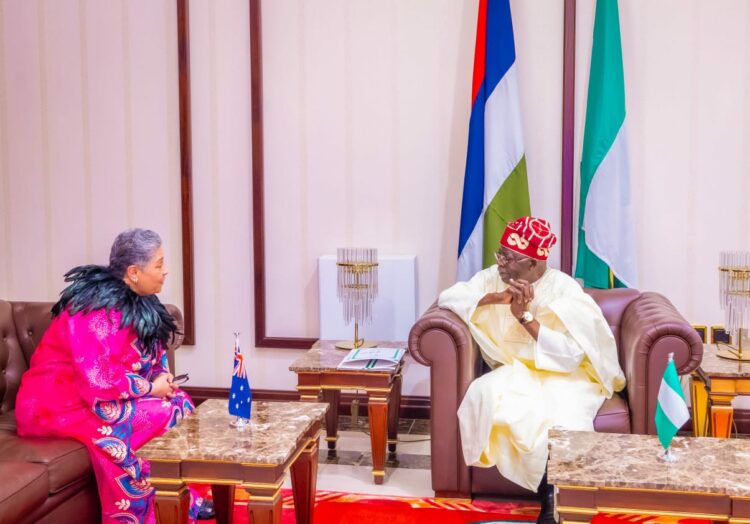
L-R: New High Commissioner of Australia to Nigeria, Leilani Bin-Juda, during a meeting with President Bola Tinubu, shortly after presenting her Letter of Credence to the President, at the State House, Abuja, on Friday.
President Bola Tinubu, on Friday, welcomed newly-appointed High Commissioners and Ambassador to Nigeria, expressing his commitment to enhancing cooperation in the areas of education, mining, culture, and tourism.
The President received Letters of Credence from the High Commissioner of Jamaica, Lincoln Downer; High Commissioner of Australia, Leilani Bin-Juda; and Ambassador of Romania, Florin Talapan, at the State House, Abuja.
During separate meetings with new Envoys, President Tinubu, in a statement by his spokesman, Ajuri Ngelale, assured them of Nigeria’s support for a rewarding stay and reaffirmed his government’s commitment to maintaining an open-door policy toward strengthening existing economic, cultural, and diplomatic relations.
Speaking when he received the High Commissioner of Jamaica, President Tinubu emphasised the importance of collaboration on trade, investment, and the Technical Aids Corps.
He reiterated Nigeria’s readiness to reactivate energy cooperation with Jamaica, particularly in the context of climate change and the utilization of gas as a transition fuel.
”The essence of a relationship is to understand one another. With Nigeria’s energetic and talented youth, we have a cultural affinity with Jamaica and a lot of potential for cooperation in the areas of culture and tourism that will benefit the youth populations of both countries,” the President said.

JUST-IN: Kano Assembly Member Dies At 59

WHD 2024: Prioritise Health As Basic Right For All, Lawan Urges Federal Gov’t

PICTORIAL: First Lady Remi Tinubu, Govs, Ministers Attend Sanwo-Olu’s Daughter’s Wedding

Kogi Attack: Survivors Desert Village, Seek Govt’s Intervention
The Jamaican High Commissioner conveyed his Prime Minister’s willingness for cooperation between Nigeria and Jamaica in various fields, such as energy, trade and investment, culture, and tourism.
He announced plans for a Jamaican business delegation to visit Nigeria later this year and invited Nigerian investors to explore opportunities in Jamaica’s special economic zones.
During the meeting with the High Commissioner of Australia to Nigeria, President Tinubu expressed appreciation for the longstanding relationship between Nigeria and Australia.
He acknowledged the shared values and interests between Nigeria and Australia as active members of the United Nations, the Commonwealth, and other multilateral institutions.
Acutely aware of Australia’s world-leading position in iron ore export, the President emphasised the importance of strengthening cooperation in mining, following recent initiatives by the Minister of Solid Minerals Development, Dr. Dele Alake, to deepen ties between the two nations concerning developments in the sector.
“The Minister of Solid Minerals was in Australia recently, and we look forward to further collaboration in this area. We are also ready to deepen our mutual cooperation in the area of education,” President Tinubu stated.
The Australian High Commissioner expressed enthusiasm for further collaboration during her tenure in Nigeria.
“I am the first Australian indigenous person to be appointed High Commissioner to Nigeria. I have been here for five months, and I love Nigeria. I love the people. I am sure my tenure here will be extremely fruitful for both sides,” the High Commissioner told the President.
The Australian High Commissioner extended an invitation to President Tinubu to consider visiting Australia during the Commonwealth Heads of Government Meeting (CHOGM) in Samoa.
Also, during the meeting with the Romanian Ambassador, President Tinubu assured the ambassador that Nigeria will explore more opportunities for collaboration with the EU-member country.
The Romanian Ambassador expressed his commitment to strengthening ties between Nigeria and Romania, particularly in the education, energy, and defence sectors.
He announced plans to increase scholarships for prospective Nigerian students interested in studying in Romania.
“Nigeria is a second home to me, and I have lived here for many years. I have to give back every good thing I have received from Nigeria. My country is looking towards a strategic alliance with Nigeria in the areas of education, energy, and defence,” Ambassador Talapan told President Tinubu.
Jigawa Gov Suspends Commissioner Over Ramadan Feeding Programme
Olubadan-designate hale, hearty, returns to ibadan ahead coronation, you may like.

TRENDING NOW
Federal gov’t unveils new national id with payment, social service features, african fashion: unique ankara styles for every occasion, 9 dead, 30 injured in wamakko house stampede, northern elders condemn sack of yakubu pam as ncpc boss, ice spice’s sex tape ‘leaks’ on social media, new band a tariff: nerc orders automatic downgrade after 7 days non-performance, just-in: tinubu appoints 36-yr-old nwagba as new ceo for credicorp, nimet warns nigerians on heat wave, gives survival tips, step-by-step guide on how to check your electricity tariff with aedc, just-in: tinubu appoints sawyerr as nelfund md/ceo, others.
© 2024 Leadership Media Group - All Rights Reserved .

IMAGES
VIDEO
COMMENTS
Cultural Tourism: Romania is known for its rich cultural heritage, with a blend of influences from Eastern Europe, the Balkans, and the Ottoman Empire. Visitors can explore historic cities like Bucharest, Cluj-Napoca, and Sibiu, visit medieval castles and fortresses, and experience traditional Romanian folklore and customs. ...
Tourism in Romania. Romania 's tourism sector had a direct contribution of EUR 5.21 billion to the Gross Domestic Product (GDP) in 2018, slightly higher than in 2017, placing Romania on the 32nd place in the world, ahead of Slovakia and Bulgaria, but behind Greece and the Czech Republic. The total tourism sector's total contribution to Romania ...
A reasonable budget per day if you're planning to travel to Romania is between 30-60 Euro for accommodation, meals and small expenses. In restaurants a main course is around 25-50 Lei (5-10 Euro), soups around 10-20 Lei (2-4 Euro), soft drinks start from 1,5 Euro while alcohol from 2 Euro. Entrance fees to tourist attractions range between 4-15 ...
In 2023, the segment within Suceava County received the second prize in the European Cultural Tourism Network (ECTN) - Destination of Sustainable Cultural Tourism competition, in acknowledgment of its contribution to the category of Spiritual, Religious, and Pilgrimage Tourism. In 2021, in the same competition, the Cultural Tourist Route of ...
The challenge for Romania is the weak promotion of the cultural tourism due to the difficulties in developing a better infrastructure for a high accessibility to cultural attractions. The ...
In 2023, Romania's tourism sector accounted for 4.19 percent of the country's GDP. There are various relief features, such as the Carpathian Mountains, the Black Sea, the Danube Delta, and ...
You should defenitely visit tirgu mures in the centre of Romania,it has the palace of culture,the medieval fortress and many beautiful places. Reply. Elena Iuliana says. February 5, 2018 at 3:07 pm. We invite you to visit The Other Capital of Romania ! Alba Iulia represents the charming mirror in which all the ethnic groups of Transylvania can ...
In 2020, Romania's national tourism administration initiated a programme related to the recognition of cultural-touristic routes in Romania, taking into consideration the experience and knowledge gained as a member of the Enlarged Partial Agreement on Cultural Routes of the Council of Europe.
The ethnic mosaic is enhancing local culture. Discover Romania. Romania is a country of diversity. Various cultural influences have marked the evolution of this Eastern country, a country located at the intersection of Eastern and Western influences. Thus, in today's Romania, we find surprisingly different regions, starting with the economic ...
At the international and national level there is a strong connection between culture and tourism, tourism representing an important factor of the economic development by capitalizing the tourist potential of the cultural elements. Romania has a rich and valuable heritage potential with tourist attractions included on the map of European cultural routes. The challenge for Romania is the weak ...
Duncan Light, "Dracula Tourism in Romania: Cultural Identity and the State," Annals of Tourism Research, Vol. 34, Issue 3, July 2007, 746-765. Abstract: The state plays an important role in tourism development, in planning and policymaking, and also as the arbiter of cultural meanings. States choose to encourage forms of tourism that are ...
INTRODUCTION IN THE CULTURAL TOURISM IN ROMANIA. Gheorghe Gabriel Sanda. Published 2016. Sociology. Annals - Economy Series. Cultural tourism is not a new form of tourism but a growing niche product; it represents a form of economic development. This concept has emerged as a result of the interaction between tourism and culture and the ...
Introduction. This paper examines the role of the state in the development of tourism in Romania over the past four decades. There is increasing recognition that government is ever present in the character and organization of this industry (Harrop and McMillan 2002) and such involvement may take a number of forms (Elliot, 1997, Hall, 2000, Hall, 2005, Jeffries, 2001).
Importance for Romania of tourism in municipalities listed in PATN with man-made resources as dominant resource (assimilated with cultural tourism), 2001-2019
The author analyses the present state of the rural cultural tourism in Romania after consulting various publications, internal operation norms, reports and guidelines issued by non-governmental organisations in Romania, as well as documents issued by the Ministry of Entrepreneurship and Tourism in Romania. It is important to identify the ...
The dynamic interactions betwee n cultural heritage and tourism lead to its assertion as an increasingly complex economic phenomenon, with social and cultural implications. At the same time, the cultural heritage has acquired a special importance among the decision makers and local communities, being associated with major tourist attractions and the cultural means of exchange, as well as ...
OF CULTURAL TOURISM IN ROMANIA. Daniela Nicolaie, Elena Ma tei, Timothy J ohn Cooley, Iuliana V i julie, David Cushing, Mari us Nicolae T ruțescu »George Enescu« Memorial House - Sinaia ...
Culture. The culture of Romania is a unique culture, which is the product of its geography and its distinct historical evolution. more. Charity. Our plan in Romania. more. Tourism. Leisure activities available here include cultural tourism, spa therapies, horse riding and agritourism. more. Romanian Cultural Tourism.
Abstract The purpose of this paper is to present two empirical approaches of estimating/approximating the size of cultural tourism in Romania based on existing data at municipality level. These approaches have been labelled 'the potential supply approach' (based on municipalities with man-made tourism resources as dominant resource) and 'the demand approach' (based on municipalities ...
Romania - Traditions, Cuisine, Culture: Romanians' lives are generally guided by the religious traditions to which they adhere. Thus, ethnic Romanians who follow the practices of Eastern Orthodoxy participate in elaborate customs and ceremonies during Holy Week and at Easter. The Hungarian and German minorities, who generally belong to the Roman Catholic and Protestant churches, put a ...
The Ministry of Investments and European Projects launched on May 3 a new call for projects within the program envisaging the "promotion of the 12 tourist/cultural routes, Component 11 - Tourism ...
The aim of this research was to find out more about the similarities and differences that exist in entrepreneurs', tourists' and residents' behaviour and the impacts of the COVID-19 pandemic on cultural tourism in Romania, and specifically in the Buzău Carpathians and Subcarpathians.
Maramure y is one of the mountain regions of Romania where pilot projects for sustainable rural cultural tourism have been started. The paper examines the potentials for this business and evaluates progress in the context of experience elsewhere with respect to barriers that may limit growth and long-term success. The resources are very considerable both in Romania generally and Maramure y in ...
President Bola Tinubu has expressed his commitment to enhancing cooperation in the areas of education, mining, culture, and tourism.He stated this while welcoming newly-appointed ambassadors to ...
The Jamaican High Commissioner conveyed his Prime Minister's willingness for cooperation between Nigeria and Jamaica in various fields, such as energy, trade and investment, culture, and tourism.